Unsymmetrical Metallocene Catalysts And Uses Thereof
O'HARE; Dermot ; et al.
U.S. patent application number 16/099855 was filed with the patent office on 2019-04-18 for unsymmetrical metallocene catalysts and uses thereof. The applicant listed for this patent is SCG CHEMICALS CO., LTD.. Invention is credited to Jean-Charles BUFFET, Manutsavin CHARERNSUK, Sumate CHAROENCHAIDET, Tossapol KHAMNAEN, Jessica LAMB, Dermot O'HARE, Thawesak PARAWAN.
| Application Number | 20190112325 16/099855 |
| Document ID | / |
| Family ID | 56320318 |
| Filed Date | 2019-04-18 |

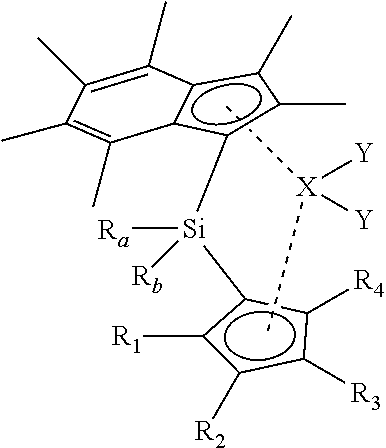
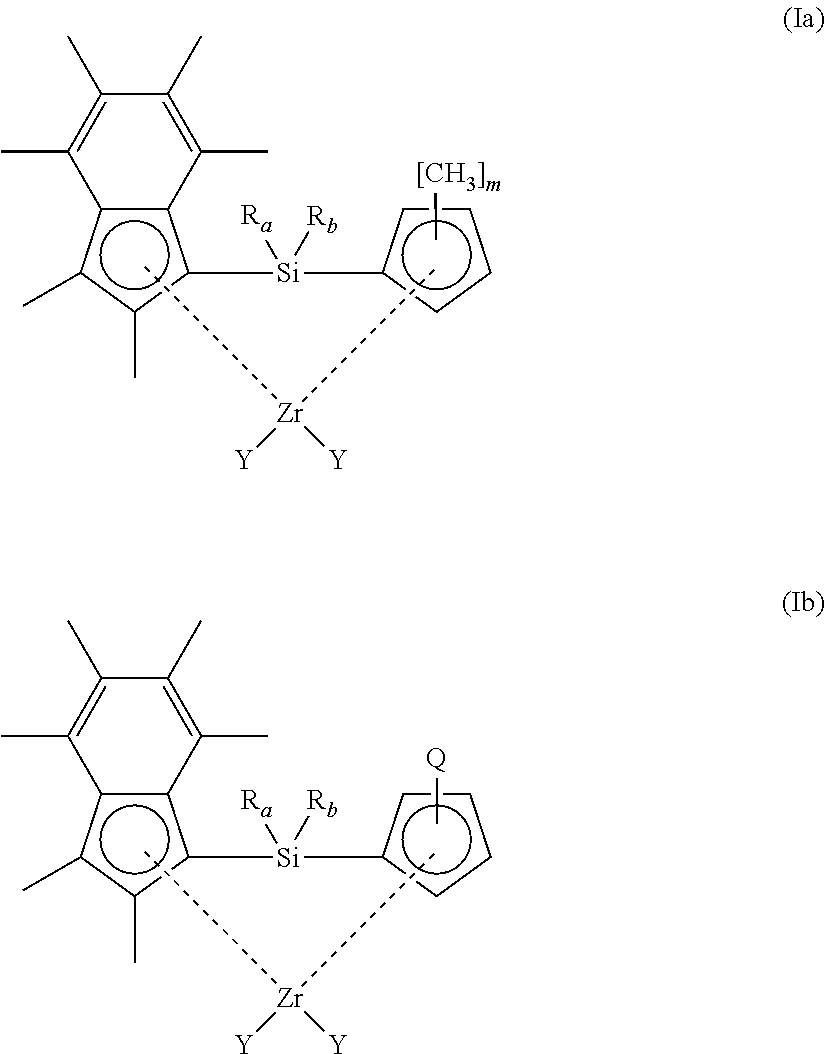
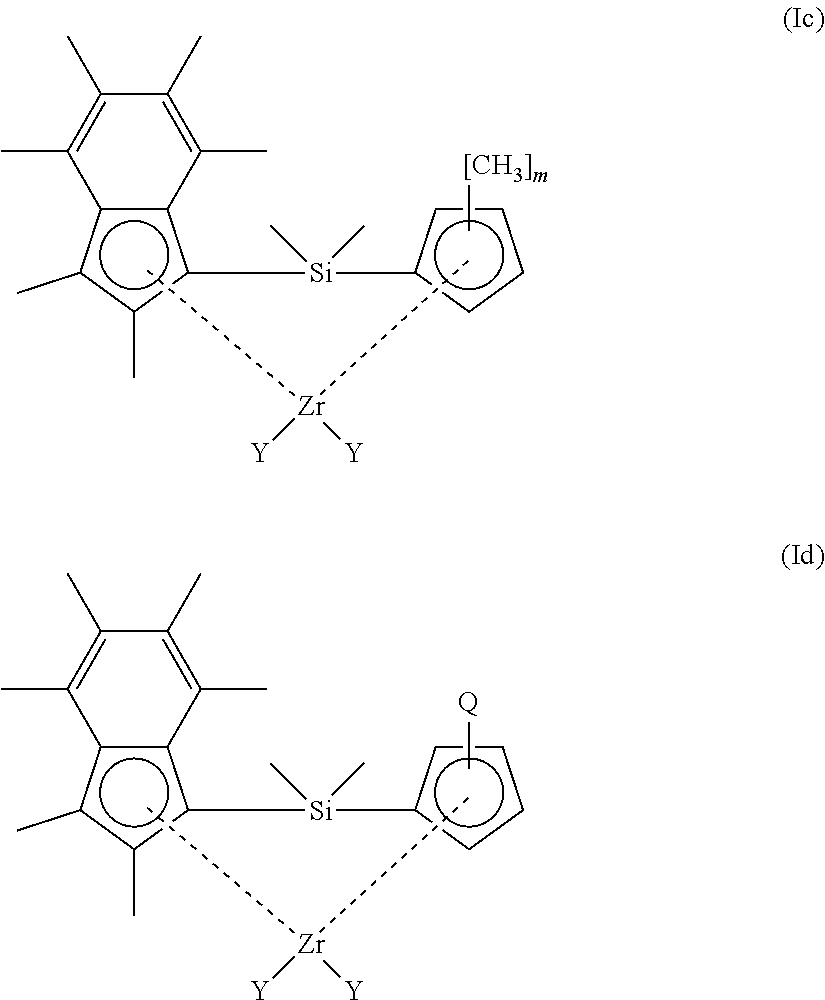
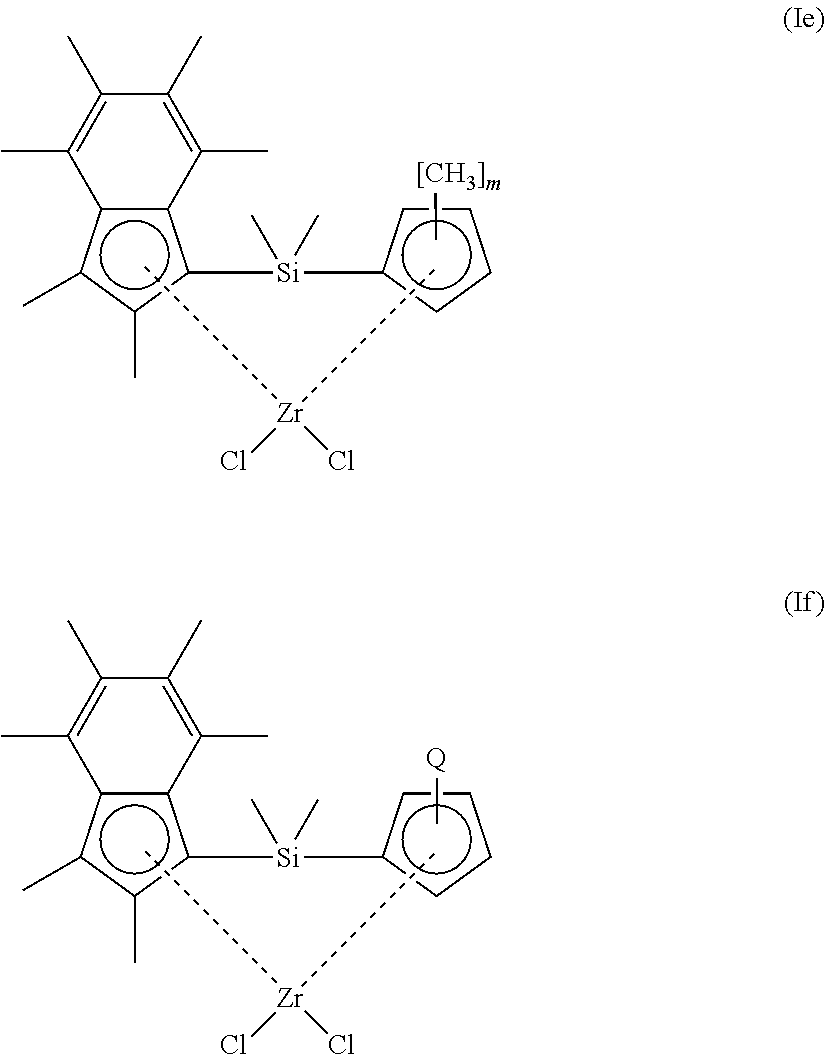

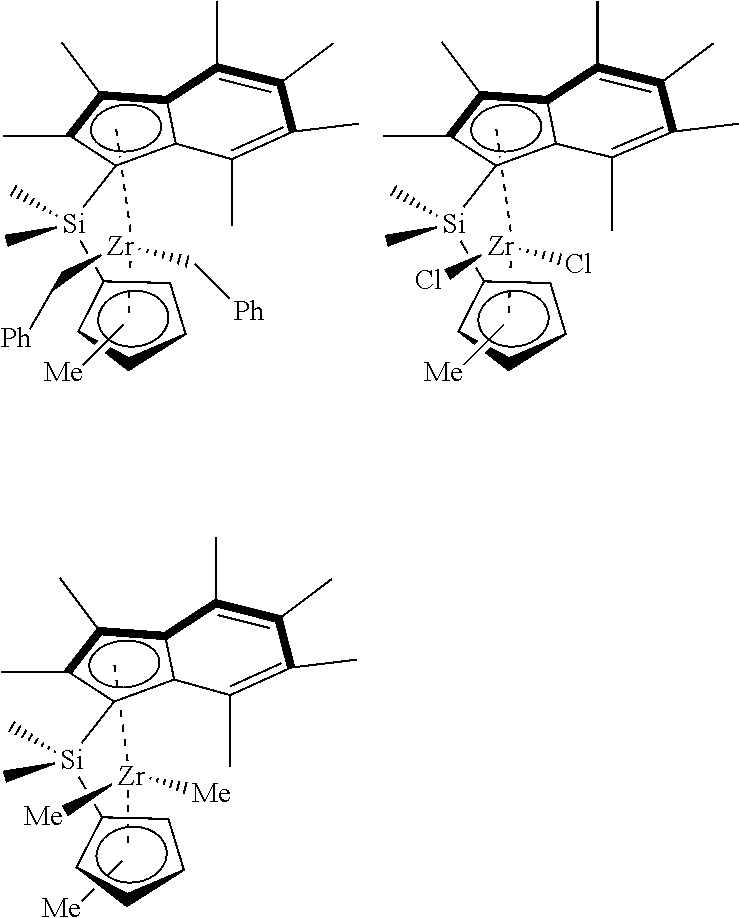
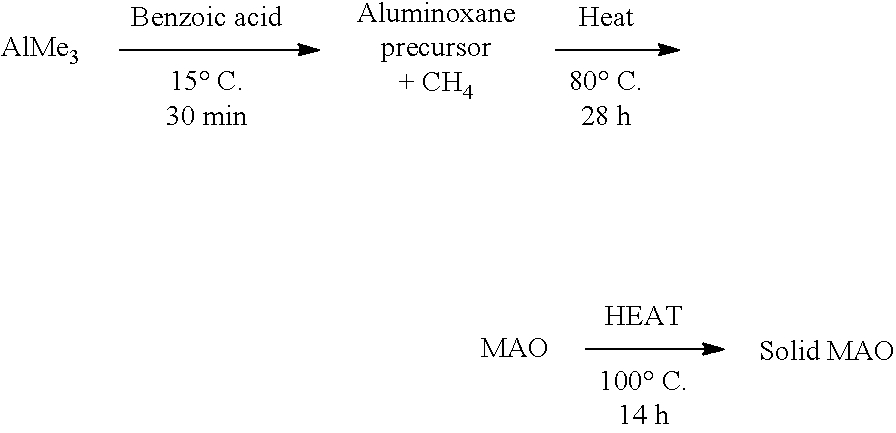
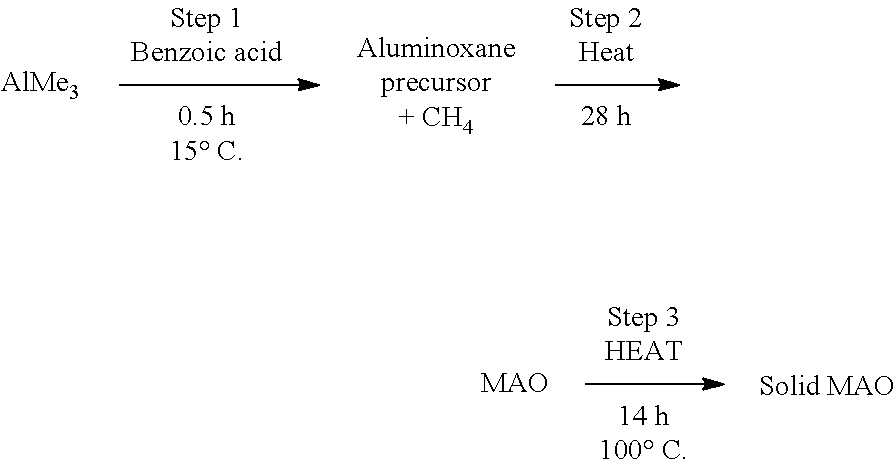
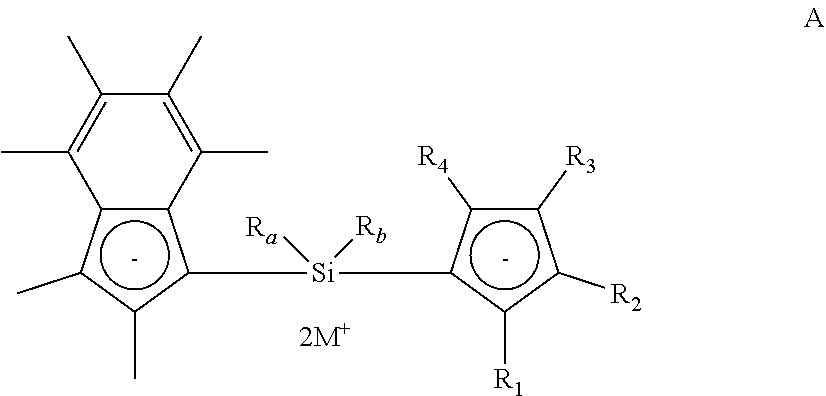
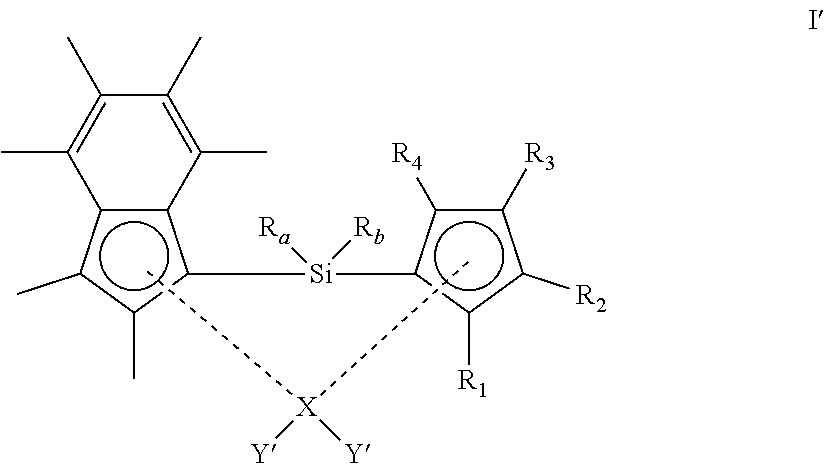
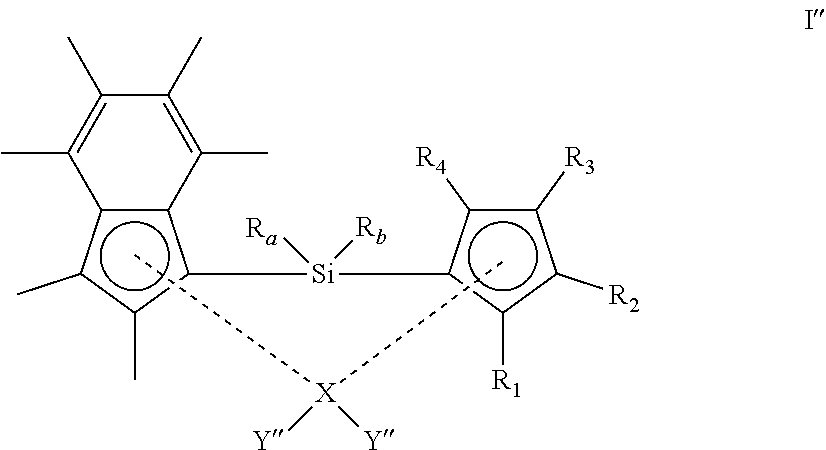
View All Diagrams
| United States Patent Application | 20190112325 |
| Kind Code | A1 |
| O'HARE; Dermot ; et al. | April 18, 2019 |
UNSYMMETRICAL METALLOCENE CATALYSTS AND USES THEREOF
Abstract
Unsymmetrical metallocene compounds based on cyclopentadienyl ligands are disclosed, as well as catalytic compositions comprising the compounds supported on solid support materials. The compounds and compositions are useful as catalysts in the polymerisation of olefins. In particular, the compounds and compositions are useful catalysts in the preparation of low molecular weight polyethylene (e.g. polyethylene wax) and copolymers formed from the polymerisation of ethylene and other .alpha.-olefins.
| Inventors: | O'HARE; Dermot; (Oxford, GB) ; BUFFET; Jean-Charles; (Oxford, GB) ; LAMB; Jessica; (Oxford, GB) ; KHAMNAEN; Tossapol; (Bangkok, TH) ; CHARERNSUK; Manutsavin; (Bangkok, TH) ; PARAWAN; Thawesak; (Bangkok, TH) ; CHAROENCHAIDET; Sumate; (Bangkok, TH) | ||||||||||
| Applicant: |
|
||||||||||
|---|---|---|---|---|---|---|---|---|---|---|---|
| Family ID: | 56320318 | ||||||||||
| Appl. No.: | 16/099855 | ||||||||||
| Filed: | May 10, 2017 | ||||||||||
| PCT Filed: | May 10, 2017 | ||||||||||
| PCT NO: | PCT/GB2017/051305 | ||||||||||
| 371 Date: | November 8, 2018 |
| Current U.S. Class: | 1/1 |
| Current CPC Class: | C08F 4/65912 20130101; C08F 4/65916 20130101; C08F 210/16 20130101; C08F 10/02 20130101; C08F 4/65927 20130101; C08F 210/16 20130101; C08F 110/02 20130101; C07F 17/00 20130101; C08F 210/14 20130101; C08F 4/65927 20130101; C08F 4/65927 20130101; C08F 110/02 20130101; C08F 2500/02 20130101 |
| International Class: | C07F 17/00 20060101 C07F017/00; C08F 10/02 20060101 C08F010/02 |
Foreign Application Data
| Date | Code | Application Number |
|---|---|---|
| May 12, 2016 | GB | 1608384.2 |
Claims
1. A compound of formula (I) shows below: ##STR00023## wherein R.sub.1, R.sub.2, R.sub.3 and R.sub.4 are each independently selected from hydrogen and (1-4C)alkyl; R.sub.a and R.sub.b are each independently (1-4C)alkyl; X is zirconium or hafnium; and each Y is independently selected from halo, phenyl, aryl(1-2C)alkyl, or (CH.sub.2).sub.zSi(CH.sub.3).sub.3, any of which is optionally substituted with one or more (1-3C)alkyl or halo; wherein z is 1, 2 or 3; or each Y is independently chloro, methyl, propyl, neopentyl, phenyl, benzyl, and --CH.sub.2Si(CH.sub.3).sub.3; with the proviso that at least one of R.sub.1, R.sub.2, R.sub.3 and R.sub.4 is not hydrogen.
2. The compound of claim 1, wherein each Y is independently chloro, methyl, propyl, neopentyl, phenyl, benzyl, and --CH.sub.2Si(CH.sub.3).sub.3.
3. The compound of claim 1, wherein at least one Y group is chloro, methyl or benzyl.
4. The compound of claim 1, wherein both Y groups are chloro, methyl or benzyl.
5.-12. (canceled)
13. The compound of claim 1, wherein the compound of formula (I) has a structure according to formula (Ia) or (Ib) shown below: ##STR00024## wherein R.sub.a and R.sub.b are each independently (1-4C)alkyl; each Y is independently selected from halo, phenyl, aryl(1-2C)alkyl, or (CH.sub.2).sub.zSi(CH.sub.3).sub.3, any of which is optionally substituted with one or more (1-3C)alkyl or halo; m is 1, 2, 3, or 4; and Q is n-butyl or t-butyl.
14. (canceled)
15. (canceled)
16. The compound of claim 1, wherein the compound has a structure according to formula (Ie) or (If) shown below: ##STR00025## wherein m is 1, 2 3 or 4; and Q is n-butyl or t-butyl.
17. (canceled)
18. (canceled)
19. The compound of claim 1, wherein the compound has any one of the following structures: ##STR00026##
20. A composition comprising a compound of formula (I) of claim 1, and a support material.
21. The composition of claim 20, wherein the support material is solid MAO.
22. The composition of claim 21, wherein the mole ratio of support material to the compound of formula (I) is 50:1 to 500:1.
23.-27.
28. A polymerisation process comprising the step of: a) polymerising one or more olefins in the presence of: i. the composition of claim 20.
29. The process of claim 28, wherein the one or more olefins is ethylene.
30. The process of claim 29, wherein during step a), ethylene is polymerised in the presence of: ii. hydrogen.
31. The process of claim 30, wherein the mole ratio of hydrogen to ethylene in step a) ranges from 0.005:1 to 0.08:1.
32. (canceled)
33. (canceled)
34. The process of claim 28, wherein the one or more olefins is ethylene and one or more (3-8C).alpha.-olefin.
35. The process of claim 34, wherein the quantity of the one or more (3-8C).alpha.-olefin, relative to the quantity of ethylene, is 0.05-10 mol %.
36.-38. (canceled)
39. The process of claim 34, where step a) is conducted in the presence of one of more compounds selected from triethyl aluminium, methyl aluminoxane, trimethyl aluminium and triisobutyl aluminium.
40. A polymerisation process comprising the step of: a) polymerising ethylene in the presence of: i. a composition comprising solid MAO and a compound according to formula (II) shown below ##STR00027## wherein X is zirconium or hafnium; and ii. hydrogen; wherein the mole ratio of hydrogen to ethylene in step a) ranges from 0.0365:1 to 0.3:1.
41. (canceled)
42. (canceled)
43. The process of claim 40, wherein the mole ratio of solid MAO to the compound of formula (II) is 125:1 to 400:1.
44. (canceled)
45. (canceled)
46. The process of claim 40, where step a) is conducted in the presence of one of more compounds selected from triethyl aluminium, methyl aluminoxane, trimethyl aluminium and triisobutyl aluminium.
Description
INTRODUCTION
[0001] The present invention relates to unsymmetrical metallocene catalysts, their methods of preparation, and their use in catalysing the polymerisation of olefins.
BACKGROUND OF THE INVENTION
[0002] It is well known that ethylene (and .alpha.-olefins in general) can be readily polymerized at low or medium pressures in the presence of certain transition metal catalysts. These catalysts are generally known as Zeigler-Natta type catalysts.
[0003] A particular group of these Ziegler-Natta type catalysts, which catalyse the polymerisation of ethylene (and .alpha.-olefins in general), comprise an aluminoxane activator and a metallocene transition metal catalyst. Metallocenes comprise a metal bound between two .eta..sup.5-cyclopentadienyl type ligands. Generally the .eta..sup.5-cyclopentadienyl type ligands are selected from .eta..sup.5-cyclopentadienyl, .eta..sup.5-indenyl and .eta..sup.5-fluorenyl.
[0004] It is also well known that these .eta..sup.5-cyclopentadienyl type ligands can be modified in a myriad of ways. One particular modification involves the introduction of a linking group between the two cyclopentadienyl rings to form ansa-metallocenes.
[0005] Numerous ansa-metallocenes of transition metals are known in the art. However, there remains a need for improved ansa-metallocene catalysts for use in polyolefin polymerisation reactions. In particular, there remains a need for new metallocene catalysts with high polymerisation activities/efficiencies.
[0006] There is also a need for catalysts that can produce polyethylenes with particular characteristics. For example, catalysts capable of producing linear high density polyethylene (LHDPE) with a relatively narrow dispersion in polymer chain length are desirable. In addition, there is a need for catalysts capable of producing lower molecular weight polyethylene, including polyethylene wax. Moreover, there is a need for catalysts that can produce polyethylene copolymers having good co-monomer incorporation and good intermolecular uniformity of polymer properties.
[0007] WO2011/051705 discloses ansa-metallocene catalysts based on two .eta..sup.5-indenyl ligands linked via an ethylene group.
[0008] WO2015/159073 discloses ansa-metallocene catalysts based on two .eta..sup.5-indenyl ligands linked via a silylene group.
[0009] In spite of the advances made by the aforementioned technologies, there remains a need for ansa-metallocene catalysts having improved polymerisation activity. Moreover, due to the high value that industry places on such materials, there is also a need for ansa-metallocene catalysts capable of catalyzing the preparation of lower molecular weight polyethylene, including polyethylene wax. It is even further desirable that such catalysts can be easily synthesised.
[0010] The present invention was devised with the foregoing in mind.
SUMMARY OF THE INVENTION
[0011] According to a first aspect of the present invention there is provided a compound according to formula (I) defined herein.
[0012] According to a second aspect of the present invention there is provided a composition comprising a compound of formula (I) defined herein and a support material.
[0013] According to a third aspect of the present invention there is provided a use of a compound of formula (I) defined herein or a composition defined herein in the polymerisation of one or more olefins.
[0014] According to a fourth aspect of the present invention there is provided a polymerisation process comprising the step of: [0015] a) polymerising one or more olefins in the presence of: [0016] i. a composition as defined herein.
[0017] According to a fifth aspect of the present invention there is provided a polymerisation process comprising the step of: [0018] a) polymerising ethylene in the presence of: [0019] i. a composition comprising solid MAO and a compound according to formula (II) defined herein; and [0020] ii. hydrogen; wherein the mole ratio of hydrogen to ethylene in step a) ranges from 0.0365:1 to 0.3:1.
DETAILED DESCRIPTION OF THE INVENTION
Definitions
[0021] The term "(m-nC)" or "(m-nC) group" used alone or as a prefix, refers to any group having m to n carbon atoms
[0022] The term "alkyl" as used herein includes reference to a straight or branched chain alkyl moieties, typically having 1, 2, 3, 4, 5 or 6 carbon atoms. This term includes reference to groups such as methyl, ethyl, propyl (n-propyl or isopropyl), butyl (n-butyl, sec-butyl or tert-butyl), pentyl (including neopentyl), hexyl and the like. In particular, an alkyl may have 1, 2, 3 or 4 carbon atoms.
[0023] The term "aryl" as used herein includes reference to an aromatic ring system comprising 6, 7, 8, 9 or 10 ring carbon atoms. Aryl is often phenyl but may be a polycyclic ring system, having two or more rings, at least one of which is aromatic. This term includes reference to groups such as phenyl, naphthyl and the like.
[0024] The term "aryl(m-nC)alkyl" means an aryl group covalently attached to a (m-nC)alkylene group. Examples of aryl-(m-nC)alkyl groups include benzyl, phenylethyl, and the like.
[0025] The term "halogen" or "halo" as used herein includes reference to F, Cl, Br or I. In a particular, halogen may be F or Cl, of which Cl is more common.
[0026] The term "substituted" as used herein in reference to a moiety means that one or more, especially up to 5, more especially 1, 2 or 3, of the hydrogen atoms in said moiety are replaced independently of each other by the corresponding number of the described substituents. The term "optionally substituted" as used herein means substituted or unsubstituted.
[0027] It will, of course, be understood that substituents are only at positions where they are chemically possible, the person skilled in the art being able to decide (either experimentally or theoretically) without inappropriate effort whether a particular substitution is possible. For example, amino or hydroxy groups with free hydrogen may be unstable if bound to carbon atoms with unsaturated (e.g. olefinic) bonds. Additionally, it will of course be understood that the substituents described herein may themselves be substituted by any substituent, subject to the aforementioned restriction to appropriate substitutions as recognised by the skilled person.
Compounds of the Invention
[0028] As described hereinbefore, the present invention provides a compound of formula (I) shows below:
##STR00001##
[0029] wherein [0030] R.sub.1, R.sub.2, R.sub.3 and R.sub.4 are each independently selected from hydrogen and (1-4C)alkyl; [0031] R.sub.a and R.sub.b are each independently (1-4C)alkyl; [0032] X is zirconium or hafnium; and [0033] each Y is independently selected from halo, phenyl, aryl(1-2C)alkyl, or (CH.sub.2).sub.zSi(CH.sub.3).sub.3, any of which is optionally substituted with one or more (1-3C)alkyl or halo; [0034] wherein z is 1, 2 or 3; with the proviso that at least one of R.sub.1, R.sub.2, R.sub.3 and R.sub.4 is not hydrogen.
[0035] It will be appreciated that the structural formula (I) presented above is intended to show the substituent groups in a clear manner. A more representative illustration of the spatial arrangement of the groups is shown in the alternative representation below:
##STR00002##
[0036] It will also be appreciated that when substituents R.sub.1 and R.sub.2 are not identical to substituents R.sub.3 and R.sub.4 respectively, the compounds of the present invention may be present as meso or rac isomers, and the present invention includes both such isomeric forms. It will also be appreciated that a number of other positional isomers are envisaged by formula (I), such as those present when the cyclopentadienyl ring is substituted with 1, 2 or 3 (1-4C)alkyl groups (e.g. methyl).
[0037] A person skilled in the art will appreciate that a mixture of isomers of the compound of the present invention may be used for catalysis applications, or the isomers may be separated and used individually (using techniques well known in the art, such as, for example, fractional crystallization).
[0038] If the structure of a compound of formula (I) is such that rac and meso isomers do exist, the compound may be present in the rac form only, or in the meso form only.
[0039] When compared with currently-available symmetrical cyclopentadienyl-based metallocene complexes, the unsymmetrical cyclopentadienyl-based ansa-metallocene compounds of the invention are particularly useful as catalysts in the polymerisation of olefins, notably ethylene. In particular, the compounds of the invention exhibit improved catalytic characteristics when used in the preparation of polyethylene wax, which is highly valued by industry. Moreover, the compounds of the invention exhibit improved catalytic characteristics when used in the preparation of copolymers formed from the polymerisation of ethylene and one or more other .alpha.-olefins. Copolymers produced in this manner exhibit good inter-molecular uniformity.
[0040] In an embodiment, each Y is independently selected from halo, methyl, propyl, neopentyl, phenyl, benzyl, and CH.sub.2Si(CH.sub.3).sub.3. Suitably, each Y is independently selected from halo, methyl, propyl, neopentyl, phenyl and benzyl. More suitably, each Y is independently selected from halo, methyl and propyl.
[0041] In another embodiment, each Y is independently selected from halo, (1-5C)alkyl (e.g. methyl, ethyl propyl, butyl or pentyl), phenyl, benzyl, and CH.sub.2Si(CH.sub.3).sub.3. Suitably, each Y is independently selected from halo, methyl, propyl, neopentyl, phenyl and benzyl. More suitably, each Y is independently selected from halo, methyl and propyl.
[0042] In another embodiment, both Y groups are methyl.
[0043] In another embodiment, each Y is independently halo. Suitably, at least one Y group is chloro. More suitably, both Y groups are chloro.
[0044] In another embodiment, R.sub.a and R.sub.b are each independently (1-3C)alkyl.
[0045] In another embodiment, R.sub.a and R.sub.b are each independently methyl or propyl. Suitably, at least one of R.sub.a and R.sub.b is methyl. More suitably, both R.sub.a and R.sub.b are methyl. Alternatively, both R.sub.a and R.sub.b are ethyl.
[0046] In another embodiment, X is zirconium.
[0047] In another embodiment, R.sub.1, R.sub.2, R.sub.3 and R.sub.4 are each independently selected from hydrogen, methyl, n-butyl and t-butyl.
[0048] In another embodiment, the compound of formula (I) has a structure according to formula (Ia) or (Ib) shown below:
##STR00003##
[0049] wherein [0050] R.sub.a, R.sub.b and Y have any of the definitions recited hereinbefore; [0051] m is 1, 2, 3, or 4; and [0052] Q is n-butyl or t-butyl.
[0053] In an embodiment of the compounds of formula (Ia) or (Ib), R.sub.a and R.sub.b are each independently methyl or propyl. Suitably, at least one of R.sub.a and R.sub.b is methyl. More suitably, both R.sub.a and R.sub.b are methyl.
[0054] In another embodiment of the compounds of formula (Ia) or (Ib), each Y is independently selected from halo, methyl, propyl, neopentyl, phenyl, benzyl, and CH.sub.2Si(CH.sub.3).sub.3. Suitably, each Y is independently selected from halo, methyl, propyl, neopentyl, phenyl and benzyl. More suitably, each Y is independently selected from halo, methyl and propyl.
[0055] In another embodiment of the compounds of formula (Ia) or (Ib), each Y is independently halo. Suitably, at least one Y group is chloro. More suitably, both Y groups are chloro.
[0056] In another embodiment of the compounds of formula (Ia) or (Ib), at least one Y group is bromo. More suitably, both Y groups are bromo.
[0057] In another embodiment of the compounds of formula (Ia) or (Ib), both Y groups are benzyl.
[0058] In another embodiment of the compounds of formula (Ia) or (Ib), both Y groups are methyl.
[0059] In another embodiment of the compounds of formula (Ia) or (Ib), m is 1, 3 or 4. Suitably, m is 1.
[0060] In another embodiment, the compound of formula (I) has a structure according to formula (Ic) or (Id) shown below:
##STR00004##
[0061] wherein [0062] each Y independently has any of the definitions recited hereinbefore; [0063] m is 1, 2, 3, or 4; and [0064] Q is n-butyl or t-butyl.
[0065] In an embodiment of the compounds of formula (Ic) or (Id), each Y is independently selected from halo, methyl, propyl, neopentyl, phenyl, benzyl, and CH.sub.2Si(CH.sub.3).sub.3. Suitably, each Y is independently selected from halo, methyl, propyl, neopentyl, phenyl and benzyl. More suitably, each Y is independently selected from halo, methyl and propyl.
[0066] In another embodiment of the compounds of formula (Ic) or (Id), each Y is independently halo. Suitably, at least one Y group is chloro. More suitably, both Y groups are chloro.
[0067] In another embodiment of the compounds of formula (Ic) or (Id), at least one Y group is bromo. More suitably, both Y groups are bromo.
[0068] In another embodiment of the compounds of formula (Ic) or (Id), both Y groups are benzyl.
[0069] In another embodiment of the compounds of formula (Ic) or (Id), both Y groups are methyl.
[0070] In another embodiment of the compounds of formula (Ic) or (Id), m is 1, 3 or 4. Suitably, m is 1.
[0071] In another embodiment, the compound of formula (I) has a structure according to formula (Ie) or (If) shown below:
##STR00005##
[0072] wherein [0073] m is 1, 2, 3, or 4; and [0074] Q is n-butyl or t-butyl.
[0075] In an embodiment of the compounds of formula (Ie) or (If), m is 1, 3 or 4. Suitably, m is 1.
[0076] In an embodiment, the compound of formula (I) has any one of the following structures:
##STR00006##
[0077] In an embodiment the compound of formula (I) has any one of the following structures:
##STR00007##
Compositions of the Invention
[0078] As described hereinbefore, the present invention also provides a composition comprising a compound of formula (I) as defined herein and a support material.
[0079] When compared with currently-available symmetrical cyclopentadienyl-based metallocene complexes, the supported unsymmetrical cyclopentadienyl-based ansa-metallocene compounds of the invention are particularly useful as catalysts in the polymerisation of olefins, notably ethylene. In particular, the compositions of the invention exhibit improved catalytic characteristics when used in the preparation of polyethylene wax, which is highly valued by industry. Moreover, the compositions of the invention exhibit improved catalytic characteristics when used in the preparation of copolymers formed from the polymerisation of ethylene and one or more other .alpha.-olefins. Copolymers produced in this manner exhibit good inter-molecular uniformity.
[0080] In the compositions of the invention, the compound of formula (I) is immobilised on the support matter. The compound of formula (I) may be immobilized directly on support, or via a suitable linker. The compound of formula (I) may be immobilized on the support by one or more ionic or covalent interactions.
[0081] It will be understood that the support is a solid support, in the sense that it is insoluble in the conditions required for polymerisation of olefins. In an embodiment, the support is selected from silica, LDH (layered double hydroxide), solid MAO, or any other inorganic support material. Compositions comprising silica, LDH or solid MAO supports are useful as heterogeneous catalysts in the slurry-phase polymerisation or copolymerisation of olefins, especially ethylene.
[0082] Exemplary LDHs include AMO-LDH (aqueous-miscible organic solvent LDH), such as those having the formula [Mg.sub.1-xAl.sub.x(OH).sub.2].sup.x+(A.sup.n-).sub.x/n.y(H.sub.2O).w(sol- vent), in which 0.1<x>0.9; A=anion eg. CO.sub.3.sup.2-, OH.sup.-, F.sup.-, Cl.sup.-, Br.sup.-, I.sup.-, SO.sub.4.sup.2-, NO.sub.3.sup.- and PO.sub.4.sup.3-; w is a number less than 1; y is 0 or a number greater than 0 which gives compounds optionally hydrated with a stoichiometric amount or a non-stoichiometric amount of an aqueous-miscible organic solvent (AMO-solvent), such as acetone. It will be appreciated that the AMO-solvent can be exchanged for water.
[0083] Supports such as silica and AMO-LDH may be subjected to a heat treatment prior to use. An exemplary heat treatment involves heating the support to 400-600.degree. C. (for silicas) or 100-150.degree. C. (for AMO-LDHs) in a nitrogen atmosphere.
[0084] Supports such as silica and AMO-LDH may also contain a portion of methylaluminoxane (MAO). Such materials may be referred to as silica-supported MAO and LDH-supported MAO.
[0085] Supports such as silica and LDH may be used alongside a separate activator species. Suitable activator species include organo aluminium compounds (e.g. alkyl aluminium compounds). Suitably, the activator is triisobutylaluminium (TIBA).
[0086] In a particularly suitably embodiment, the support used in the composition is solid MAO. Compositions comprising solid MAO supports are particularly useful as catalysts in the preparation of polyethylene wax, which is highly valued by industry. The terms "solid MAO", "polymethylaluminoxane" and "solid polymethylaluminoxane" are used synonymously herein to refer to a solid-phase material having the general formula -[(Me)AlO].sub.n--, wherein n is an integer from 10 to 50. Any suitable solid MAO may be used.
[0087] There exist numerous substantial structural and behavioural differences between solid MAO and other (non-solid) MAOs. Perhaps most notably, solid MAO is distinguished from other MAOs as it is insoluble in hydrocarbon solvents and so acts as a heterogeneous support system. The solid MAO useful in the compositions of the invention are insoluble in toluene and hexane.
[0088] In contrast to non-solid (hydrocarbon-soluble) MAOs, which are traditionally used as an activator species in slurry polymerisation or to modify the surface of a separate solid support material (e.g. SiO.sub.2), the solid MAOs useful as part of the present invention are themselves suitable for use as solid-phase support materials, without the need for an additional activator. Hence, compositions of the invention comprising solid MAO are devoid of any other species that could be considered a solid support (e.g. inorganic material such as SiO.sub.2, Al.sub.2O.sub.3 and ZrO.sub.2). Moreover, given the dual function of the solid MAO (as catalytic support and activator species), the compositions of the invention comprising solid MAO contain no additional catalytic activator species.
[0089] In an embodiment, the solid MAO is prepared by heating a solution containing MAO and a hydrocarbon solvent (e.g. toluene), so as to precipitate solid MAO. The solution containing MAO and a hydrocarbon solvent may be prepared by reacting trimethyl aluminium and benzoic acid in a hydrocarbon solvent (e.g. toluene), and then heating the resulting mixture.
[0090] In an embodiment, the solid MAO is prepared according to the following protocol:
##STR00008##
The properties of the solid MAO can be adjusted by altering one or more of the processing variables used during its synthesis. For example, in the above-outlined protocol, the properties of the solid MAO may be adjusted by varying the Al:O ratio, by fixing the amount of AlMe.sub.3 and varying the amount of benzoic acid. Exemplary Al:O ratios are 1:1, 1.1:1, 1.2:1, 1.3:1, 1.4:1 and 1.6:1. Suitably the Al:O ratio is 1.2:1 or 1.3:1. Alternatively, the properties of the solid MAO may be adjusted by fixing the amount of benzoic acid and varying the amount of AlMe.sub.3.
[0091] In another embodiment, the solid MAO is prepared according to the following protocol:
##STR00009##
[0092] In the above protocol, steps 1 and 2 may be kept constant, with step 2 being varied. The temperature of step 2 may be 70-100.degree. C. (e.g. 70.degree. C., 80.degree. C., 90.degree. C. or 100.degree. C.). The duration of step 2 may be from 12 to 28 hours (e.g. 12, 20 or 28 hours). The duration of step 2 may be from 5 minutes to 24 hours. Step 3 may be conducted in a solvent such as toluene.
[0093] In an embodiment, the aluminium content of the solid MAO falls within the range of 36-41 wt %.
[0094] The solid MAO useful as part of the present invention is characterised by extremely low solubility in toluene and n-hexane. In an embodiment, the solubility in n-hexane at 25.degree. C. of the solid MAO is 0-2 mol %. Suitably, the solubility in n-hexane at 25.degree. C. of the solid MAO is 0-1 mol %. More suitably, the solubility in n-hexane at 25.degree. C. of the solid MAO is 0-0.2 mol %. Alternatively or additionally, the solubility in toluene at 25.degree. C. of the solid MAO is 0-2 mol %. Suitably, the solubility in toluene at 25.degree. C. of the solid MAO is 0-1 mol %. More suitably, the solubility in toluene at 25.degree. C. of the solid MAO is 0-0.5 mol %. The solubility in solvents can be measured by the method described in JP-B(KOKOKU)-H07 42301.
[0095] In a particularly suitable embodiment, the solid MAO is as described in US2013/0059990, WO2010/055652 or WO2013/146337, and is obtainable from Tosoh Finechem Corporation, Japan.
[0096] In an embodiment, the mole ratio of support material to the compound of formula (I) is 50:1 to 500:1. Suitably, the mole ratio of support material to the compound of formula (I) is 75:1 to 400:1.
[0097] In another embodiment, when X (of the compound of formula (I)) is hafnium, the mole ratio of solid MAO to the compound of formula (II) is 125:1 to 250:1.
[0098] In another embodiment, when X (of the compound of formula (I)) is zirconium, the mole ratio of solid MAO to the compound of formula (II) is 175:1 to 350:1.
[0099] In another embodiment, when X (of the compound of formula (I)) is hafnium, the mole ratio of solid MAO to the compound of formula (II) is 50:1 to 250:1.
[0100] In another embodiment, when X (of the compound of formula (I)) is zirconium, the mole ratio of solid MAO to the compound of formula (II) is 50:1 to 350:1, or alternatively 50:1 to 250:1.
Synthesis of Compounds of the Invention
[0101] Generally, the processes of preparing a compound of the present invention as defined herein comprises:
[0102] (i) reacting a compound of formula A:
##STR00010## [0103] (wherein R.sub.1, R.sub.2, R.sub.3, R.sub.4, R.sub.a and R.sub.b are each as defined hereinbefore and M is Li, Na or K) [0104] with a compound of the formula B:
[0104] X(Y').sub.4 B [0105] (wherein X is as defined hereinbefore and Y' is halo (particularly chloro or bromo)) [0106] in the presence of a suitable solvent to form a compound of formula I':
[0106] ##STR00011## [0107] and optionally thereafter: [0108] (ii) reacting the compound of formula I' above with MY'' (wherein M is as defined above and Y'' is a group Y as defined herein other than halo), in the presence of a suitable solvent to form the compound of the formula I'' shown below
##STR00012##
[0109] Suitably, M is Li in step (i) of the process defined above.
[0110] In an embodiment, the compound of formula B is provided as a solvate. In particular, the compound of formula B may be provided as X(Y').sub.4.THF.sub.p, where p is an integer (e.g. 2).
[0111] Any suitable solvent may be used for step (i) of the process defined above. A particularly suitable solvent is toluene, benzene or THF.
[0112] If a compound of formula I in which Y is other than halo is required, then the compound of formula I' above may be further reacted in the manner defined in step (ii) to provide a compound of formula I''.
[0113] Any suitable solvent may be used for step (ii) of the process defined above. A suitable solvent may be, for example, diethyl ether, toluene, THF, dichloromethane, chloroform, hexane DMF, benzene etc.
[0114] A person of skill in the art will be able to select suitable reaction conditions (e.g. temperature, pressures, reaction times, agitation etc.) for such a synthesis.
[0115] Processes by which compounds of the formula A above can be prepared are well known art. For example, a process for the synthesis of a di-sodium ethylene-bis-hexamethylindenyl ligand of formula A is described in J. Organomet. Chem., 694, (2009), 1059-1068.
[0116] Compounds of formula A may generally be prepared by:
[0117] (i) Reacting a compound of formula C
##STR00013## [0118] (wherein M is lithium, sodium, or potassium) with one equivalent of a compound having formula D shown below:
[0118] Si(R.sub.a)(R.sub.b)(Cl).sub.2 D [0119] (wherein R.sub.a and R.sub.b are as defined hereinbefore) [0120] to form the compound of the formula E shown below:
##STR00014##
[0121] (ii) Reacting the compound of formula E with a compound of formula F shown below:
##STR00015## [0122] (wherein R.sub.1, R.sub.2, R.sub.3 and R.sub.4 are as defined hereinbefore, and M is lithium, sodium or potassium).
[0123] Compounds of formulae C and F can be readily synthesized by techniques well known in the art.
[0124] Any suitable solvent may be used for step (i) of the above process. A particularly suitable solvent is THF.
[0125] Similarly, any suitable solvent may be used for step (ii) of the above process. A suitable solvent may be, for example, toluene, THF, DMF etc.
[0126] A person of skill in the art will be able to select suitable reaction conditions (e.g. temperature, pressures, reaction times, agitation etc.) for such a synthesis.
Uses of the Invention
[0127] As described hereinbefore, the present invention also provides a use of a compound of formula (I) defined herein or a composition defined herein in the polymerisation of one or more olefins.
[0128] The compounds and compositions of the invention may be used as catalysts in the preparation of a variety of polymers, including polyalkylenes (e.g. polyethylene) of varying molecular weight and copolymers. Such polymers and copolymers may be prepared by homogeneous solution-phase polymerisation (e.g. using the compounds of the invention), or heterogeneous slurry-phase polymerisation (e.g. using the compositions of the invention).
[0129] In an embodiment, the one or more olefins is ethylene. The compounds and compositions of the invention are therefore useful in the preparation of polyethylene homopolymers.
[0130] In another embodiment, the one or more olefins is ethylene, and the ethylene monomers are polymerised in the presence of hydrogen. The compounds and compositions of the invention are particularly useful in the preparation of lower molecular weight, in particular polyethylene wax. The low molecular weight polyethylenes may have a molecular weight ranging from 1000 to 30,000 Da. Alternatively, the low molecular weight polyethylenes may have a molecular weight ranging from 1000 to 25,000 Da. Alternatively still, the low molecular weight polyethylenes may have a molecular weight ranging from 1000 to 15,000 Da.
[0131] Polyethylenes having low molecular weights are highly valued in industry as a result of the unique characteristics that such materials possess. As a consequence, low molecular weight polyethylenes find use in a variety of industrial applications. Polyethylene wax is a low molecular weight polyethylene that, because of its molecular weight, exhibits wax-like physical characteristics. Polyethylene waxes may be prepared by polymerising ethylene in the presence of species capable of controlling the molecular weight of the growing polymer. Hydrogen is an effective controller of polyethylene molecular weight. Owing to their unique polymer properties, polyethylene waxes are used in industry in a diverse array of applications, ranging from lubrication to surface modification. Typically, polyethylene waxes are solid or semi-solid at room temperature, having molecular weight, Mw, of 2,000 to 10,000 Da. The compositions of the invention, in particular those comprising solid MAO as a support material, are particularly useful as catalysts in the preparation of polyethylene wax by polymerising ethylene in the presence of hydrogen.
[0132] The polyethylene wax prepared by polymerising ethylene in the presence of hydrogen and a compound or composition of the invention may have a density of 0.96-0.97 g/cm.sup.3.
[0133] In another embodiment, the one or more olefins are ethylene and one or more (3-8C).alpha.-olefin (e.g. 1-butene or 1-hexene). The compounds and compositions of the invention are therefore useful as catalysts in the preparation of copolymers formed from the polymerisation of ethylene and one or more (3-8C).alpha.-olefin. An exemplary copolymer is prepared by polymerising ethylene and 1-butene, and has a density of 0.93-0.95 g/cm.sup.3.
Methods of the Invention
[0134] As defined hereinbefore, the present invention also provides a polymerisation process comprising the step of: [0135] a) polymerising one or more olefins in the presence of: [0136] i. a compound or composition defined herein.
[0137] The compounds and compositions of the invention may be used as catalysts in the preparation of a variety of polymers, including polyalkylenes (e.g. polyethylene) of varying molecular weight and copolymers. Such polymers and copolymers may be prepared by homogeneous solution-phase polymerisation (e.g. using the compounds of the invention), or heterogeneous slurry-phase polymerisation (e.g. using the compositions of the invention).
[0138] In an embodiment, the one or more olefins is ethylene. The compounds and compositions of the invention are therefore useful in the preparation of polyethylene homopolymers.
[0139] In another embodiment, step a) involves polymerising one or more olefins in the presence of a composition defined herein. Suitably, the composition comprises solid MAO as a support material.
[0140] In another embodiment, step a) comprises polymerising ethylene in the presence of i) a composition defined herein, and ii) hydrogen. The compositions of the invention, in particular those comprising solid MAO as support material, are particularly useful as catalysts in the preparation of low molecular weight polyethylene, such as polyethylene wax. In these embodiments of the invention, hydrogen acts to control the molecular weight of the growing polyethylene, which results in polymers having a viscosity (and molecular weight) in the range observed for polyethylene waxes. As discussed hereinbefore, low molecular weight polyethylene, such as polyethylene waxes, are highly valued by industry, due to their unique properties, which make them suitable candidates for a broad arrange of applications.
[0141] In embodiments where step a) comprises polymerising ethylene in the presence of i) a composition defined herein, and ii) hydrogen, any suitable mole ratio of hydrogen to ethylene many be used. In an embodiment, the mole ratio of hydrogen to ethylene ranges from 0.001:1 to 0.3:1 (0.1 mol % to 30 mol % hydrogen in ethylene feed stream). Alternatively, the mole ratio of hydrogen to ethylene ranges from 0.001:1 to 0.15:1. Alternatively still, the mole ratio of hydrogen to ethylene ranges from 0.001:1 to 0.1:1. Alternatively still, the mole ratio of hydrogen to ethylene ranges from 0.005:1 to 0.08:1. Alternatively still, the mole ratio of hydrogen to ethylene ranges from 0.01:1 to 0.08:1. In a particular embodiment, the mole ratio of hydrogen to ethylene ranges from 0.03:1 to 0.05:1. In another particular embodiment, the mole ratio of hydrogen to ethylene ranges from 0.005:1 to 0.05:1.
[0142] In those embodiments where step a) comprises polymerising ethylene in the presence of i) a composition defined herein, and ii) hydrogen, step a) may be conducted at a temperature of 30-120.degree. C.
[0143] In those embodiments where step a) comprises polymerising ethylene in the presence of i) a composition defined herein, and ii) hydrogen, step a) may be conducted at a pressure of 1-10 bar.
[0144] In those embodiments where step a) comprises polymerising ethylene in the presence of i) a composition defined herein, and ii) hydrogen, step a) may be conducted for between 1 minute and 5 hours. Suitably, step a) may be conducted for between 5 minutes and 2 hours.
[0145] In another embodiment, the one or more olefins is ethylene and one or more .alpha.-olefins (e.g. 1-butene or 1-hexene). The compounds and compositions of the invention are therefore useful as catalysts in the preparation of copolymers formed from the polymerisation of ethylene and one or more (3-8C).alpha.-olefin.
[0146] In those embodiments where ethylene is copolymerised with one or more .alpha.-olefins, the quantity of the one or more (3-8C).alpha.-olefin, relative to the quantity of ethylene, is 0.05-10 mol %. Suitably, the quantity of the one or more (3-8C).alpha.-olefin, relative to the quantity of ethylene, is 0.05-5 mol %. More suitably, the quantity of the one or more (3-8C).alpha.-olefin, relative to the quantity of ethylene, is 0.05-2 mol %.
[0147] In those embodiments where ethylene is copolymerised with one or more .alpha.-olefins, step a) may be conducted at a temperature of 30-120.degree. C.
[0148] In those embodiments where ethylene is copolymerised with one or more .alpha.-olefins, step a) may be conducted at a pressure of 1-10 bar.
[0149] In those embodiments where ethylene is copolymerised with one or more .alpha.-olefins, step a) may be conducted for between 1 minute and 5 hours. Suitably, step a) may be conducted for between 5 minutes and 2 hours.
[0150] In an embodiment, step a) is conducted in the presence of one of more compounds selected from triethyl aluminium, methyl aluminoxane, trimethyl aluminium and triisobutyl aluminium. Suitably, step a) is conducted in the presence of triisobutyl aluminium or triethyl aluminium.
[0151] As described hereinbefore, the present invention also provides a polymerisation process comprising the step of: [0152] a) polymerising ethylene in the presence of: [0153] i. a composition comprising solid MAO and a compound according to formula (II) shown below
[0153] ##STR00016## [0154] wherein X is zirconium or hafnium; and [0155] ii. hydrogen; wherein the mole ratio of hydrogen to ethylene in step a) ranges from 0.0365 to 0.3:1.
[0156] The process of the invention, employing unsymmetrical unsubstituted cyclopentadienyl-based ansa-metallocenes of formula (II), results in the formation of low molecular weight polyethylene, such as polyethylene wax, having particularly advantageous properties. In particular, processes employing the compounds of formula (II) can be used to produce polyethylene wax having especially low molecular weights (in the range of 2000 to 10000 Da).
[0157] Polyethylenes (e.g. polyethylene waxes) produced by a process employing compounds of formula (II) may have a molecular weight, M.sub.w, lower than 5000 Da. Alternatively, the polyethylene (e.g. polyethylene waxes) produced by a process employing compounds of formula (II) may have a molecular weight, M.sub.w, lower than 3000 Da.
[0158] In an embodiment, the mole ratio of hydrogen to ethylene in step a) ranges from 0.0365:1 to 0.1:1. Suitably, the mole ratio of hydrogen to ethylene in step a) ranges from 0.0365:1 to 0.08:1. More suitably, the mole ratio of hydrogen to ethylene in step a) ranges from 0.038:1 to 0.06:1. Most suitably, the mole ratio of hydrogen to ethylene in step a) ranges from 0.04:1 to 0.055:1.
[0159] In another embodiment, step a) is conducted at a temperature of 30-120.degree. C.
[0160] In another embodiment, step a) is conducted at a pressure of 1-10 bar.
[0161] In an embodiment, in step a), the mole ratio of solid MAO to the compound of formula (II) is 50:1 to 400:1
[0162] In another embodiment, in step a), the mole ratio of solid MAO to the compound of formula (II) is 125:1 to 400:1. Suitably, when X (in the compound of formula (II)) is hafnium, the mole ratio of solid MAO to the compound of formula (II) is 125:1 to 250:1. Suitably, when X (in the compound of formula (II)) is zirconium, the mole ratio of solid MAO to the compound of formula (II) is 175:1 to 350:1. Most suitably, X (in the compound of formula (II)) is zirconium, and the mole ratio of solid MAO to the compound of formula (II) is 175:1 to 225:1.
[0163] In another embodiment, when X (in the compound of formula (II)) is zirconium, the mole ratio of solid MAO to the compound of formula (II) is 250:1 to 350:1.
[0164] In an embodiment, step a) is conducted in the presence of one of more compounds selected from triethyl aluminium, methyl aluminoxane, trimethyl aluminium and triisobutyl aluminium. Suitably, step a) is conducted in the presence of triisobutyl aluminium or triethyl aluminium.
[0165] Examples of the invention will now be described, for the purpose of illustration only, with reference to the accompanying figures, in which:
[0166] FIG. 1 shows the .sup.1H NMR spectrum of .sup.Me.sup.2SB(Cp.sup.Me,I*)ZrCl.sub.2 (298 K, 400 MHz, chloroform-d.sub.1).
[0167] FIG. 2 shows the .sup.1H NMR spectrum of .sup.Me.sup.2SB(Cp.sup.nBu,I*)ZrCl.sub.2 (298 K, 400 MHz, chloroform-d.sub.1).
[0168] FIG. 3 shows activity vs temperature of polymerisation of ethylene using solid MAO supported/.sup.Me.sup.2SB(Cp,I*)ZrCl.sub.2: [Al].sub.0/[Zr].sub.0=300 (black square), [Al].sub.0/[Zr].sub.0=200 (red circle), [Al].sub.0/[Zr].sub.0=150 (blue triangle) and [Al].sub.0/[Zr].sub.0=100 (inverted pink triangle). Polymerisation conditions: 10 mg of catalyst, 50 mL hexanes, 2 bar, 30 minutes, and 150 mg of TIBA.
[0169] FIG. 4 shows activity vs time of polymerisation of ethylene using solid MAO supported/.sup.Me.sup.2SB(Cp,I*)ZrCl.sub.2: [Al].sub.0/[Zr].sub.0=300 (black square), [Al].sub.0/[Zr].sub.0=200 (red circle), [Al].sub.0/[Zr].sub.0=150 (blue triangle) and [Al].sub.0/[Zr].sub.0=300 (inverted pink triangle). Polymerisation conditions: 10 mg of catalyst, 50 mL hexanes, 2 bar, 70.degree. C., and 150 mg of TIBA.
[0170] FIG. 5 shows activity vs temperature of polymerisation of ethylene using solid MAO supported/.sup.Me.sup.2SB(Cp,I*)HfCl.sub.2: [Al].sub.0/[Zr].sub.0=200 (black square), [Al].sub.0/[Zr].sub.0=150 (red circle), and [Al].sub.0/[Zr].sub.0=100 (blue triangle). Polymerisation conditions: 10 mg of catalyst, 50 mL hexanes, 2 bar, 30 minutes, and 150 mg of TIBA.
[0171] FIG. 6 shows activity vs time of polymerisation of ethylene using solid MAO supported/.sup.Me.sup.2SB(Cp,I*)HfCl.sub.2: [Al].sub.0/[Zr].sub.0=200 (black square), [Al].sub.0/[Zr].sub.0=150 (red circle), and [Al].sub.0/[Zr].sub.0=100 (blue triangle). Polymerisation conditions: 10 mg of catalyst, 50 mL hexanes, 2 bar, 30 minutes, and 150 mg of TIBA.
[0172] FIG. 7 shows Productivity vs temperature for solid MAO supported/.sup.Me.sup.2SB(Cp,I*)ZrCl.sub.2: [Al].sub.0/[Zr].sub.0=300 (black square), [Al].sub.0/[Zr].sub.0=200 (red circle), [Al].sub.0/[Zr].sub.0=150 (blue triangle) and [Al].sub.0/[Zr].sub.0=100 (inverted pink triangle). Polymerisation conditions: 10 mg of catalyst, 50 mL hexanes, 2 bar, 30 minutes, and 150 mg of TIBA.
[0173] FIG. 8 shows Productivity vs temperature for solid MAO supported/.sup.Me.sup.2SB(Cp,I*)HfCl.sub.2: [Al].sub.0/[Zr].sub.0=300 (black square), [Al].sub.0/[Zr].sub.0=200 (red circle), [Al].sub.0/[Zr].sub.0=150 (blue triangle) and [Al].sub.0/[Zr].sub.0=100 (inverted pink triangle). Polymerisation conditions: 10 mg of catalyst, 50 mL hexanes, 2 bar, 30 minutes, and 150 mg of TIBA.
[0174] FIG. 9 shows productivity (black, left vertical axis) and molecular weights (blue, right vertical axis) vs H.sub.2 content used as co-feed using solid MAO supported/.sup.Me2SB(Cp,I*)ZrCl.sub.2 with [Al].sub.0/[Zr].sub.0 ratio of 200 (square), 150 (circle) and 100 (triangle). Polymerisation conditions: 0.05 mg of catalyst, 5 mL heptane, 8 bar and 80.degree. C.
[0175] FIG. 10 shows Molecular weights, M.sub.w, (horizontal axis) for the homopolymerisation and PE wax formation using Solid MAO/.sup.Me2SB(Cp,I*)ZrCl.sub.2 catalyst using various [Al].sub.0/[Zr].sub.0 ratio. Polymerisation conditions: 0.05 mg of catalyst, 5 mL heptane, 8 bar and 80.degree. C.
[0176] FIG. 11 shows uptake rate of ethylene for ethylene polymerisation with hydrogen response using Solid MAO/.sup.Me2SB(Cp,I*)ZrCl.sub.2 catalyst using [Al].sub.0/[Zr].sub.0 ratio of 100 (left) and 150 (right). Polymerisation conditions: 0.05 mg of catalyst, 5 mL heptane, 8 bar and 80.degree. C.
[0177] FIG. 12 shows molecular weights, M.sub.w, of ethylene polymerisation with hydrogen response using Solid MAO/.sup.Me2SB(Cp,I*)ZrCl.sub.2 catalyst using [Al].sub.0/[Zr].sub.0 ratio of 100 (left) and 150 (right). Polymerisation conditions: 0.05 mg of catalyst, 5 mL heptane, 8 bar and 80.degree. C.
[0178] FIG. 13 shows uptake rate of ethylene for copolymerisation of ethylene and 1-hexene; using Solid MAO/.sup.Me2SB(Cp,I*)ZrCl.sub.2 catalyst using [Al].sub.0/[Zr].sub.0 ratio of 100 (left) and 150 (right). Polymerisation conditions: 0.05 mg of catalyst, 5 mL heptane, 8 bar and 80.degree. C.
[0179] FIG. 14 shows molecular weights, M.sub.w, for copolymerisation of ethylene and 1-hexene using Solid MAO/.sup.Me2SB(Cp,I*)ZrCl.sub.2 catalyst using [Al].sub.0/[Zr].sub.0 ratio of 100 (left) and 150 (right). Polymerisation conditions: 0.05 mg of catalyst, 5 mL heptane, 8 bar and 80.degree. C.
[0180] FIG. 15 shows CEF traces for the copolymerisation of ethylene and 1-hexene using Solid MAO/.sup.Me2SB(Cp,I*)ZrCl.sub.2 catalyst using [Al].sub.0/[Zr].sub.0 ratio of 100 (left) and 150 (right). Polymerisation conditions: 0.05 mg of catalyst, 5 mL heptane, 8 bar and 80 CC.
[0181] FIG. 16 shows the .sup.1H NMR spectrum of two isomers of .sup.Me.sup.2SB(Cp.sup.Me,I*)ZrCl.sub.2 in a 40:60 ratio with the methyl group on the cyclopentadienyl ring (298 K, 400 MHz, benzene-d.sub.6).
[0182] FIG. 17 shows the .sup.1H NMR spectrum of one isomer of .sup.Me.sup.2SB(Cp.sup.nBu,I*)ZrCl.sub.2 with the n-butyl group on the cyclopentadienyl ring (298 K, 400 MHz, benzene-d.sub.6).
[0183] FIG. 18 shows the .sup.1H NMR spectrum of the other isomer of .sup.Me.sup.2SB(Cp.sup.nBu,I*)ZrCl.sub.2 with the n-butyl group on the cyclopentadienyl ring (298 K, 400 MHz, benzene-d.sub.6).
[0184] FIG. 19 shows the .sup.1H NMR spectrum of one isomer of .sup.Me.sup.2SB(Cp.sup.Me,I*)ZrBr.sub.2 (298 K, 400 MHz, benzene-4).
[0185] FIG. 20 shows the .sup.1H NMR spectrum of two isomers of .sup.Me.sup.2SB(Cp.sup.Me,I*)Zr(CH.sub.2Ph).sub.2 in a 40:60 ratio with the methyl group on the cyclopentadienyl ring (298 K, 400 MHz, benzene-d.sub.6).
[0186] FIG. 21 shows the .sup.1H NMR spectrum of two isomers of .sup.Me.sup.2SB(Cp.sup.Me,I*)ZrMe.sub.2 in a 40:60 ratio with the methyl group on the cyclopentadienyl ring (298 K, 400 MHz, benzene-d.sub.6).
[0187] FIG. 22 shows the crystal structures for .sup.Me.sup.2SB(Cp.sup.Me,I*)ZrCl.sub.2 and .sup.Me.sup.2SB(Cp.sup.nBu,I*)ZrCl.sub.2.
[0188] FIG. 23 shows activity vs temperature of polymerisation of ethylene using solid MAO supported/.sup.Me.sup.2SB(Cp.sup.Me,I*)ZrMe.sub.2 (circle), .sup.Me.sup.2SB(Cp.sup.Me, I*)Zr(CH.sub.2Ph).sub.2 (inverted triangle), .sup.Me.sup.2SB(Cp.sup.Me,I*)ZrCl.sub.2 (triangle). Polymerisation conditions: 10 mg of catalyst, 50 mL hexanes, 2 bar, 30 minutes, 150 mg of TIBA and [Al].sub.0/[Zr].sub.0=200.
[0189] FIG. 24 shows activity vs time of polymerisation of ethylene using solid MAO supported/.sup.Me.sup.2SB(Cp.sup.Me,I*)ZrMe.sub.2 (circle), .sup.Me.sup.2SB(Cp.sup.Me, I*)Zr(CH.sub.2Ph).sub.2 (inverted triangle), .sup.Me.sup.2SB(Cp.sup.Me,I*)ZrCl.sub.2 (triangle). Polymerisation conditions: 10 mg of catalyst, 50 mL hexanes, 2 bar, 80.degree. C., 150 mg of TIBA and [Al].sub.0/[Zr].sub.0=200.
[0190] FIG. 25 shows productivity vs temperature of polymerisation of ethylene using solid MAO supported/.sup.Me.sup.2SB(Cp.sup.Me,I*)ZrMe.sub.2 (circle), .sup.Me.sup.2SB(Cp.sup.Me,I*)Zr(CH.sub.2Ph).sub.2 (inverted triangle), .sup.Me.sup.2SB(Cp.sup.Me,I*)ZrCl.sub.2 (triangle). Polymerisation conditions: 10 mg of catalyst, 50 mL hexanes, 2 bar, 30 minutes, 150 mg of TIBA and [Al].sub.0/[Zr].sub.0=200.
[0191] FIG. 26 shows productivity vs time of polymerisation of ethylene using solid MAO supported/.sup.Me.sup.2SB(Cp.sup.Me,I*)ZrMe.sub.2 (circle), .sup.Me.sup.2SB(Cp.sup.Me, I*)Zr(CH.sub.2Ph).sub.2 (inverted triangle), .sup.Me.sup.2SB(Cp.sup.Me,I*)ZrCl.sub.2 (triangle). Polymerisation conditions: 10 mg of catalyst, 50 mL hexanes, 2 bar, 80.degree. C., 150 mg of TIBA and [Al].sub.0/[Zr].sub.0=200.
[0192] FIG. 27 shows activity vs temperature (left) and activity vs. time (right) of polymerisation of ethylene using .sup.Me.sup.2SB(Cp.sup.Me,I*)ZrCl.sub.2 supported on Solid MAO (square), MAO modified LDH, LDHMAO/Mg.sub.3AlCO.sub.3, (triangle) and MAO modified silica, ssMAO, (circle). Polymerisation conditions: 10 mg of catalyst, 50 mL hexanes, 2 bar, 150 mg of TIBA and [Al].sub.0/[Zr].sub.0=200.
[0193] FIG. 28 shows activity vs temperature (left) and activity vs. time (right) of polymerisation of ethylene using .sup.Me.sup.2SB(Cp,I*)ZrCl.sub.2 supported on Solid MAO (square), MAO modified LDH, LDHMAO/Mg.sub.3AlCO.sub.3, (triangle) and MAO modified silica, ssMAO, (circle). Polymerisation conditions: 10 mg of catalyst, 50 mL hexanes, 2 bar, 150 mg of TIBA and [Al].sub.0/[Zr].sub.0=200.
[0194] FIG. 29 shows activity vs amount of immobilised complex for polymerising ethylene using solid MAO supported/.sup.Me.sup.2SB(Cp,I*)ZrCl.sub.2. Polymerisation conditions: 10 mg of catalyst, 50 mL hexanes, 2 bar, 150 mg of TIBA, 30 min and 80 CC.
[0195] FIG. 30 shows activity vs amount of TIBA for polymerising ethylene using solid MAO supported/.sup.Me.sup.2SB(Cp,I*)ZrCl.sub.2 (square) and solid MAO supported/.sup.Me.sup.2SB(Cp.sup.Me, I*)Zr(CH.sub.2Ph).sub.2 (inverted triangle). Polymerisation conditions: 10 mg of catalyst, 50 mL hexanes, 2 bar, 30 min and 80.degree. C.
[0196] FIG. 31 shows activity vs varying activators for polymerising ethylene using solid MAO supported/.sup.Me.sup.2SB(Cp,I*)ZrCl.sub.2 and solid MAO supported/.sup.Me.sup.2SB(Cp.sup.Me,I*)Zr(CH.sub.2Ph).sub.2. Polymerisation conditions: 10 mg of catalyst, 50 mL hexanes, 2 bar, 30 min and 80 (C.
[0197] FIG. 32 shows SEM images for the polyethylene produced from solid MAO supported/.sup.Me.sup.2SB(Cp,I*)ZrCl.sub.2, .sup.Me.sup.2SB(Cp.sup.Me,I*)ZrCl.sub.2 and .sup.Me.sup.2SB(Cp,I*)HfCl.sub.2, and MAO modified LDH, LDHMAO/Mg.sub.3AlCO.sub.3, supported .sup.Me.sup.2SB(Cp,I*)ZrCl.sub.2, Polymerisation conditions: 10 mg of catalyst, 50 mL hexanes, 2 bar, 30 min and 80 CC.
[0198] FIG. 33 shows uptake rate of ethylene for ethylene polymerisation with hydrogen response using Solid MAO/.sup.Me2SB(Cp.sup.Me,I*)ZrCl.sub.2 catalyst with [Al].sub.0/[Zr].sub.0 ratio of 200. Polymerisation conditions: 0.05 mg of catalyst, 5 mL heptane, 8 bar and 80 CC.
[0199] FIG. 34 shows molecular weights, M.sub.w, of ethylene polymerisation with hydrogen response using Solid MAO/.sup.Me2SB(Cp.sup.Me,I*)ZrCl.sub.2 catalyst with [Al].sub.0/[Zr].sub.0 ratio of 200. Polymerisation conditions: 0.05 mg of catalyst, 5 mL heptane, 8 bar and 80.degree. C.
[0200] FIG. 35 shows uptake rate of ethylene for copolymerisation of ethylene and 1-hexene; using Solid MAO/.sup.Me2SB(Cp.sup.Me,I*)ZrCl.sub.2 catalyst with [Al].sub.0/[Zr].sub.0 ratio of 200. Polymerisation conditions: 0.05 mg of catalyst, 5 mL heptane, 8 bar and 80.degree. C.
[0201] FIG. 36 shows molecular weights, M.sub.w, for copolymerisation of ethylene and 1-hexene using Solid MAO/.sup.Me2SB(Cp.sup.Me,I*)ZrCl.sub.2 catalyst with [Al].sub.0/[Zr].sub.0 ratio of 200. Polymerisation conditions: 0.05 mg of catalyst, 5 mL heptane, 8 bar and 80.degree. C.
[0202] FIG. 37 shows CEF traces for the copolymerisation of ethylene and 1-hexene using Solid MAO/.sup.Me2SB(Cp.sup.Me,I*)ZrCl.sub.2 catalyst with [Al].sub.0/[Zr].sub.0 ratio of 200. Polymerisation conditions: 0.05 mg of catalyst, 5 mL heptane, 8 bar and 80.degree. C.
[0203] FIG. 38 Shows molecular weight vs temperature of polymerisation of ethylene using solid MAO supported/.sup.Me.sup.2SB(Cp.sup.Me,I*)ZrCl.sub.2. Polymerisation conditions: 10 mg of catalyst, 50 mL hexanes, 2 bar, 30 minutes, 80.degree. C., 150 mg of TIBA and [Al].sub.0/[Zr].sub.0=200.
EXAMPLES
Example 1--Synthesis of Compounds
[0204] Scheme 1a below illustrates the synthesis of various unsymmetrical .sup.Me.sup.2SB(Cp.sup.R,I*)ZrCl.sub.2 compounds of the invention (in which "SB" denotes silicon bridged, "Cp.sup.R" denotes cyclopentadienyl substituted with R, and "I*" denotes per-methyl indenyl). All the reactions were carried out in pseudo one-pot synthesis from the chloro silane synthon, Ind*SiMe.sub.2Cl, using the corresponding alkali salt in tetrahydrofuran, followed by a lithiation reaction in tetrahydrofuran and finally the complexation step using zirconium tetrachloride in benzene.
##STR00017##
[0205] FIG. 1 shows the .sup.1H NMR spectrum of .sup.Me.sup.2SB(Cp.sup.Me,I*)ZrCl.sub.2 (298 K, 400 MHz, chloroform-d.sub.1). FIG. 2 shows the .sup.1H NMR spectrum of .sup.Me.sup.2SB(Cp.sup.nBu,I*)ZrCl.sub.2 (298 K, 400 MHz, chloroform-d.sub.1). The .sup.1H NMR spectra of the bulk materials for .sup.Me.sup.2SB(Cp.sup.Me,I*)ZrCl.sub.2 and .sup.Me.sup.2SB(Cp.sup.nBu,I*)ZrCl.sub.2 demonstrated the presence of two isomers based around the cyclopentadienyl ligand.
[0206] Scheme 1b below illustrates the synthesis of various unsymmetrical .sup.Me.sup.2SB(Cp.sup.R,I*)ZrCl.sub.2 compounds of the invention (in which "SB" denotes silicon bridged, "Cp.sup.R" denotes cyclopentadienyl substituted with R, and "I*" denotes per-methyl indenyl). All the reactions were carried out in pseudo one-pot synthesis from the chloro silane synthon, Ind*SiMe.sub.2Cl, using the corresponding alkali salt in tetrahydrofuran, followed by a lithiation reaction in tetrahydrofuran and finally the complexation step using zirconium tetrachloride in benzene.
##STR00018##
[0207] FIGS. 16 to 21 shows the .sup.1H NMR spectroscopy for .sup.Me.sup.2SB(Cp.sup.Me,I*)ZrCl.sub.2, .sup.Me.sup.2SB(Cp.sup.nBu,I*), .sup.Me.sup.2SB(Cp.sup.nBu,I*)ZrCl.sub.2, .sup.Me.sup.2SB(Cp.sup.Me,I*)ZrBr.sub.2, .sup.Me.sup.2SB(Cp.sup.Me,I*)Zr(CH.sub.2Ph).sub.2 and .sup.Me.sup.2SB(Cp.sup.Me,I*)ZrMe.sub.2 at 25.degree. C. in benzene-d highlighting the resonances due to each complex. FIG. 22 shows the molecular structures for .sup.Me.sup.2SB(Cp.sup.Me,I*)ZrCl.sub.2 and .sup.Me.sup.2SB(Cp.sup.nBu,I*)ZrCl.sub.2.
Example 2--Ethylene Homopolymerisation Studies
[0208] In addition to those compounds synthesised in Example 1, .sup.Me.sup.2SB(Cp,I*)ZrCl.sub.2 and .sup.Me.sup.2SB(Cp.sup.Me,I*)HfCl.sub.2 (in which the Cp group is unsubstituted, shown below) were also prepared, which were then reacted with solid MAO at various loadings (aluminium to Hf/Zr ratio).
[0209] The solid MAO used in this Example may be prepared via an adaptation of the optimised procedure in Kaji et al. in the U.S. Pat. No. 8,404,880 B2 embodiment 1 (Scheme 1). For brevity, each synthesised solid MAO is represented as solid MAO(Step 1 Al:O ratio/Step 2 temperature in .degree. C.,time in h/Step 3 temperature in .degree. C.,time in h). Hence, the synthesis conditions outlined in Scheme 2 below would yield solid MAO(1.2/70,32/100,12).
##STR00019##
[0210] A Rotaflo ampoule containing a solution of trimethyl aluminium (2.139 g, 2.967 mmol) in toluene (8 mL) was cooled to 15.degree. C. with rapid stirring, and benzoic acid (1.509 g, 1.239 mmol) was added under a flush of N.sub.2 over a period of 30 min. Effervescence (presumably methane gas, MeH) was observed and the reaction mixture appeared as a white suspension, which was allowed to warm to room temperature. After 30 min the mixture appeared as a colourless solution and was heated in an oil bath at 70.degree. C. for 32 h (a stir rate of 500 rpm was used). The mixture obtained was a colourless solution free of gelatinous material, which was subsequently heated at 100.degree. C. for 12 h. The reaction mixture was cooled to room temperature and hexane (40 mL) added, resulting in the precipitation of a white solid which was isolated by filtration, washed with hexane (2.times.40 mL) and dried in vacuo for 3 h. Total yield=1.399 g (71% based on 40 wt % Al).
[0211] Once the solid MAO is prepared, different quantities of the various metallocene compounds were supported on it (represented by varying aluminium to Hf/Zr ratios). In the glovebox, the solid MAO and the complex are weighed out in a Schlenk tube. Toluene (50 mL) is added to the Schlenk and the reaction mixture swirled at 60.degree. C. for one hour. The coloured solid is allowed to settle from the clear, colourless solution which is decanted, and the solid is dried in vacuo (40.degree. C., 1.times.10.sup.-2 mbar). The product is scraped out in the glovebox in quantitative yield.
[0212] The catalytic properties of the solid MAO supported .sup.Me.sup.2SB(Cp,I*)ZrCl.sub.2 and .sup.Me.sup.2SB(Cp.sup.Me,I*)HfCl.sub.2 metallocenes were investigated.
##STR00020##
[0213] FIG. 3 shows the catalytic activity of various solid MAO supported .sup.Me.sup.2SB(Cp,I*)ZrCl.sub.2 compositions as a function of temperature, in the homopolymerisation of ethylene. FIG. 4 shows the catalytic activity of various solid MAO supported .sup.Me.sup.2SB(Cp,I*)ZrCl.sub.2 compositions as a function of time, in the homopolymerisation of ethylene. FIGS. 3 and 4 demonstrate that the aluminium to zirconium ratio [Al].sub.0/[Zr].sub.0 of 300 afforded the highest activity over time and temperature of polymerisation.
[0214] FIG. 5 shows the catalytic activity of various solid MAO supported .sup.Me.sup.2SB(Cp,I*)HfCl.sub.2 compositions as a function of temperature, in the homopolymerisation of ethylene. FIG. 6 shows the catalytic activity of various solid MAO supported .sup.Me.sup.2SB(Cp,I*)HfCl.sub.2 compositions as a function of time, in the homopolymerisation of ethylene. FIGS. 5 and 6 show that when solid MAO/.sup.Me.sup.2SB(Cp,I*)HfCl.sub.2 was used, the [Al].sub.0/[Zr].sub.0 of 150 demonstrated higher activity than 200:1 or 100:1 over time and temperature of polymerisation of ethylene. This suggests a partial deactivation of the catalyst with high loadings of the hafnium compound.
[0215] FIG. 7 shows the catalytic productivity of various solid MAO supported .sup.Me.sup.2SB(Cp,I*)ZrCl.sub.2 compositions as a function of temperature, in the homopolymerisation of ethylene. FIG. 8 shows the catalytic productivity of various solid MAO supported .sup.Me.sup.2SB(Cp,I*)HfCl.sub.2 compositions as a function of temperature, in the homopolymerisation of ethylene.
[0216] In addition to investigating the catalytic properties of the solid MAO supported .sup.Me.sup.2SB(Cp,I*)ZrCl.sub.2 and .sup.Me.sup.2SB(Cp.sup.M,I*)HfCl.sub.2 metallocenes, the catalytic properties of the solid MAO supported metallocenes depicted in Schemes 1a and 1b were also investigated. FIGS. 23 to 26 shows the activities and productivities for the slurry phase polymerisation of ethylene using the solid MAO supported metallocenes depicted in Schemes 1a and 1b. The figures show that .sup.Me.sup.2SB(Cp.sup.Me,I*)ZrMe.sub.2 is particularly active.
[0217] FIGS. 27 and 28 show the activities for the slurry phase polymerisation of ethylene using .sup.Me.sup.2SB(Cp.sup.Me,I*)ZrCl.sub.2 and .sup.Me.sup.2SB(Cp,I*)ZrCl.sub.2 supported on three different supports, namely solid polymethylaluminoxane (sMAO), methylaluminoxane modified layered double hydroxide (LDHMAO) and methylaluminoxane modified silica (ssMAO). These graphs demonstrate that sMAO supported complexes show the highest activities followed by LDHMAO and ssMAO.
[0218] FIG. 29 shows the various complex loading on solid polymethylaluminoxane (sMAO) for .sup.Me.sup.2SB(Cp,I*)ZrCl.sub.2, demonstrating that as expected, higher activities were obtained with lower loading of complex on the surface.
[0219] FIG. 30 shows the effect of varying the amount of triisobutylaluminium (TIBA) scavenger on the catalytic properties of solid MAO supported .sup.Me.sup.2SB(Cp.sup.Me, I*)Zr(CH.sub.2Ph).sub.2 and .sup.Me.sup.2SB(Cp,I*)ZrCl.sub.2 in the slurry phase polymerisation of ethylene, demonstrating that only a small amount of TIBA is needed to obtain the highest activity.
[0220] Table 1 below shows slurry phase ethylene polymerisation data for the solid MAO supported .sup.Me.sup.2SB(Cp.sup.Me, I*)Zr(CH.sub.2Ph).sub.2 and .sup.Me.sup.2SB(Cp,I*)ZrCl.sub.2 where the polymerisation is conducted on a larger lab scale. The data show that the activity of the catalyst increases with increasing reaction volume, but that an increasing TIBA content gives a negligible improvement in activity and productivity.
TABLE-US-00001 TABLE 1 Activity results (kg.sub.PE g.sub.CAT.sup.-1 h.sup.-1 bar.sup.-1) and productivity (kg.sub.PE g.sub.CAT.sup.-1 h.sup.-1), for the polymerisation of ethylene in slurry using .sup.Me.sup.2SB(Cp,I*)ZrCl.sub.2 and .sup.Me.sup.2SB(Cp.sup.Me,I*)Zr(CH.sub.2Ph).sub.2 supported on Solid MAO with [Al].sub.0/[Zr].sub.0 = 200. Polymerisation conditions: 10 mg of catalyst, 250 mL hexane, 2 bar and 80.degree. C. Catalyst TIBA Activity Productivity Catalyst mg mg kg.sub.PE g.sub.CAT.sup.-1 h.sup.-1 bar.sup.-1 kg.sub.PE g.sub.CAT.sup.-1 h.sup.-1 .sup.Me.sup.2SB(Cp,I*)ZrCl.sub.2 9.6 150 mg 10014 1.52 .sup.Me.sup.2SB(Cp,I*)ZrCl.sub.2 9.5 750 mg 9160 1.39 .sup.Me.sup.2SB(Cp.sup.Me,I*)Zr(CH.sub.2Ph).sub.2 9.8 150 mg 10612 1.61 .sup.Me.sup.2SB(Cp.sup.Me,I*)Zr(CH.sub.2Ph).sub.2 9.8 750 mg 11898 1.81
[0221] FIG. 31 shows the effect of varying the scavenger on the catalytic properties of solid MAO supported .sup.Me.sup.2SB(Cp.sup.Me,I*)Zr(CH.sub.2Ph).sub.2 and .sup.Me.sup.2SB(Cp,I*)ZrCl.sub.2 in the slurry phase polymerisation of ethylene, demonstrating that triethylaluminium affords the lowest overall activity. It is believed that fouling occurred when MAO was used in combination with solid MAO supported .sup.Me.sup.2SB(Cp,I*)ZrCl.sub.2 leading to low activity.
[0222] FIG. 32 shows SEM images for polyethylene synthesised using various supported metallocenes. The solid MAO supported metallocenes appear to afford the best polyethylene morphology.
[0223] FIG. 38 shows the molecular weight of polyethylene produced from solid MAO supported .sup.Me.sup.2SB(Cp.sup.M,I*)ZrCl.sub.2 as a function of polymerisation temperature.
Example 3--Low Molecular Weight Polyethylene Studies
[0224] Solid MAO supported .sup.Me.sup.2SB(Cp,I*)ZrCl.sub.2 (in which the Cp group is unsubstituted, shown below) was selected to investigate the ability of the compositions of the invention to catalyse the polymerisation of ethylene into low molecular weight polyethylene, including polyethylene wax, using hydrogen to control the molecular weight of the growing polymer chains.
##STR00021##
[0225] FIG. 9 shows the productivity (left vertical axis) and polyethylene molecular weight (right vertical axis) of various solid MAO supported .sup.Me.sup.2SB(Cp,I*)ZrCl.sub.2 compositions as a function of varying hydrogen concentration in ethylene feed stream. The data are tabulated in Table 2 below.
TABLE-US-00002 TABLE 2 Activity results (kg.sub.PE/g.sub.CAT/h) and molecular weight, M.sub.w, (kg/mol) for the polymerization of ethylene in slurry using supported on Solid MAO/.sup.Me2SB(Cp,I*)ZrCl.sub.2 in function of H.sub.2 feeding content. Polymerisation conditions: 0.05 mg of catalyst, 5 mL heptane, 8 bar and 80 .degree. C. H.sub.2 [Al].sub.0/ Activity M.sub.w T.sub.el, max (mol %) [Zr].sub.0 kg.sub.PE/g.sub.CAT/h (kg/mol) M.sub.w/M.sub.n (.degree. C.) 0 200 14.2 35 14.2 0.8 200 9.7 29 9.7 1.6 200 5.7 22 5.7 0 150 13.2 50 2.4 111.6 0.8 150 9.6 25 2.7 110.4 1.6 150 4.2 13 3.3 109.8 0 100 12.5 40 4.3 111.6 0.8 100 11.6 25 2.5 110.6 1.6 100 4.8 14 2.7 109.8
[0226] FIG. 10 shows the molecular weight (horizontal axis) for the homopolymerisation and polyethylene wax formation using solid MAO/.sup.Me.sup.2SB(Cp,I*)ZrCl.sub.2 composition at various [Al].sub.0/[Zr].sub.0 ratios.
[0227] FIGS. 9 and 10, and Table 2 show that for the solid MAO/.sup.Me.sup.2SB(Cp,I*)ZrCl.sub.2 composition, as the [Al].sub.0/[Zr].sub.0 ratio decreases (meaning an increase in the amount of complex immobilised on the catalyst), there is a decrease in the molecular weight (22000 to 13000 kg/mol) with a constant productivity.
[0228] FIG. 11 shows the uptake rate of ethylene for ethylene polymerisation with hydrogen response using Solid MAO/.sup.Me2SB(Cp,I*)ZrCl.sub.2 catalyst using [Al].sub.0/[Zr].sub.0 ratio 100 (left) and 150 (right). FIG. 12 shows molecular weights, M.sub.w, of ethylene polymerisation with hydrogen response using Solid MAO/.sup.Me2SB(Cp,I*)ZrCl.sub.2 catalyst using [Al].sub.0/[Zr].sub.0 ratio of 100 (left) and 150 (right). FIGS. 11 and 12 demonstrate the capability of Solid MAO/.sup.Me2SB(Cp,I*)ZrCl.sub.2 to produce polyethylene wax with [Al].sub.0/[Zr].sub.0 ratio of 100 and 150.
[0229] Table 3 below compares the catalytic properties, in the preparation of polyethylene wax, of .sup.Me2SB(Cp,I*)ZrCl.sub.2 and the commercial standard, (.sup.nBuCp).sub.2ZrCl.sub.2, both of which were supported on solid MAO at a [Al].sub.0/[Zr].sub.0 ratio of 200.
TABLE-US-00003 TABLE 3 Activity results (kg.sub.PE/g.sub.CAT/h/bar) and molecular weight (kg/mol) for the polymerisation of ethylene with hydrogen response in slurry using supported on Solid MAO. Activity M.sub.w [Al].sub.0/ Mol ratio Time k.sub.PE/ (kg/ M.sub.w/ Catalyst [Zr].sub.0 H.sub.2:C.sub.2 (h) g.sub.CAT/h/bar mol) M.sub.n (nBuCp).sub.2ZrCl.sub.2 200 0.044:1 2 1.38 3.26 2.5 .sup.Me2SB(Cp, I*)ZrCl.sub.2 200 0.0459:1 1 2.5 2.74 3.8 Polymerisation conditions: 80.degree. C., 8.5 bar, 1000 mL Hexane
[0230] The data presented in Table 3 show that Solid MAO/.sup.Me2SB(Cp,I*)ZrCl.sub.2 is two times faster than Solid MAO/(.sup.nBuCp).sub.2ZrCl.sub.2 (commercial standard) when used with the same amount of hydrogen. Solid MAO/.sup.Me2SB(Cp,I*)ZrCl.sub.2 demonstrated particularly low molecular weight, M.sub.w=2743 Kg/mol, which underlines the ability of such compositions to be effective catalysts in the preparation of polyethylene wax.
[0231] In addition to the data presented above in respect of solid MAO supported .sup.Me2SB(Cp,I*)ZrCl.sub.2, solid MAO supported .sup.Me.sup.2SB(Cp.sup.Me,I*)ZrCl.sub.2 (depicted in Scheme 1a) was also selected to investigate the ability of the compositions of the invention to catalyse the polymerisation of ethylene into low molecular weight polyethylene, including polyethylene wax, using hydrogen to control the molecular weight of the growing polymer chains.
[0232] Table 4 and FIGS. 33 and 34 show data for the slurry phase polymerisation of ethylene with varying hydrogen content using solid MAO supported .sup.Me.sup.2SB(Cp.sup.Me,I*)ZrCl.sub.2.
TABLE-US-00004 TABLE 4 Activity results (kg.sub.PE g.sub.CAT.sup.-1 h.sup.-1 bar.sup.-1) and molecular weight, M.sub.w (kg mol.sup.-1), for the polymerisation of ethylene in slurry using .sup.Me.sup.2SB(Cp.sup.Me,I*)ZrCl.sub.2 supported on Solid MAO with [Al].sub.0/[Zr].sub.0 = 200 in function of H.sub.2 feeding content. Polymerisation conditions: 0.05 mg of catalyst, 5 mL heptane, 8 bar and 80.degree. C. H.sub.2 H.sub.2 Activity M.sub.w Complex (psi) (mol %) kg.sub.PE g.sub.CAT.sup.-1 h.sup.-1 bar.sup.-1 kg mol.sup.-1 M.sub.w/M.sub.n .sup.Me.sup.2SB(Cp.sup.Me,I*)ZrCl.sub.2 0 0 1.30 320 3.0 .sup.Me.sup.2SB(Cp.sup.Me,I*)ZrCl.sub.2 1 0.8 0.33 23 3.5 .sup.Me.sup.2SB(Cp.sup.Me,I*)ZrCl.sub.2 2 1.6 0.85 15 2.9
[0233] Table 4, as well as FIGS. 33 and 34, shows that when solid MAO supported .sup.Me2SB(Cp.sup.Me,I*)ZrCl.sub.2 was used the uptake rate and molecular weights decrease with increasing hydrogen feeding leading to polyethylene having a molecular weight tending towards that of polyethylene wax.
Example 4--Copolymerisation Studies
[0234] Solid MAO supported .sup.Me.sup.2SB(Cp,I*)ZrCl.sub.2 (in which the Cp group is unsubstituted, shown below) was selected to investigate the ability of the compositions of the invention to catalyse the copolymerisation of ethylene and (3-8C).alpha.-olefins, in particular 1-hexene.
##STR00022##
[0235] Table 5 below shows the activity results, molecular weight and CEF value for the polymerisation of ethylene and co-polymerisation of ethylene and 1-hexene in slurry using .sup.Me.sup.2SB(Cp,I*)ZrCl.sub.2 supported on Solid MAO.
TABLE-US-00005 TABLE 5 Activity results (kg.sub.PE/g.sub.CAT/h), molecular weight (kg/mol) and CEF value for the polymerisation of ethylene and co-polymerisation of ethylene and 1-hexene in slurry using supported on Solid MAO. Activity [Al].sub.0/ [Hexene].sub.feed [Hexene].sub.cop k.sub.PE/ M.sub.w M.sub.w/ T.sub.el, max [Zr].sub.0 (.mu.L) (mol %) g.sub.CAT/h (kg/mol) M.sub.n (.degree. C.) 200 0 0 14.2 73 2.6 111.1 200 125 0.6 20.2 85 2.4 107.2 200 250 1.0 18.5 60 2.1 104.1 150 0 0 15.0 440 3.3 111.7 150 125 0.45 16.6 403 3.0 107.5 150 250 0.8 19.1 363 2.8 105.0 100 0 0 15.9 396 3.0 111.5 100 125 0.5 26.2 417 3.2 107.4 100 250 0.9 28.2 349 3.4 104.6 Polymerisation conditions: 80.degree. C., 8 bar, 5 mL Heptane
[0236] FIG. 13 shows the uptake rate of ethylene for copolymerisation of ethylene and 1-hexene; using Solid MAO/.sup.Me.sup.2SB(Cp,I*)ZrCl.sub.2 catalyst using [Al].sub.0/[Zr].sub.0 ratio of 100 (left) and 150 (right). FIG. 14 shows the molecular weights, M.sub.w, for copolymerisation of ethylene and 1-hexene using Solid MAO/.sup.Me.sup.2SB(Cp,I*)ZrCl.sub.2 catalyst using [Al].sub.0/[Zr].sub.0 ratio of 100 (left) and 150 (right). FIG. 15 shows the CEF traces for the copolymerisation of ethylene and 1-hexene using Solid MAO/.sup.kh*SB(Cp,I*)ZrCl.sub.2 catalyst using [Al].sub.0/[Zr].sub.0 ratio of 100 (left) and 150 (right). FIGS. 13 to 15 shows that in the copolymerisation of ethylene and 1-hexene, the uptake of 1-hexene increases as the amount of 1-hexene increases. FIGS. 13-15 also demonstrate that the molecular weight of the copolymer does not vary with increasing amounts of 1-hexene, but that the temperature of elution does decrease. This is seen to be the case for both [Al].sub.0/[Zr].sub.0 ratios.
[0237] In addition to the data presented above in respect of solid MAO supported .sup.Me2SB(Cp,I*)ZrCl.sub.2, solid MAO supported .sup.Me.sup.2SB(Cp.sup.Me,I*)ZrCl.sub.2 (depicted in Scheme 1a) was also selected to investigate the ability of the compositions of the invention to catalyse the copolymerisation of ethylene and (3-8C).alpha.-olefins, in particular 1-hexene.
[0238] Table 6 and FIGS. 35 to 37 show data for the slurry phase copolymerisation of ethylene and 1-hexene using solid MAO supported .sup.Me.sup.2SB(Cp.sup.Me,I*)ZrCl.sub.2.
TABLE-US-00006 TABLE 6 Activity results (kg.sub.PE g.sub.CAT.sup.-1 h.sup.-1 bar.sup.-1), molecular weight, M.sub.w (kg mol.sup.-1), and CEF value for the polymerisation of ethylene and co-polymerisation of ethylene and 1-hexene in slurry using .sup.Me.sup.2SB(Cp.sup.Me,I*)ZrCl.sub.2 supported on Solid MAO with [Al].sub.0/[Zr].sub.0 = 200. Polymerisation conditions: 0.05 mg of catalyst, 5 mL heptane, 8 bar and 80.degree. C. [Hexene].sub.feed Activity M.sub.w T.sub.el, max Complex .mu.L kg.sub.PE g.sub.CAT.sup.-1 h.sup.-1 bar.sup.-1 kg mol.sup.-1 M.sub.w/M.sub.n .degree. C. .sup.Me.sup.2SB(Cp.sup.Me,I*)ZrCl.sub.2 0 1.51 371 3.0 113.1 .sup.Me.sup.2SB(Cp.sup.Me,I*)ZrCl.sub.2 125 1.58 294 2.4 108.1 .sup.Me.sup.2SB(Cp.sup.Me,I*)ZrCl.sub.2 250 2.06 289 2.5 105.1
[0239] FIGS. 35 and 36 shows that when Solid MAO supported .sup.Me2SB(Cp.sup.Me,I*)ZrCl.sub.2 was used the uptake rate increase (up to deactivation with 250 .mu.L) and molecular weights stays similar with increasing comonomer (1-hexene) feeding. Similarly, FIG. 37 shows the CEF traces related and that increased 1-hexene feeding led to decrease in the elution temperature highlighting an increase in incorporation. Table 6 corroborates these data.
[0240] While specific embodiments of the invention have been described herein for the purpose of reference and illustration, various modifications will be apparent to a person skilled in the art without departing from the scope of the invention as defined by the appended claims.
* * * * *












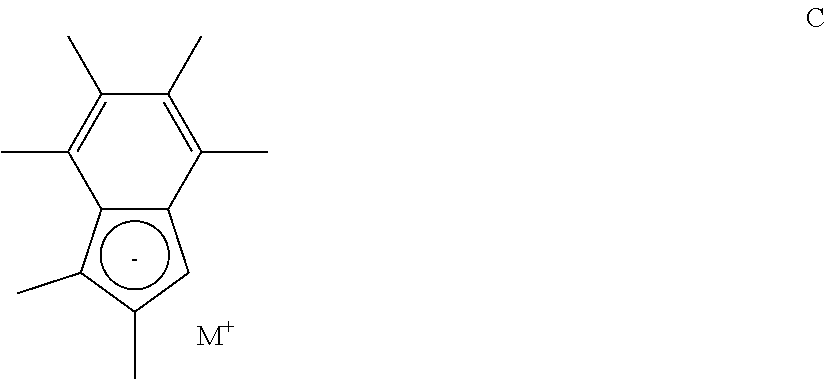

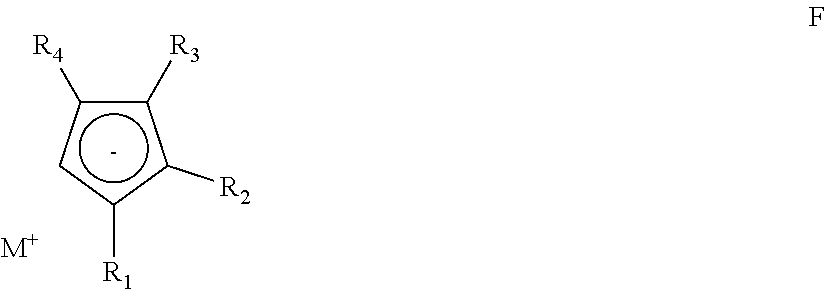
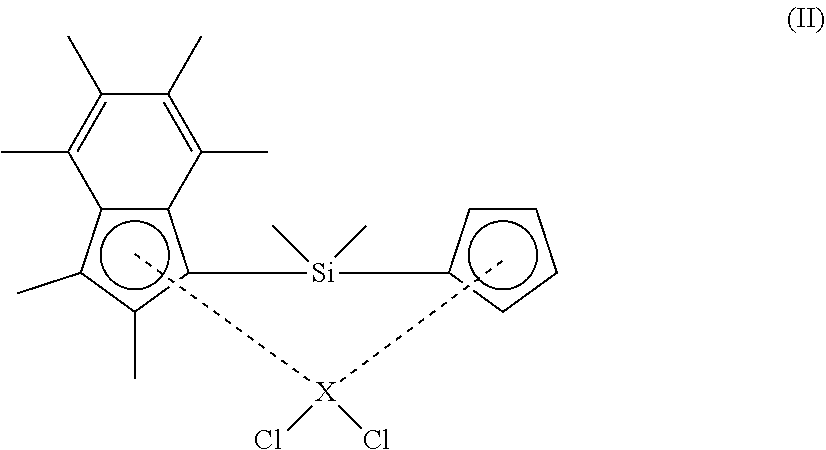
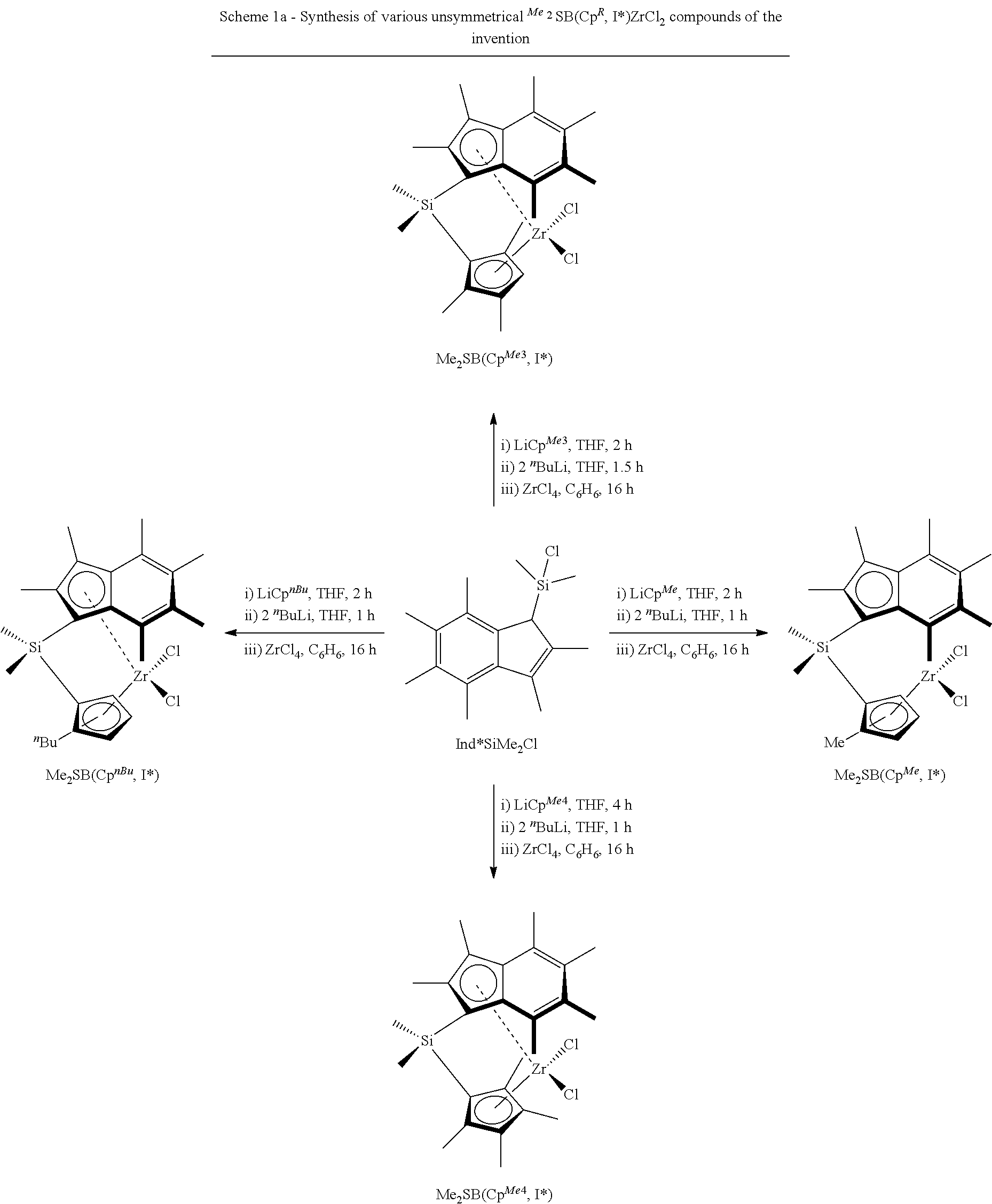
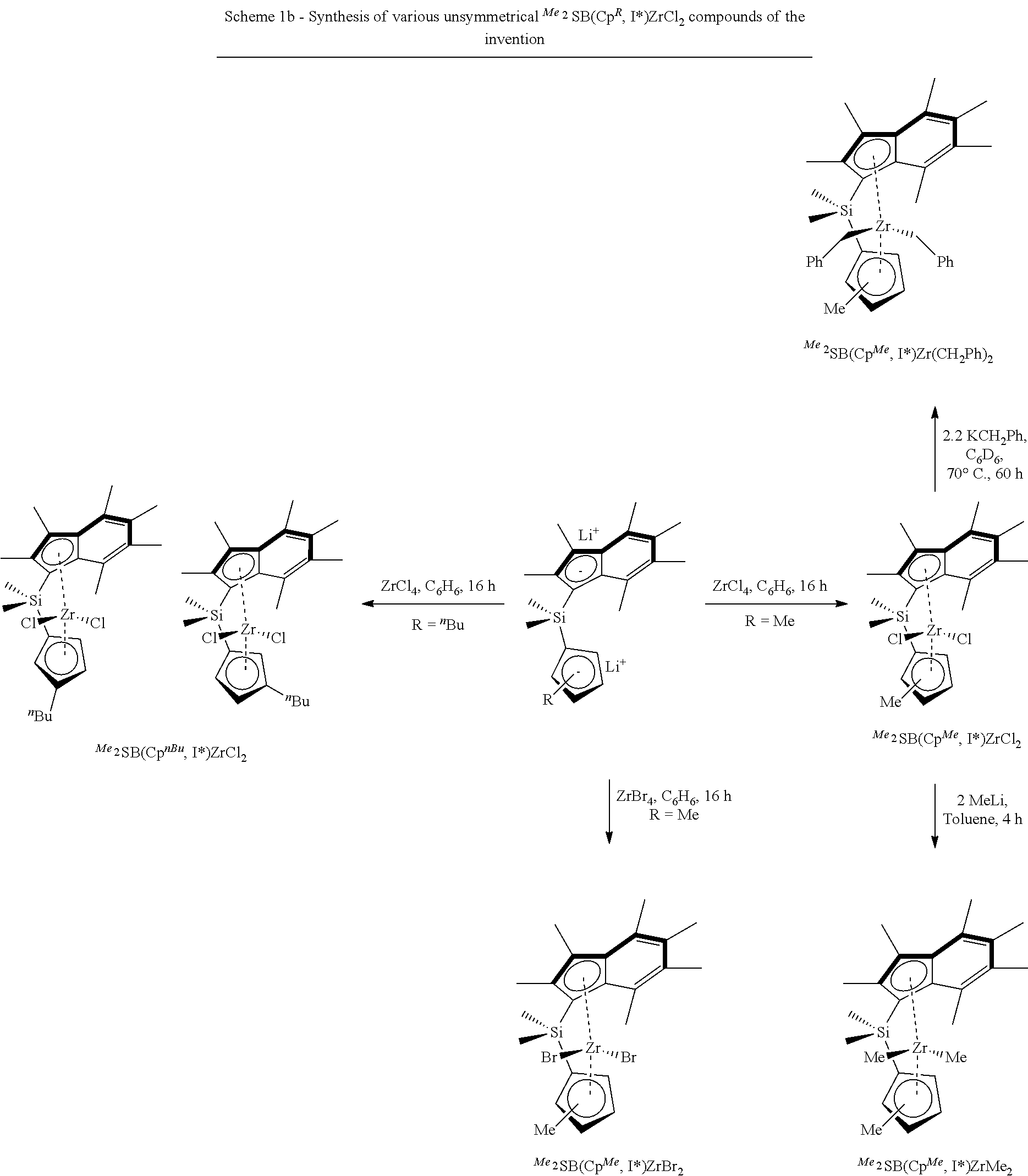
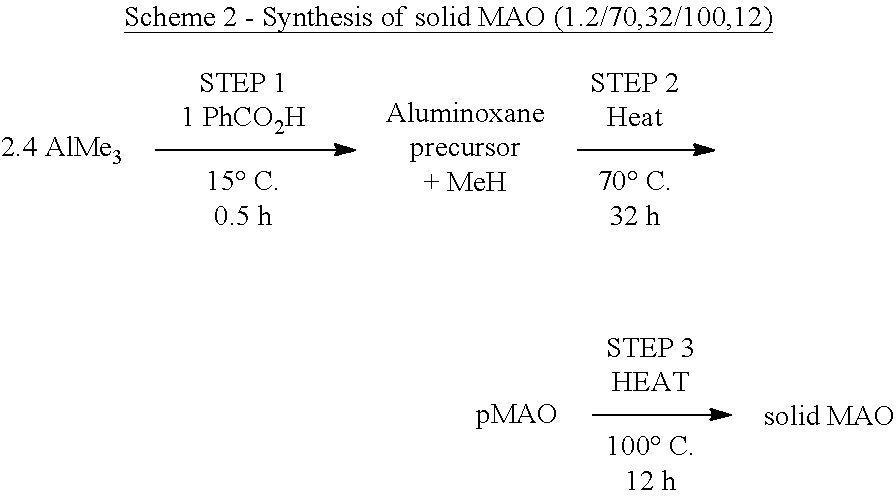

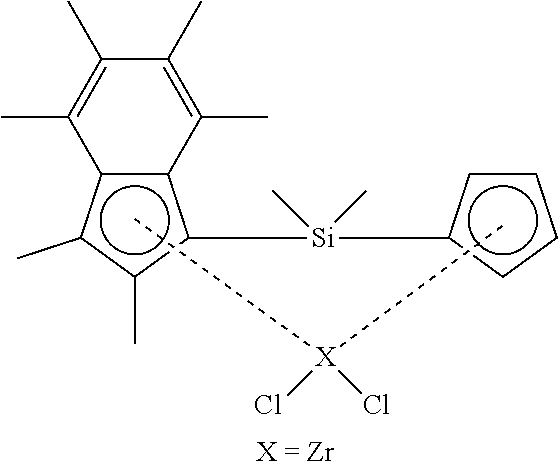
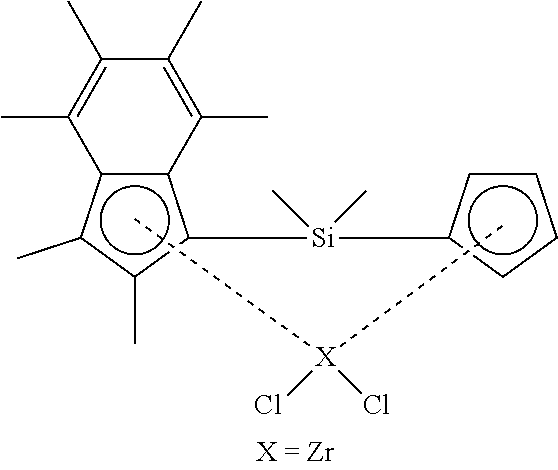
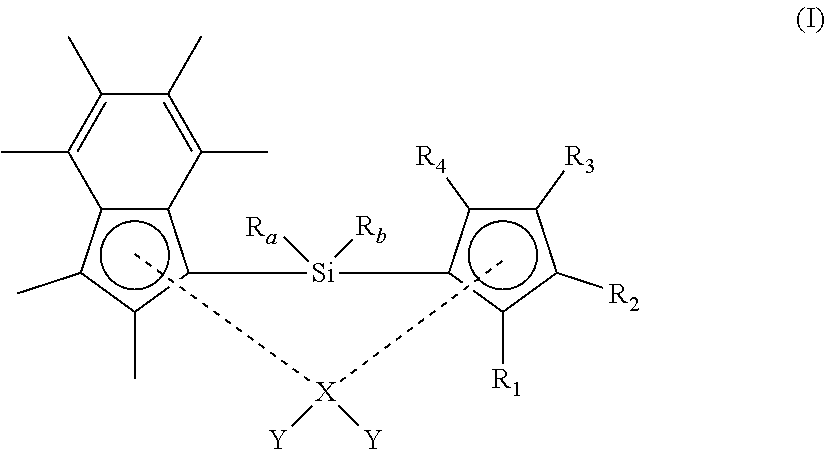
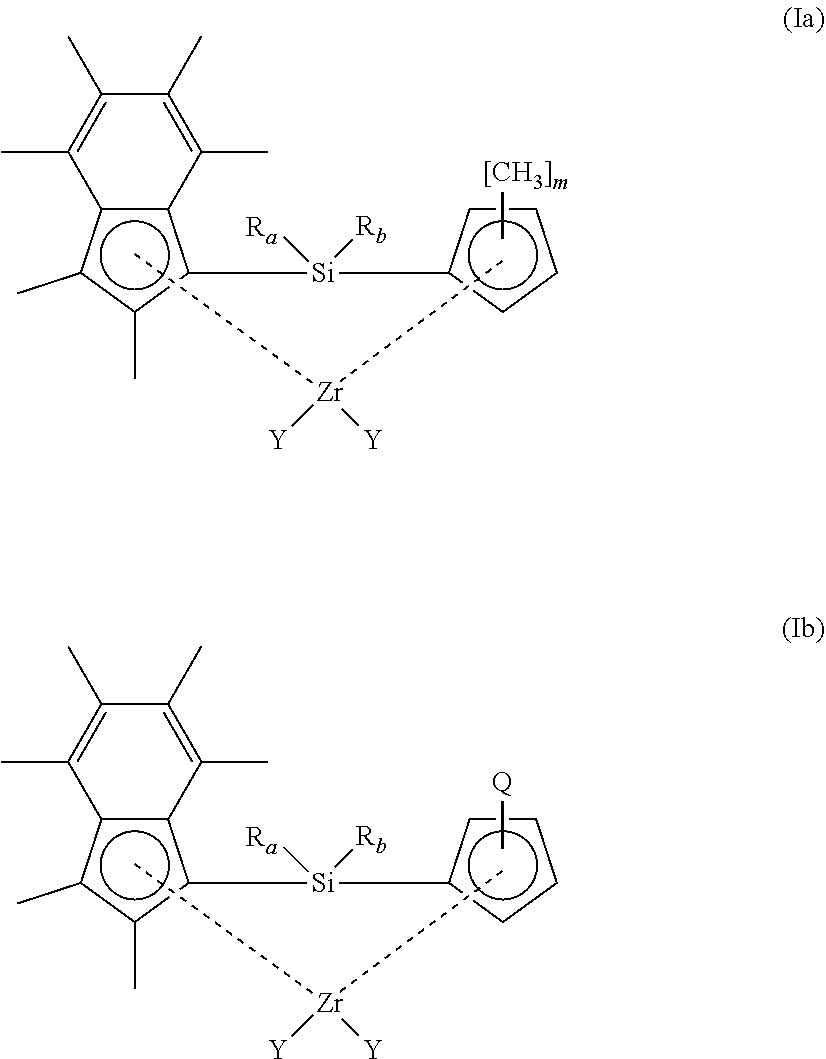
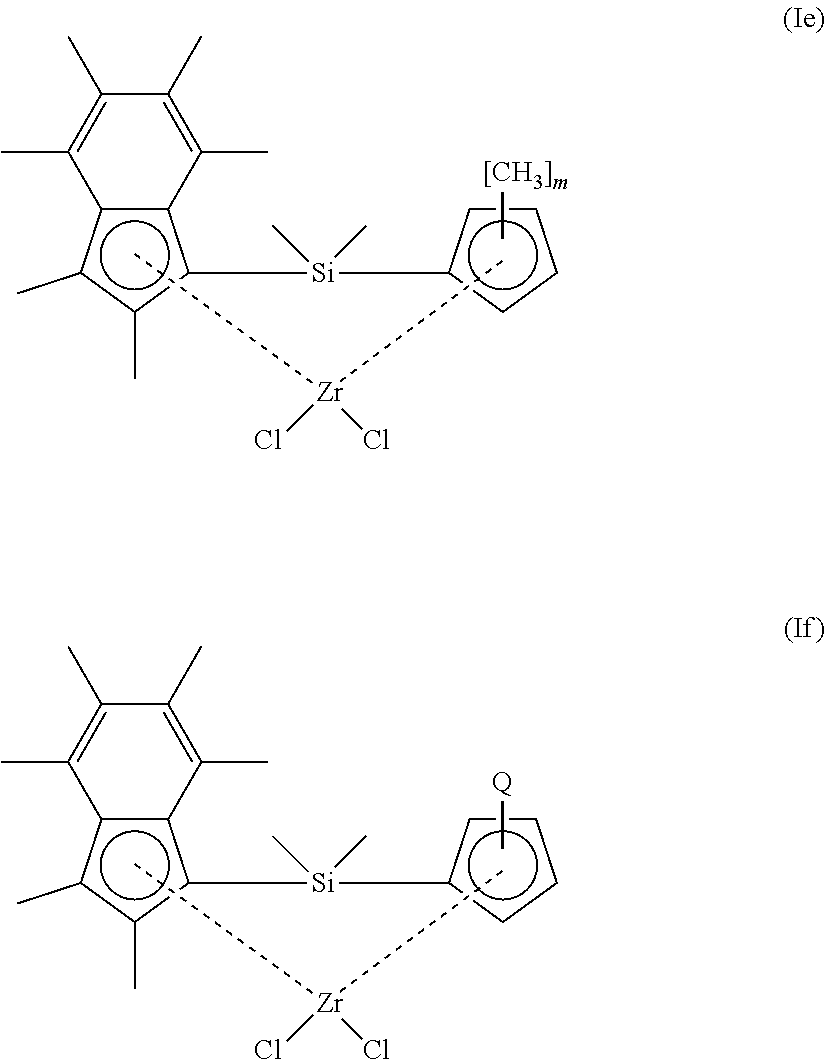
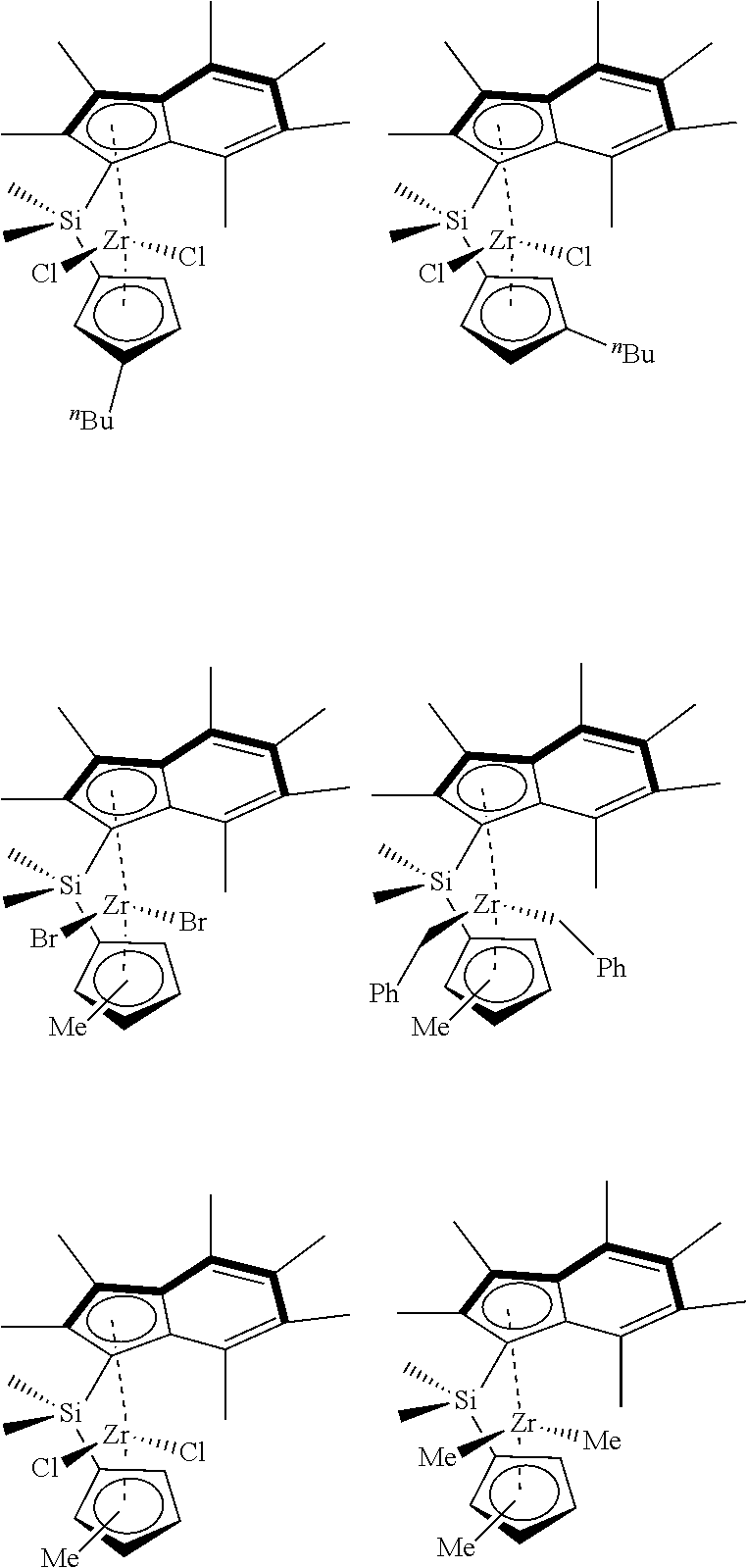
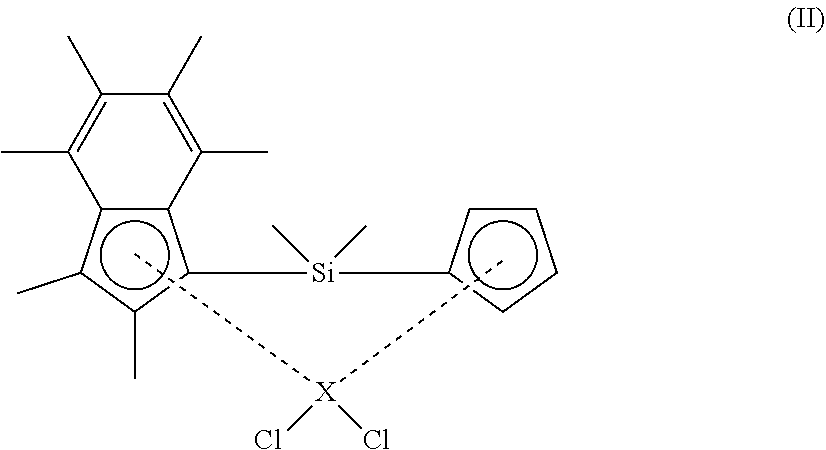
D00000
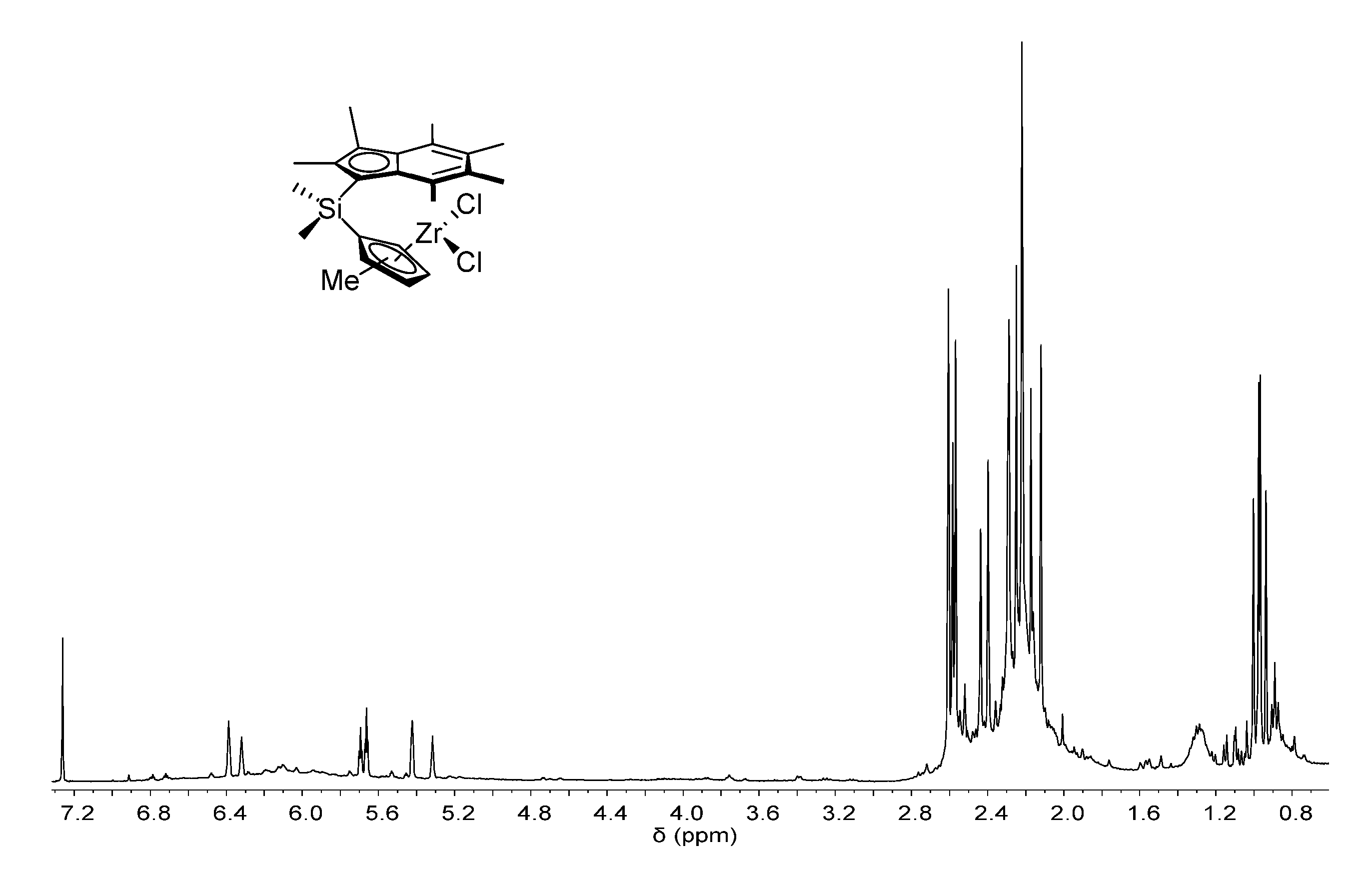
D00001
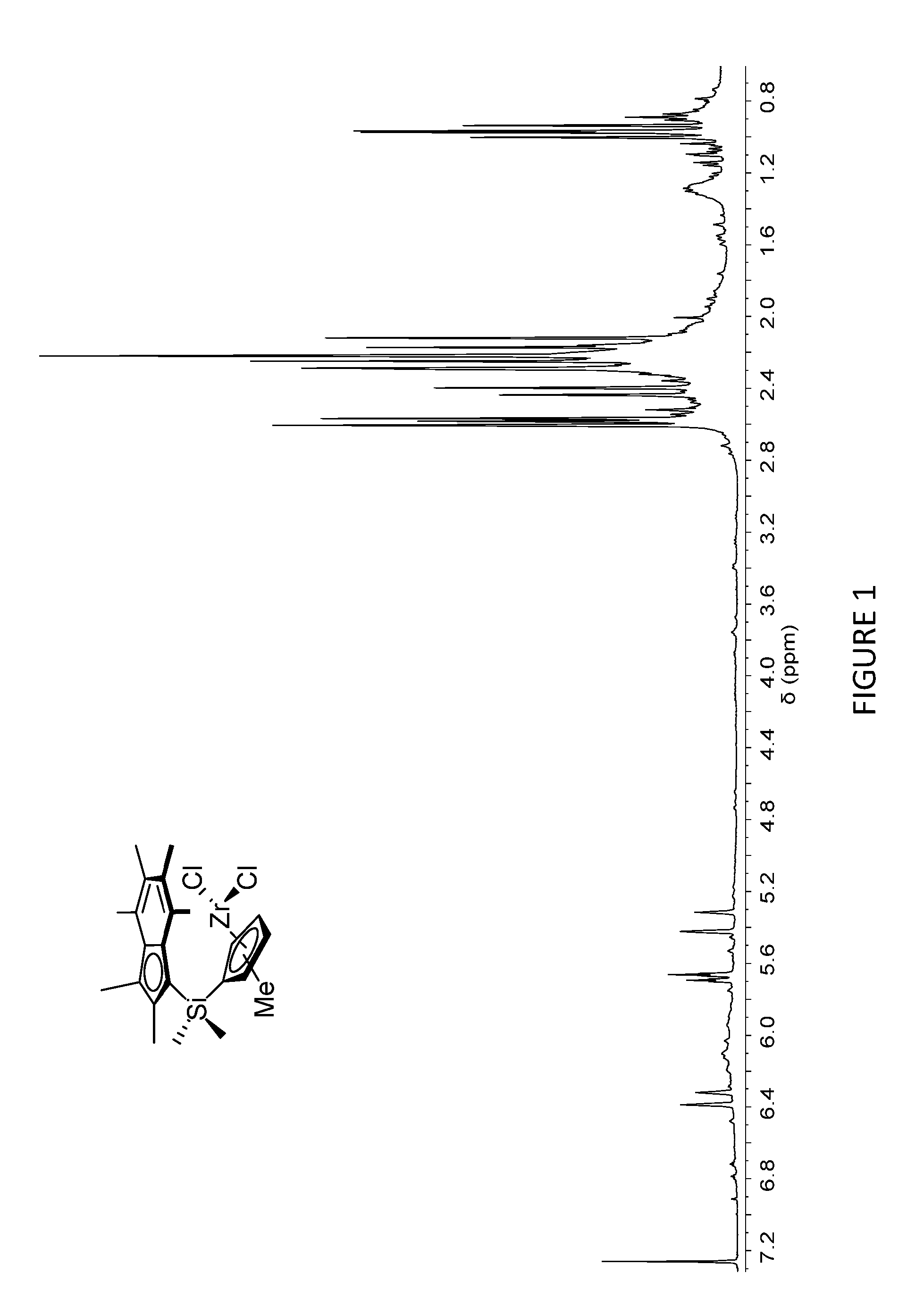
D00002
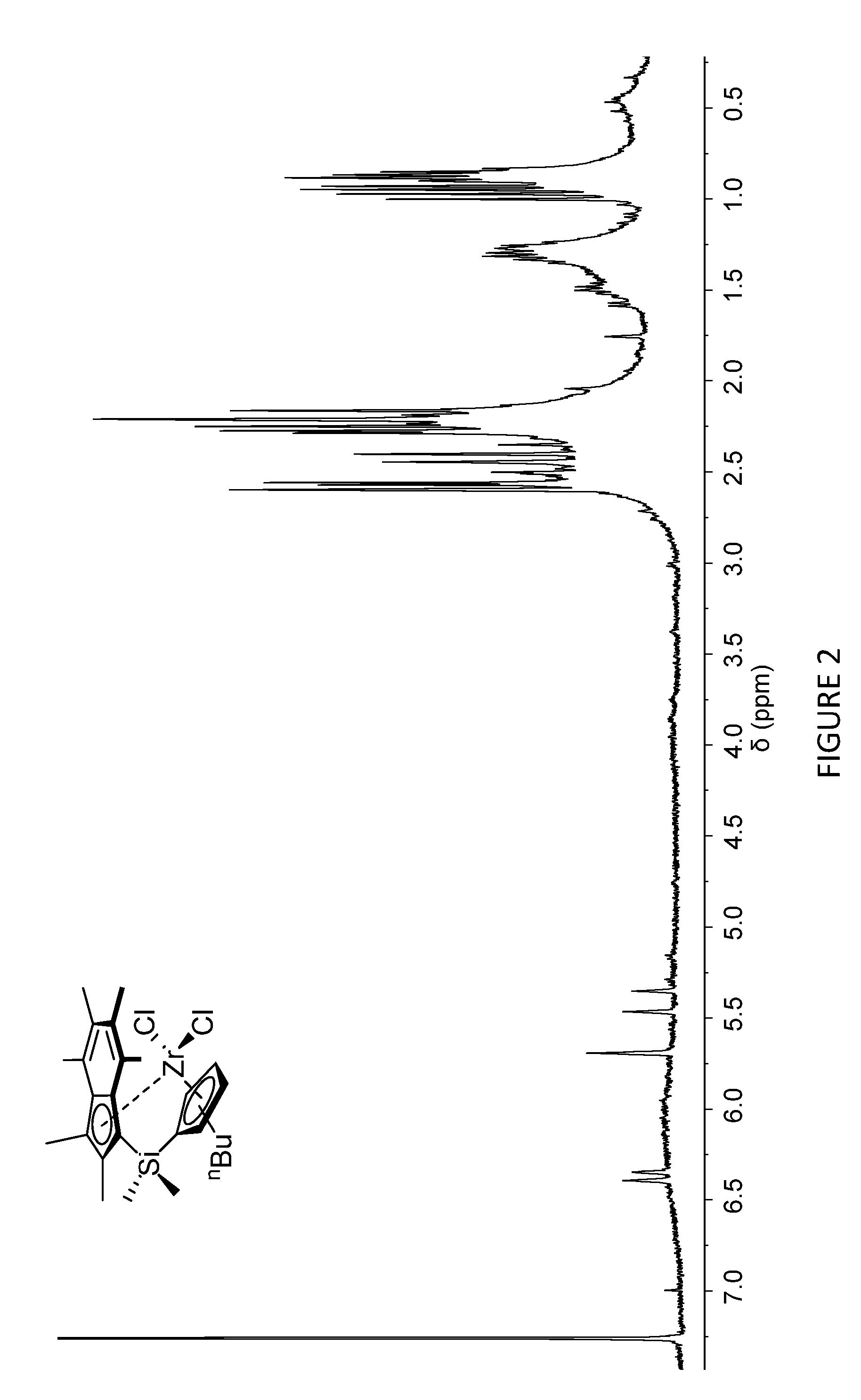
D00003
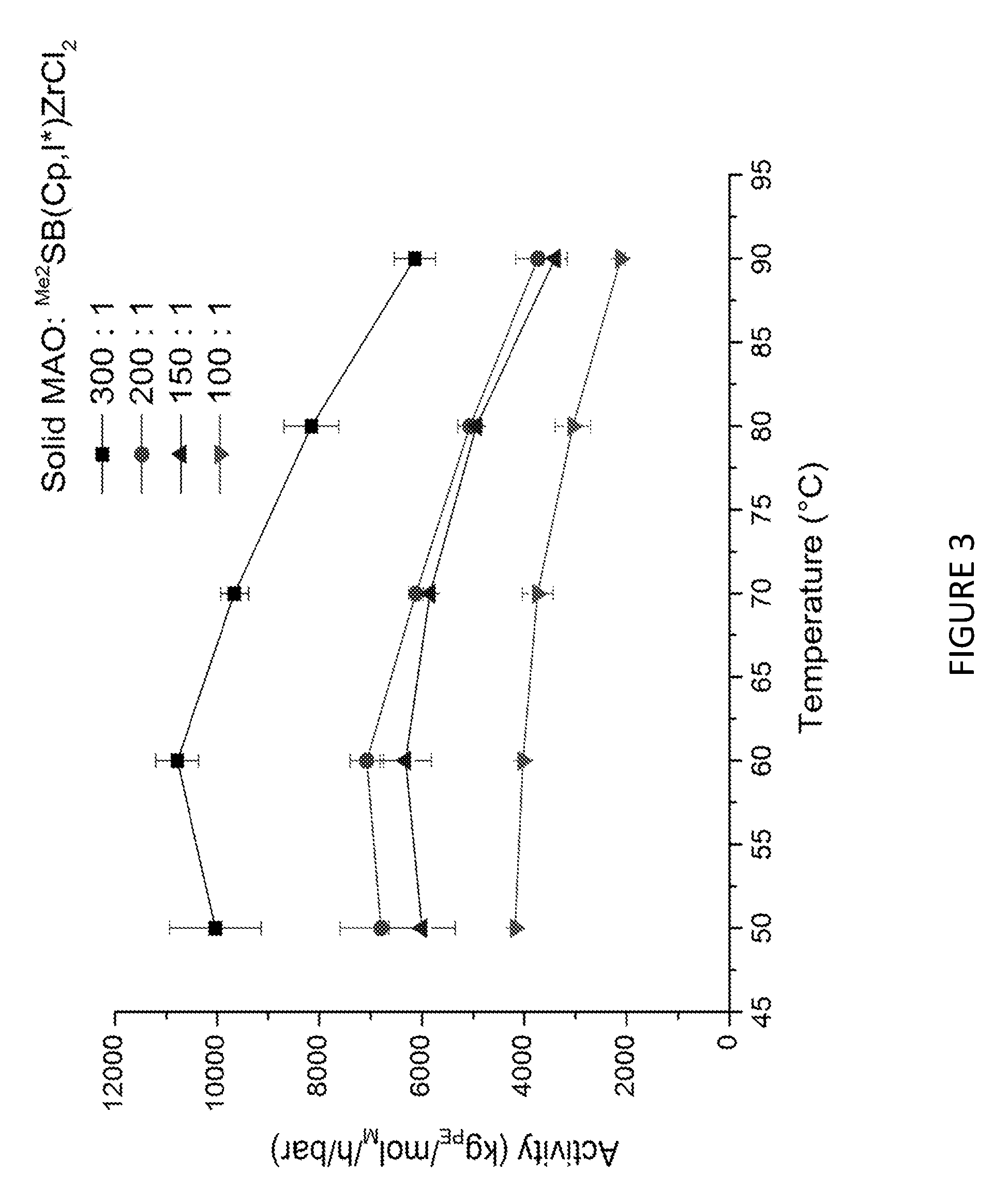
D00004
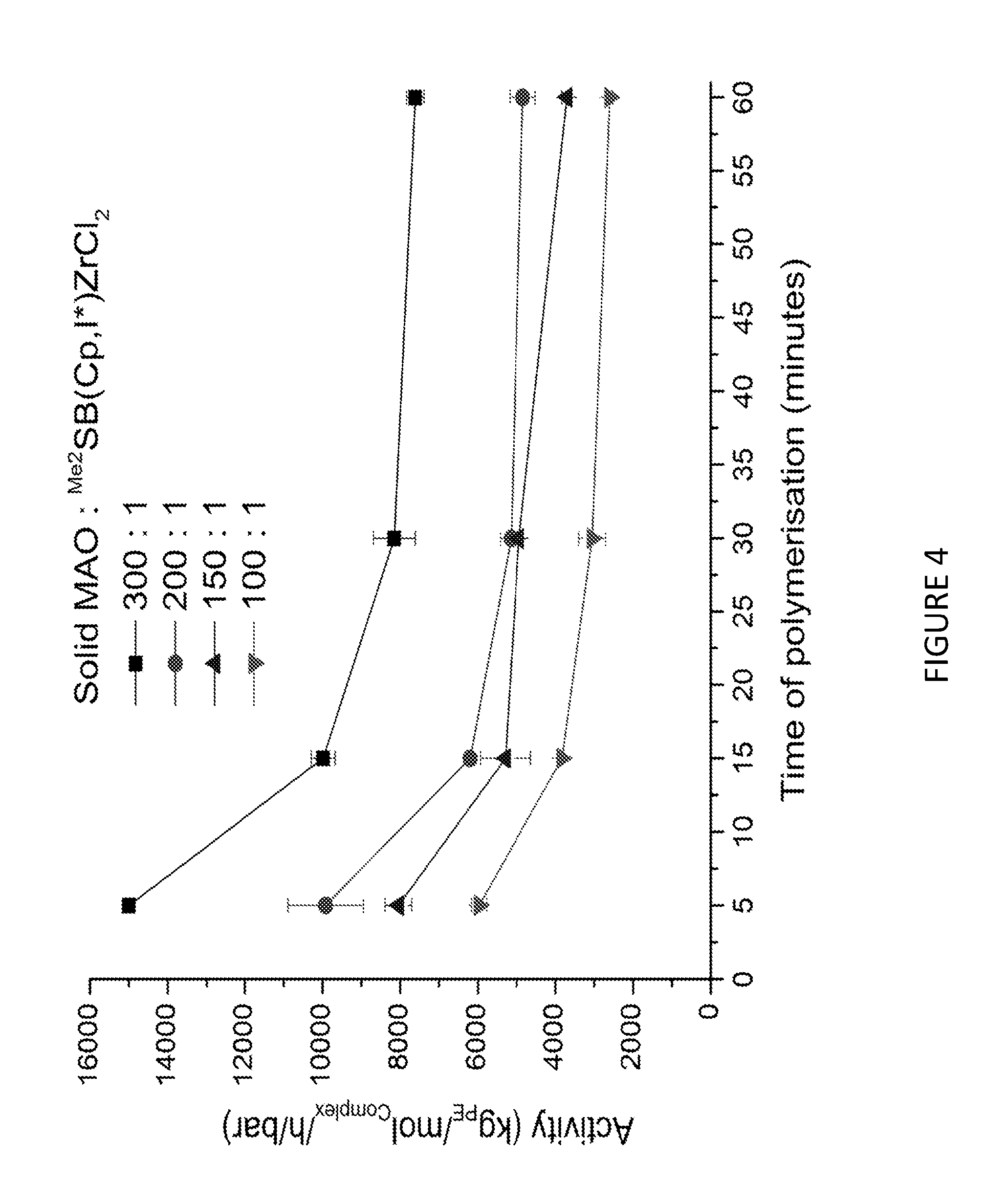
D00005
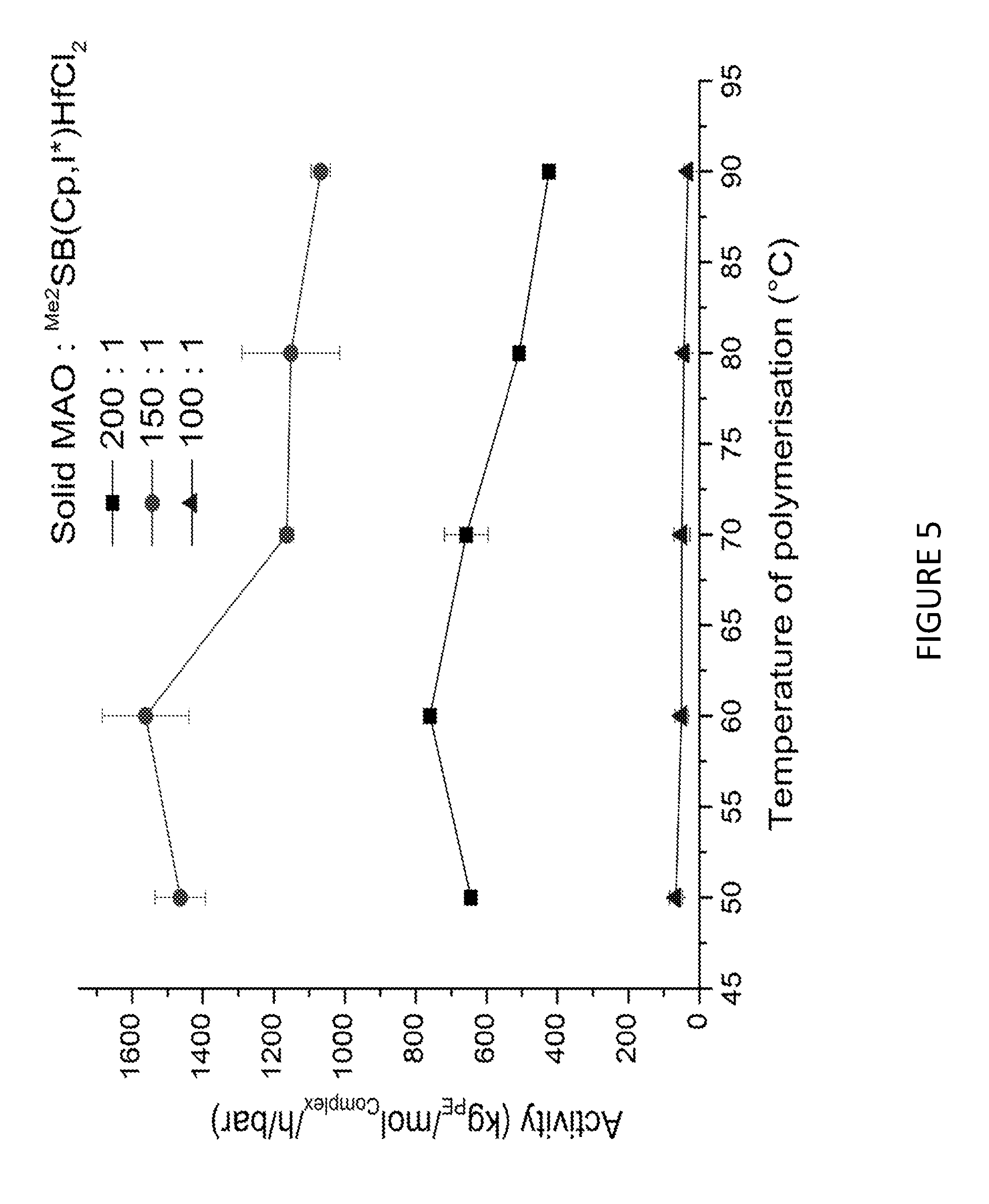
D00006
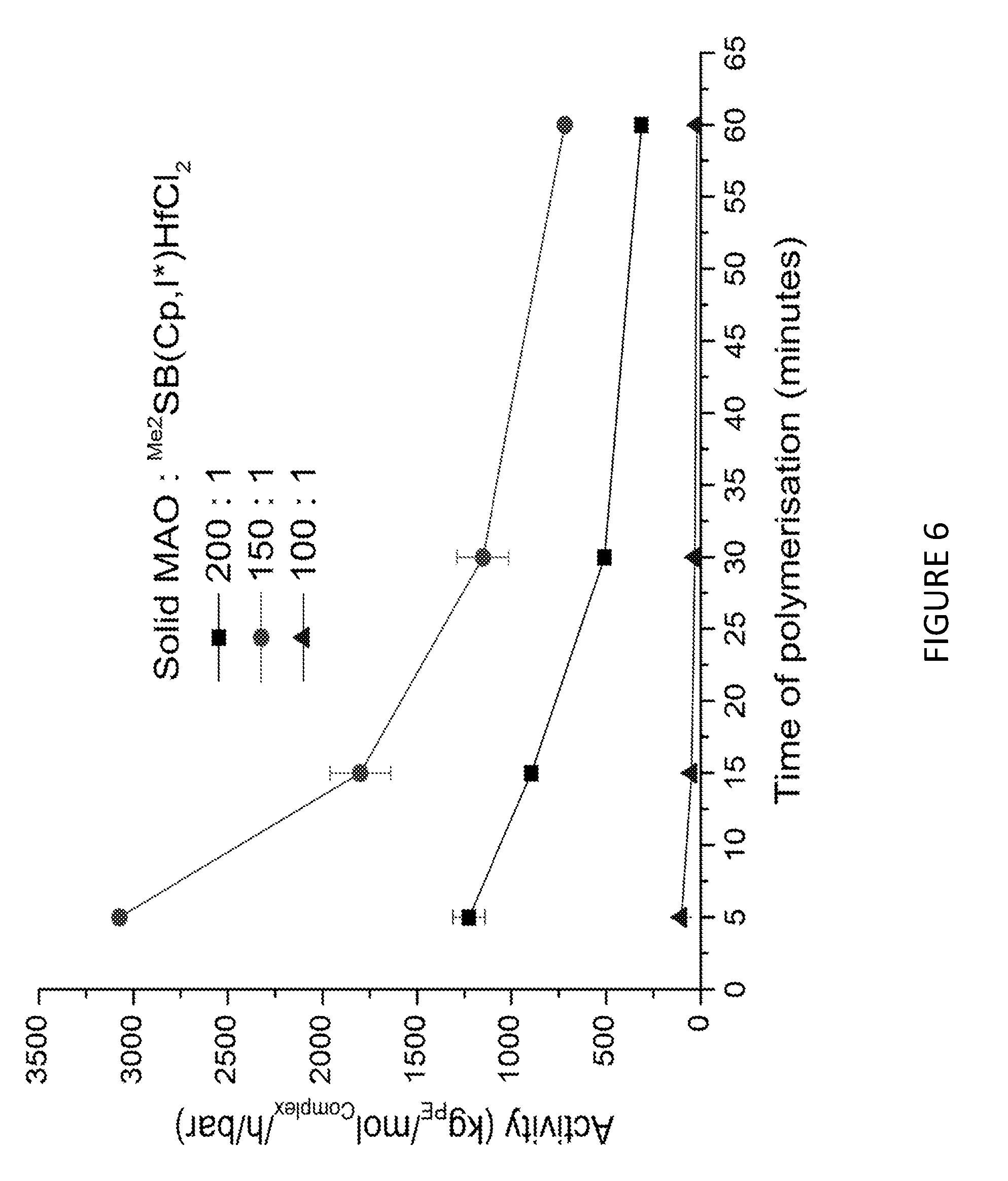
D00007
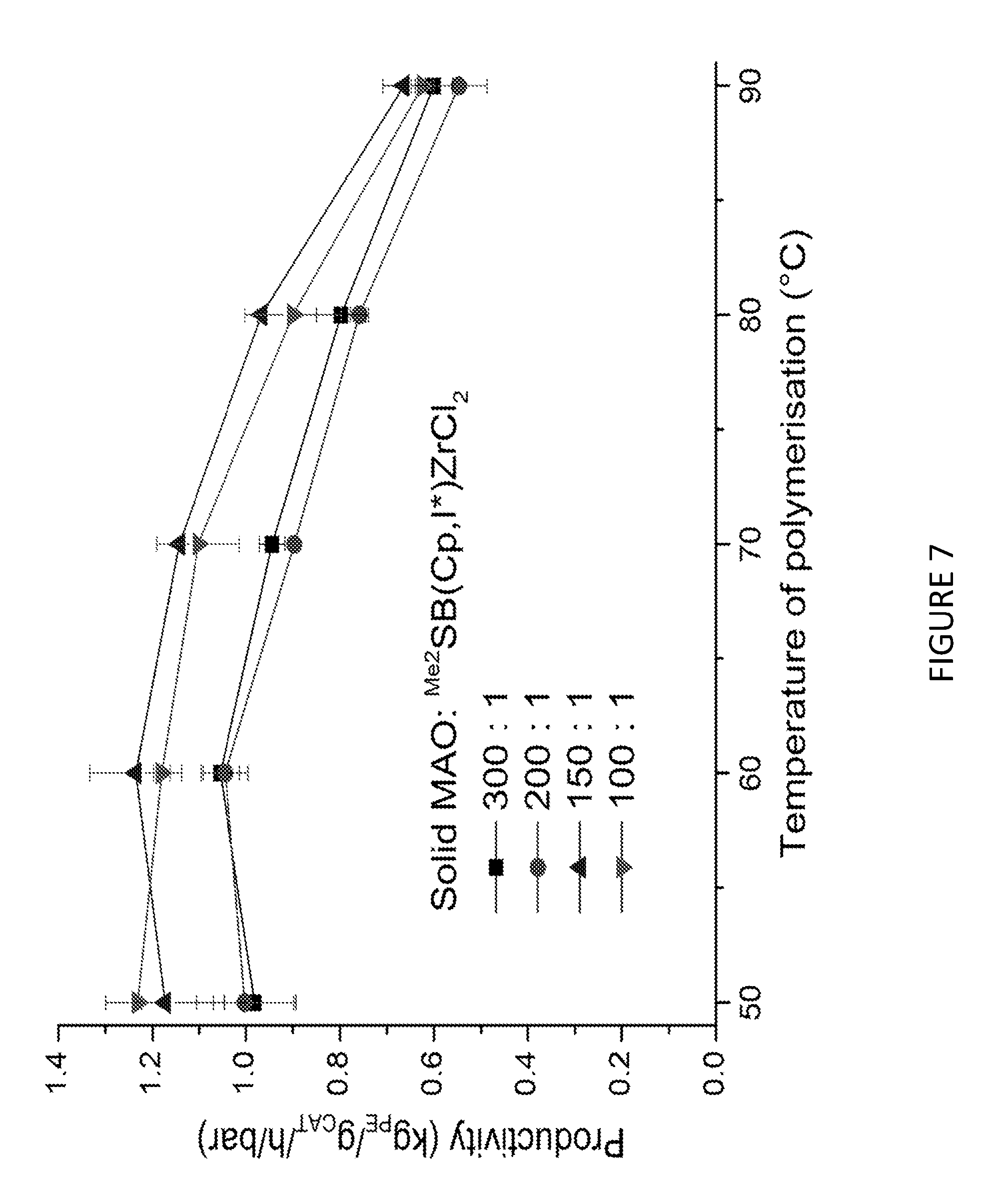
D00008
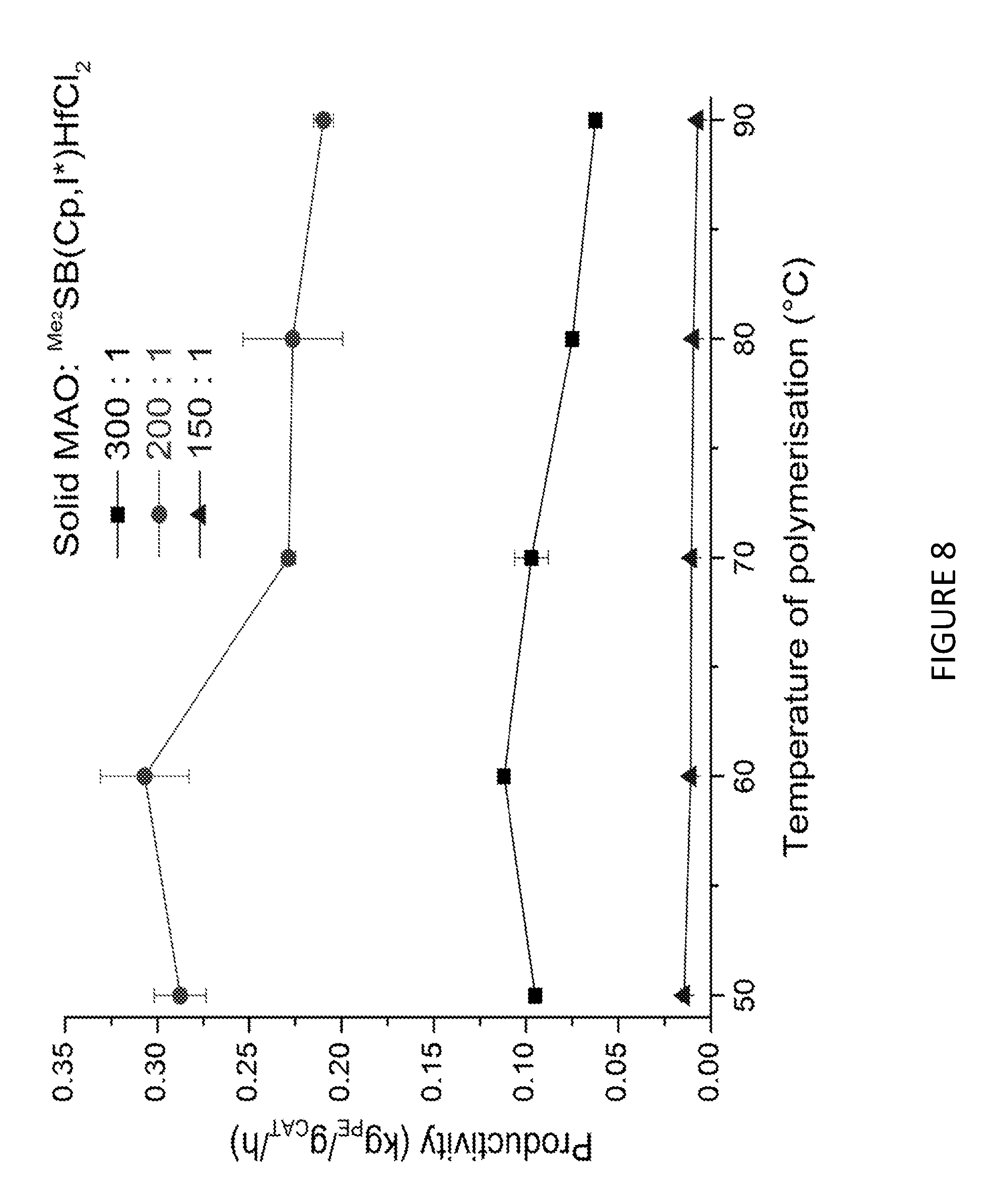
D00009
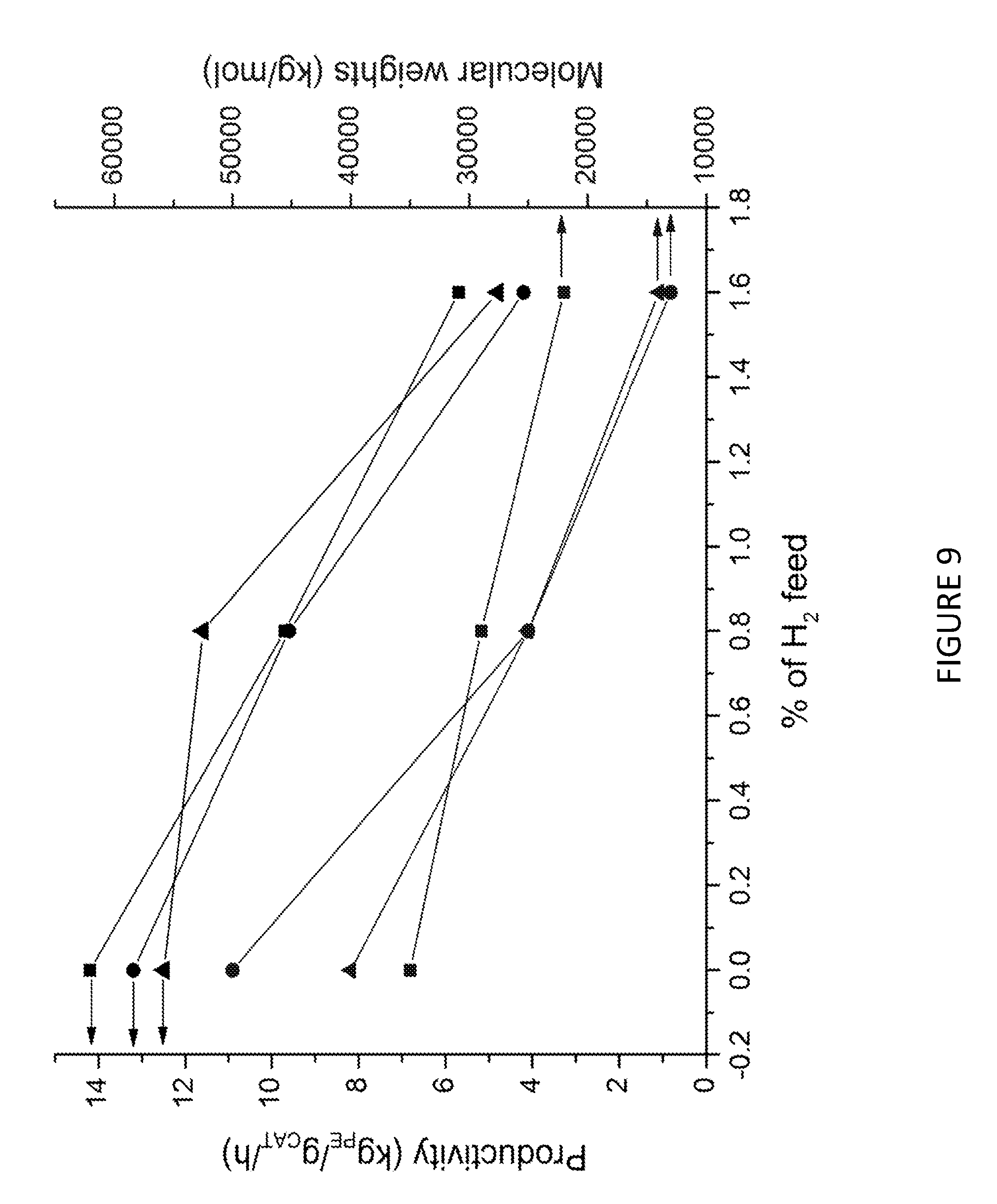
D00010
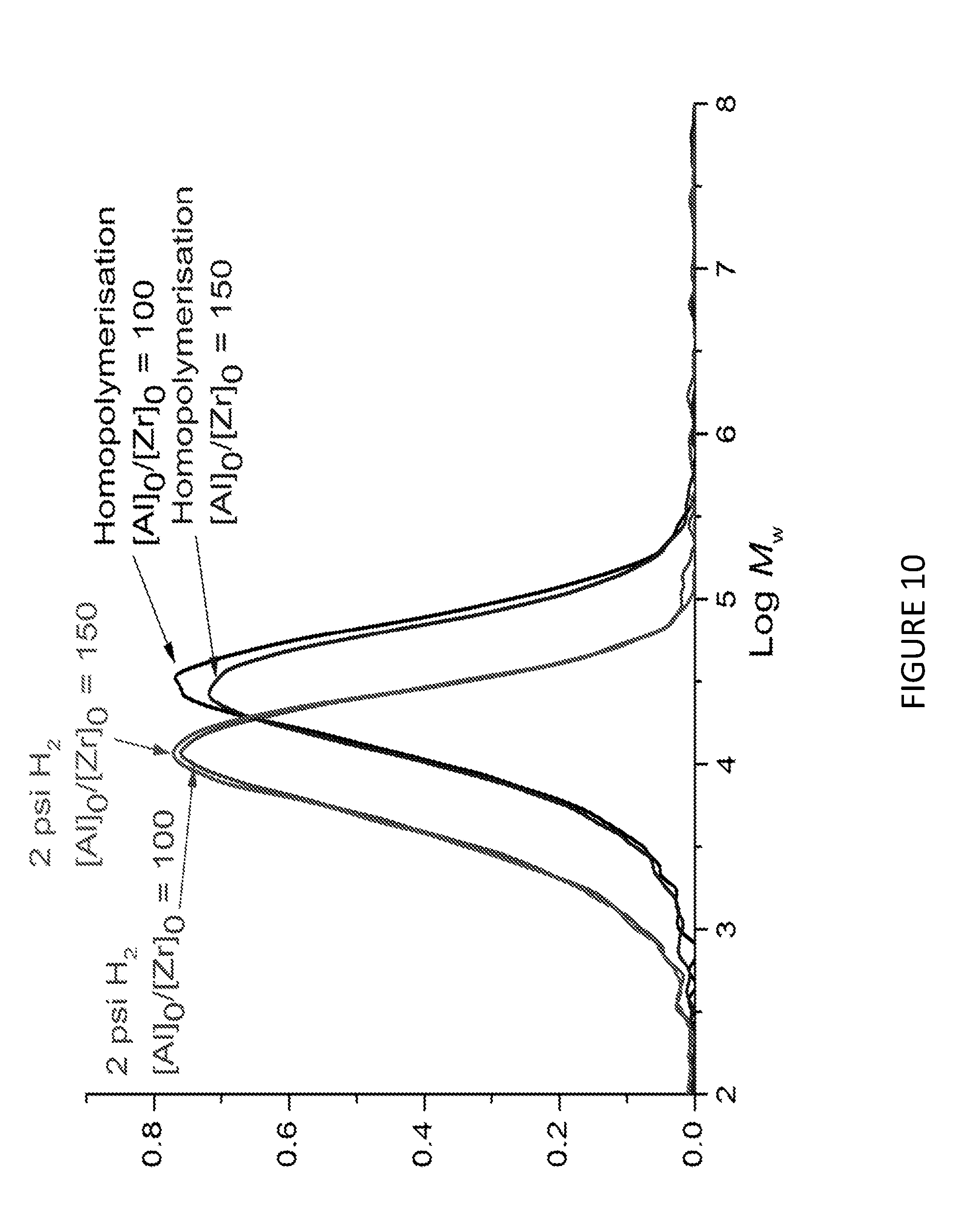
D00011
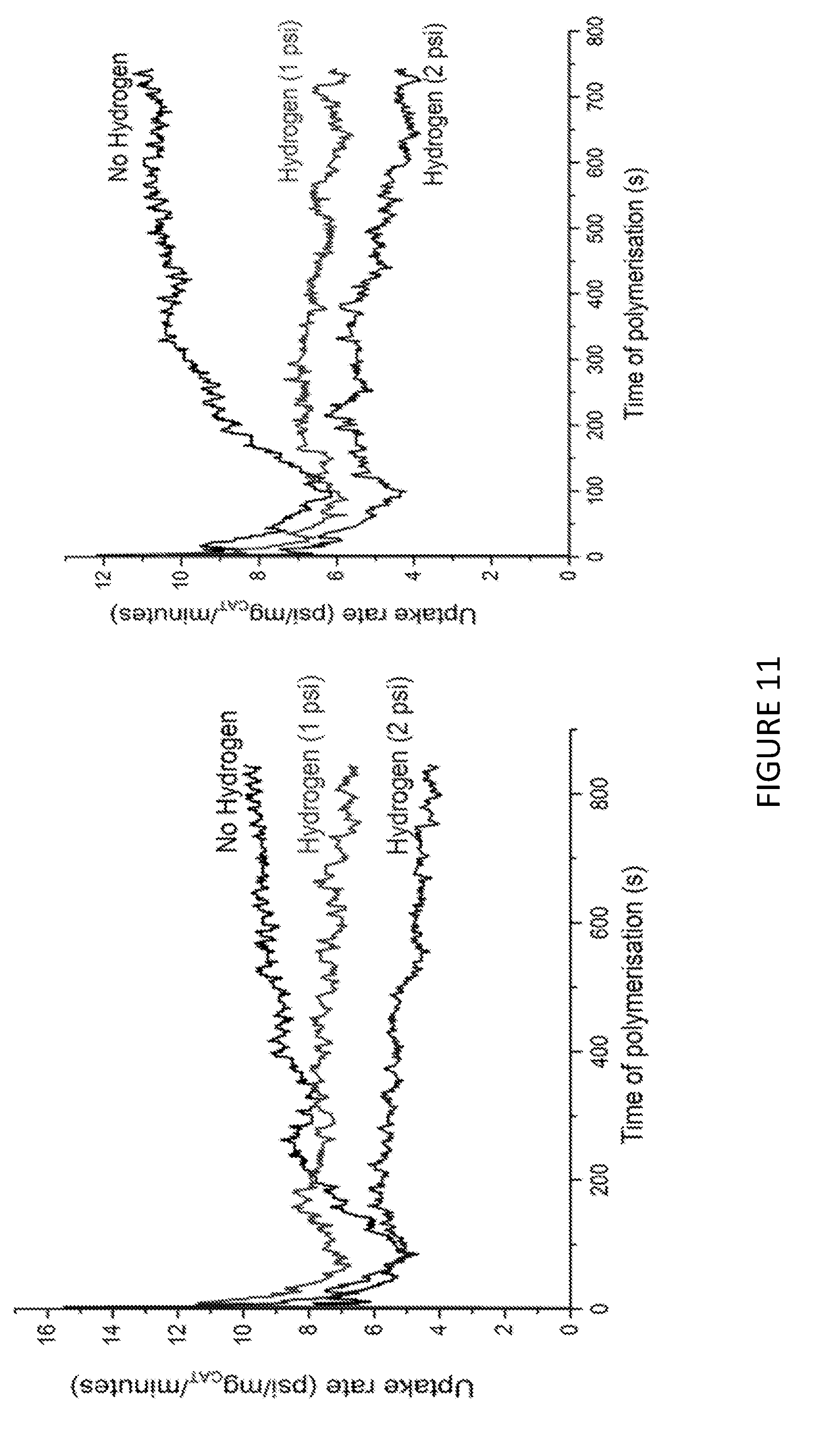
D00012
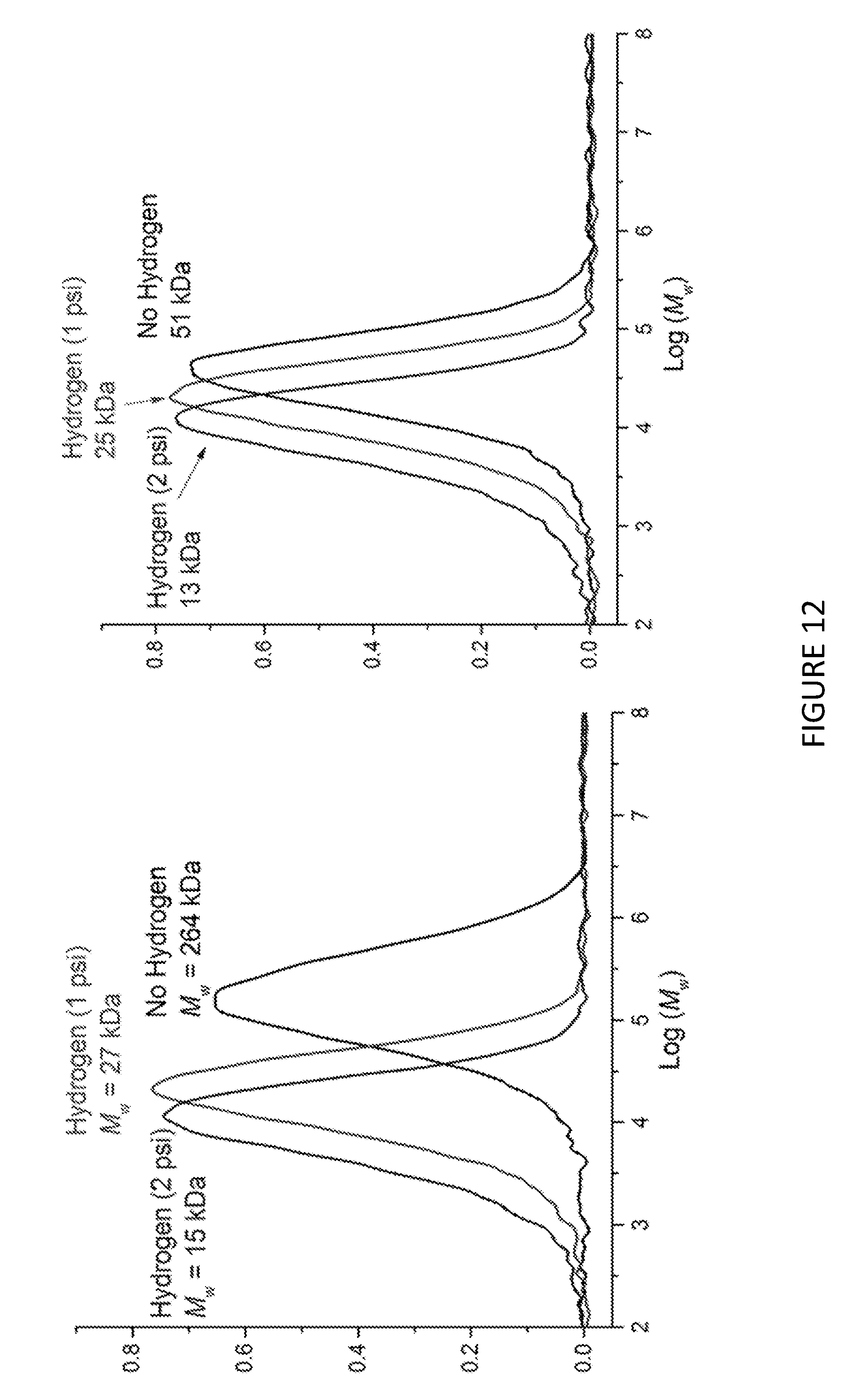
D00013
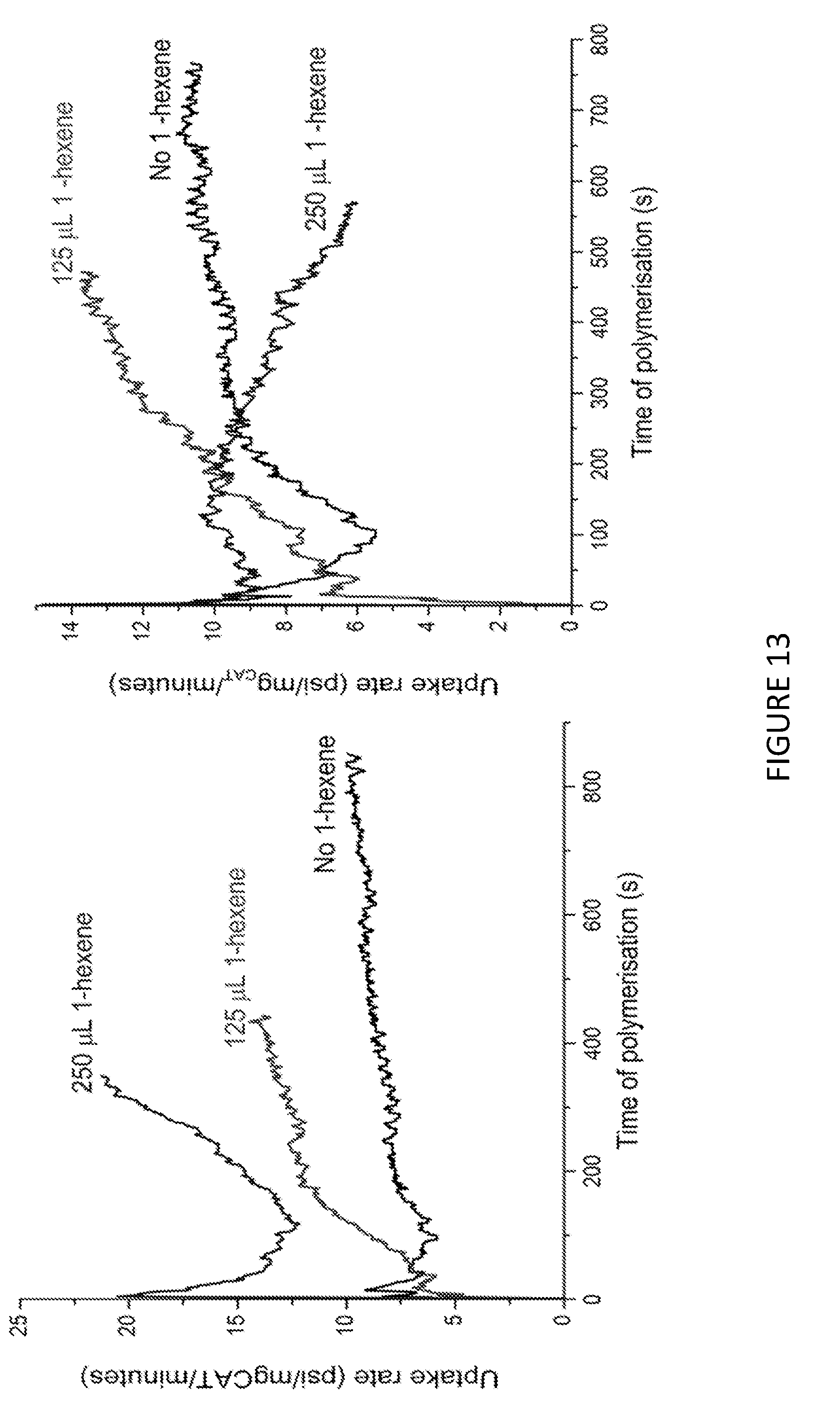
D00014
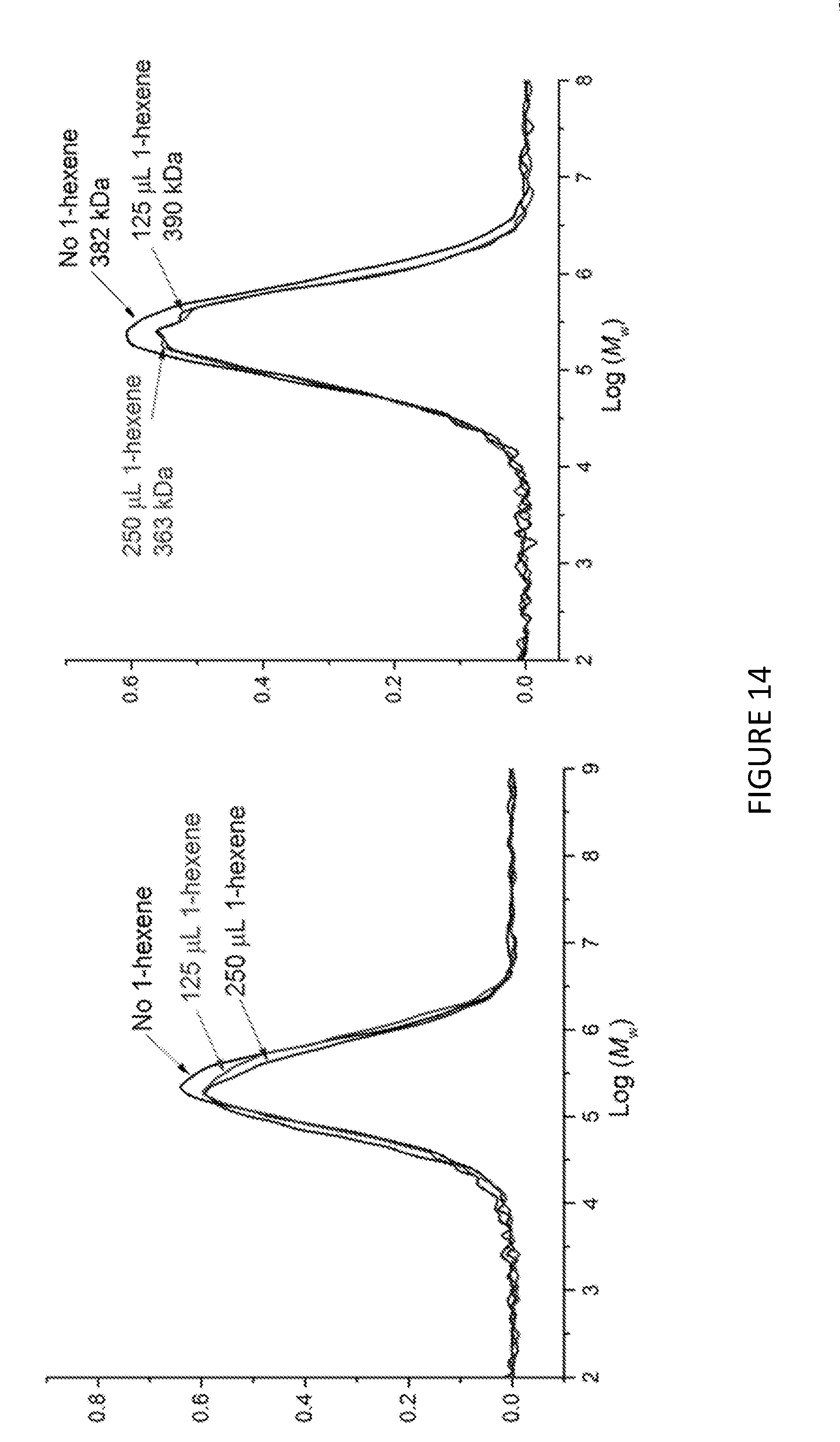
D00015
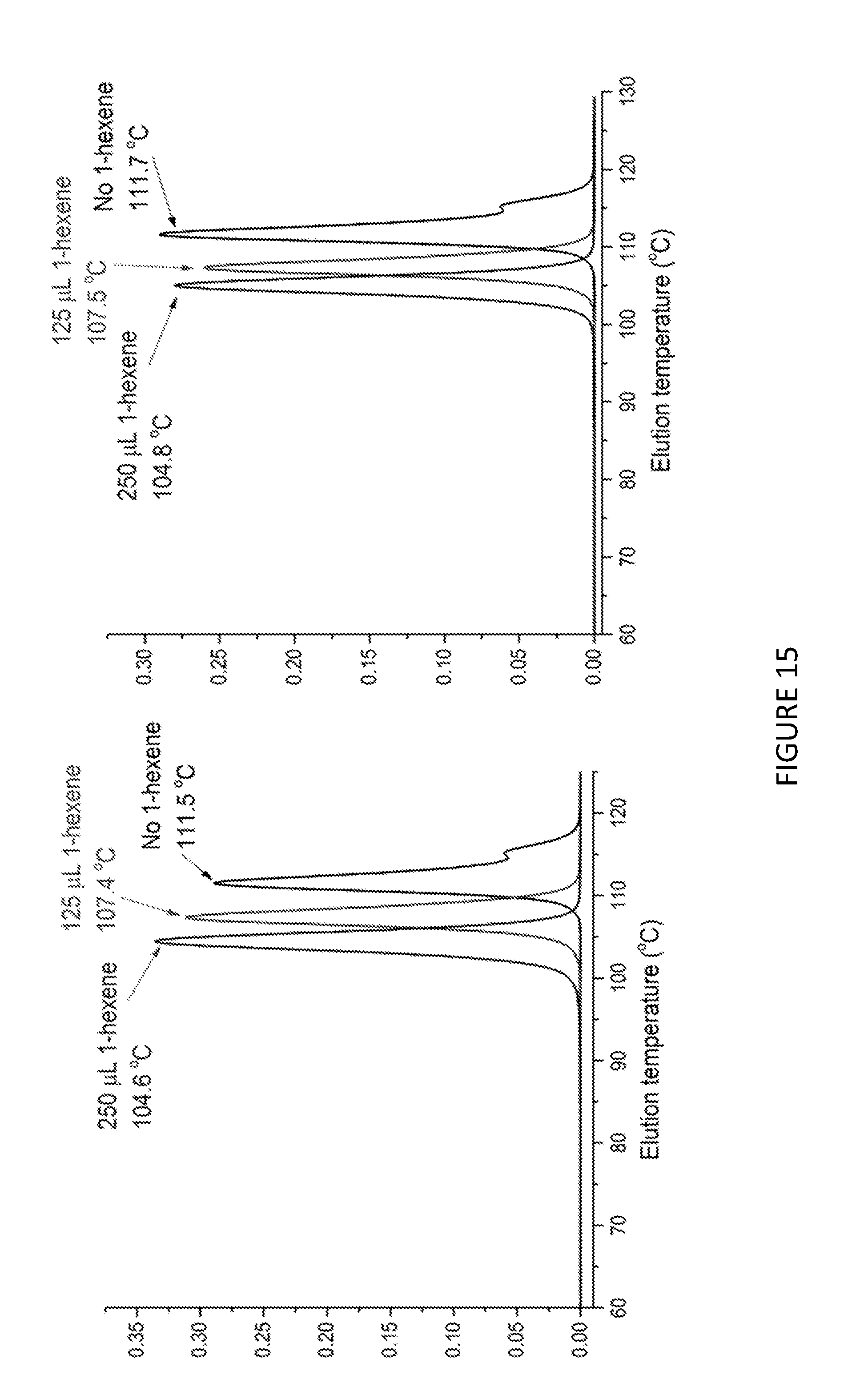
D00016
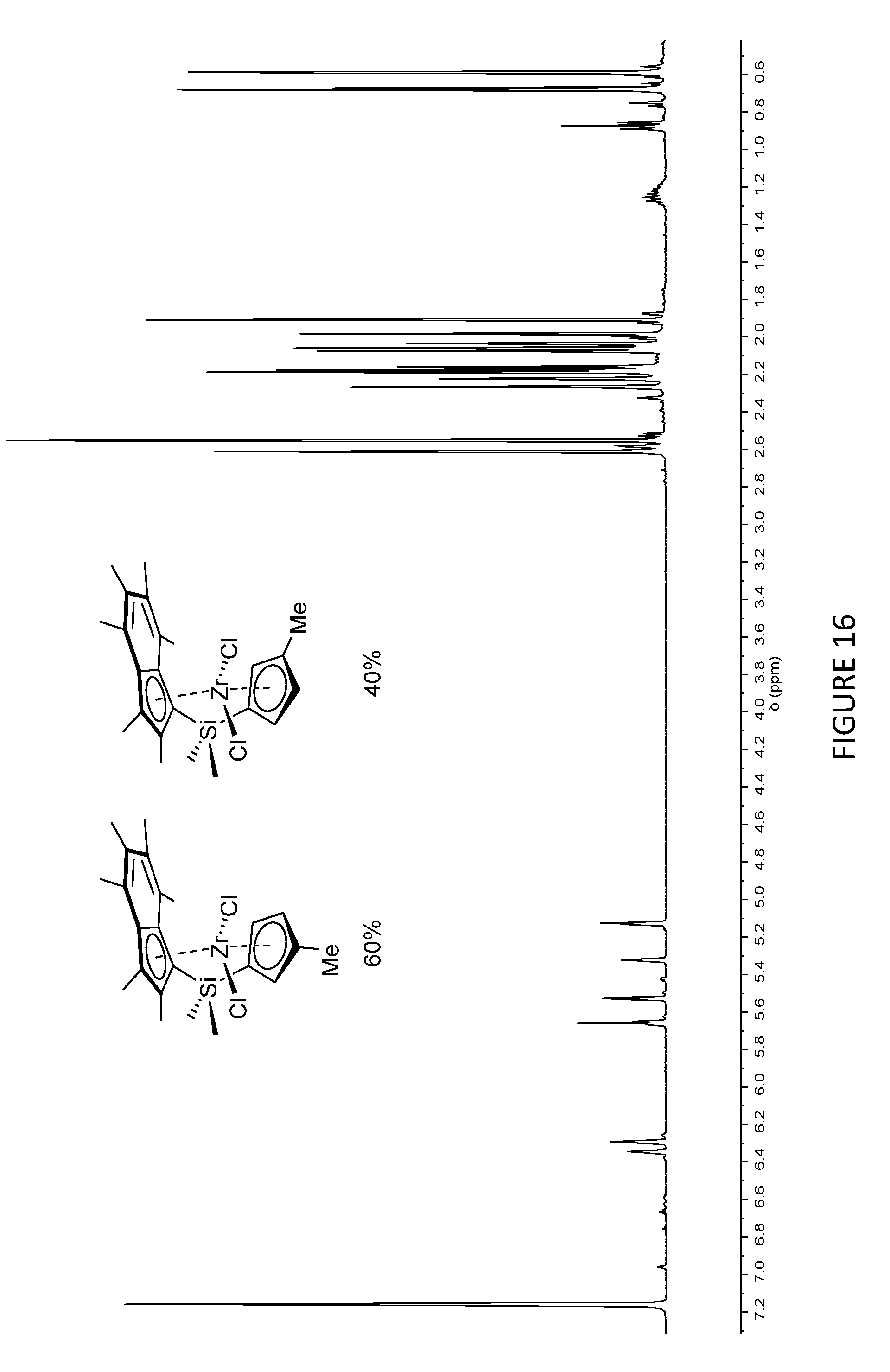
D00017
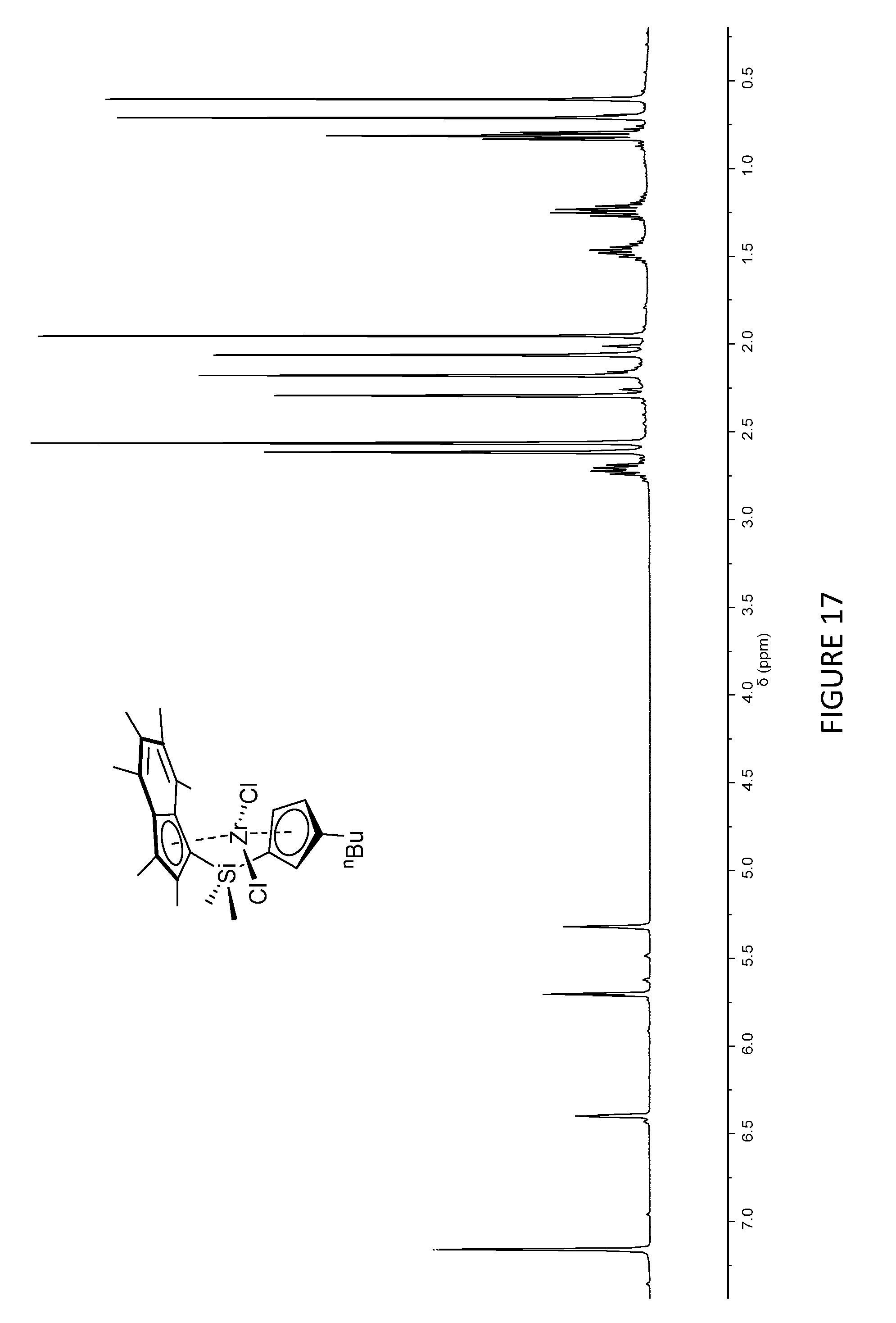
D00018
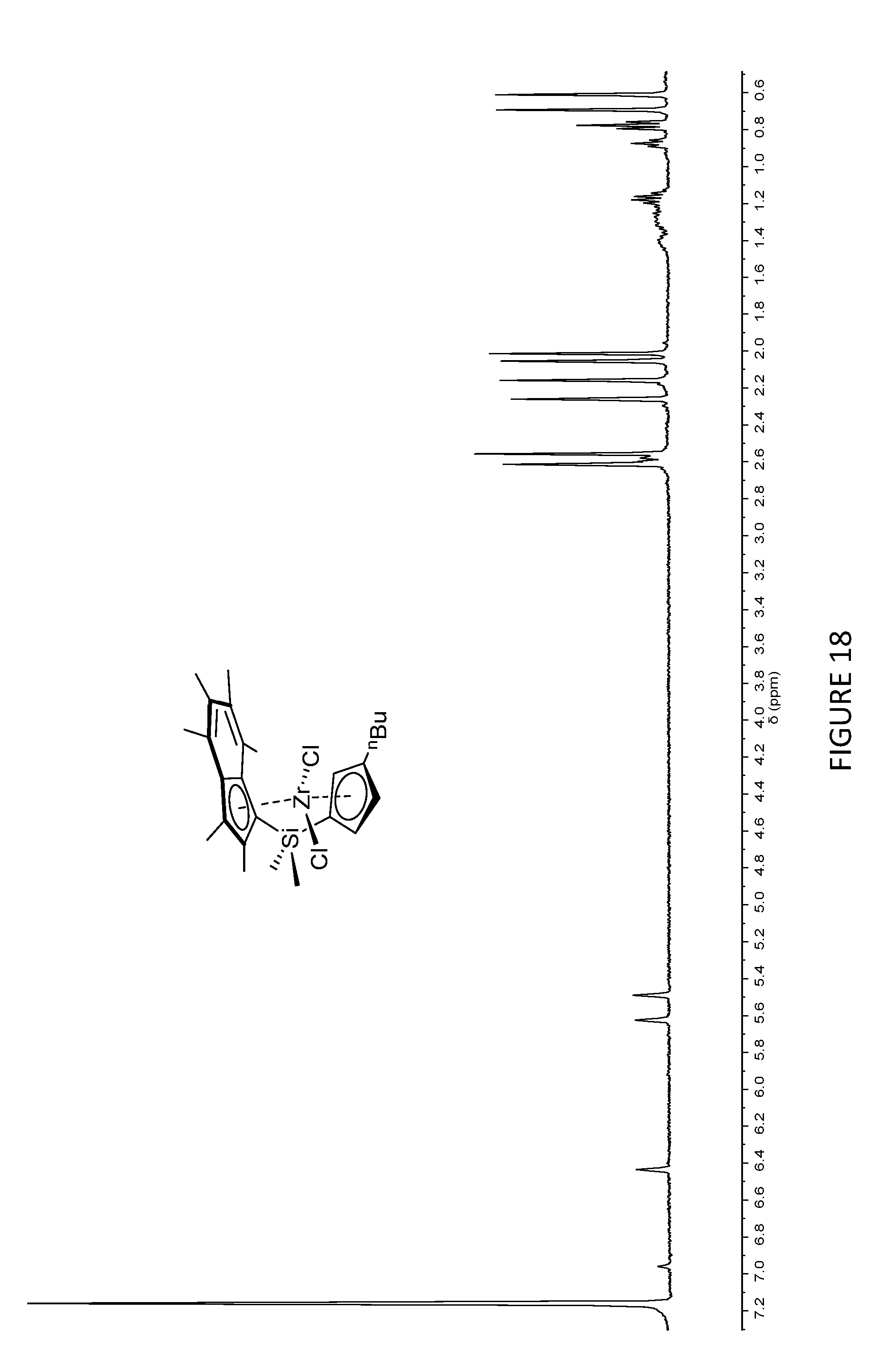
D00019
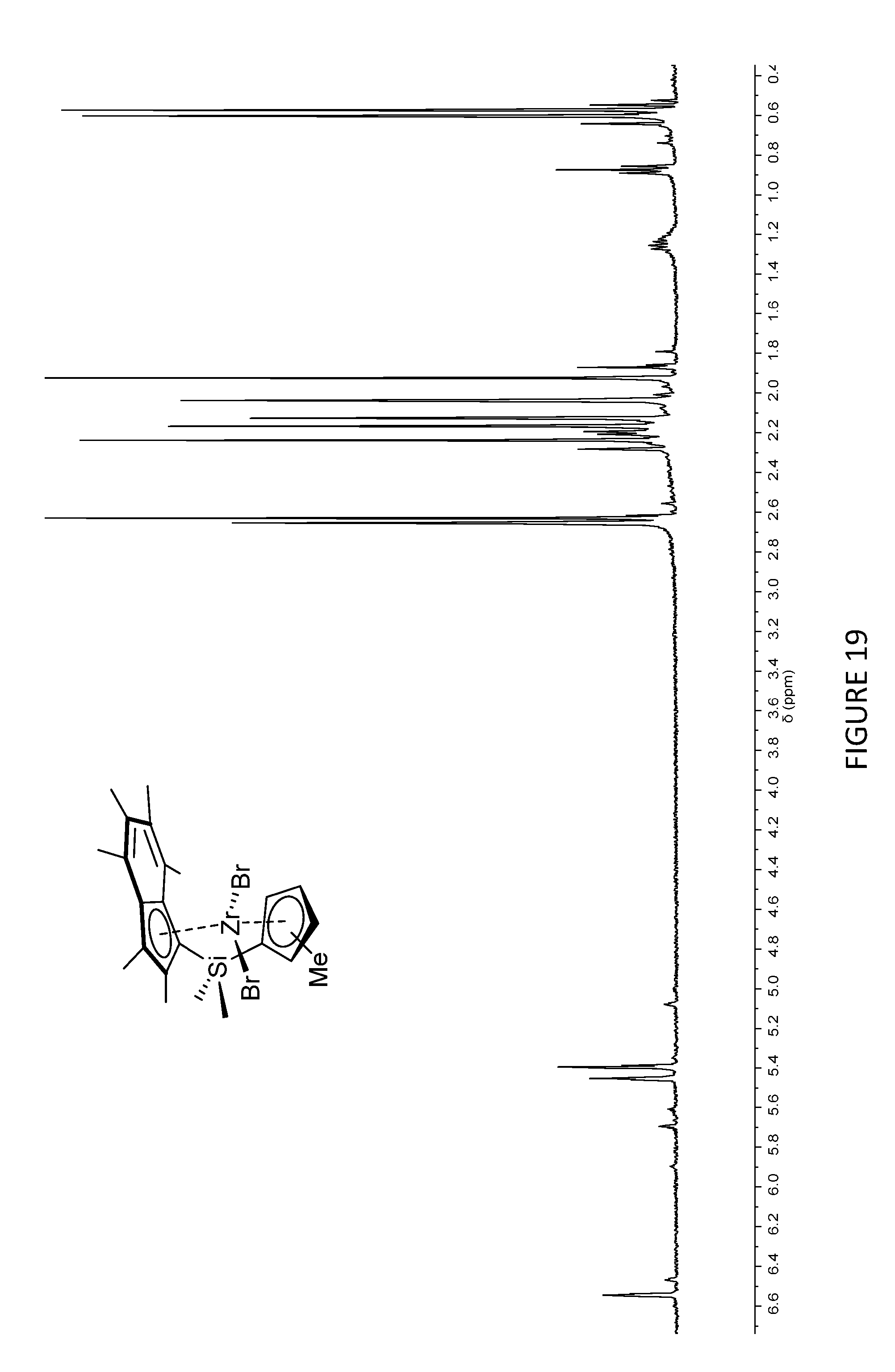
D00020

D00021
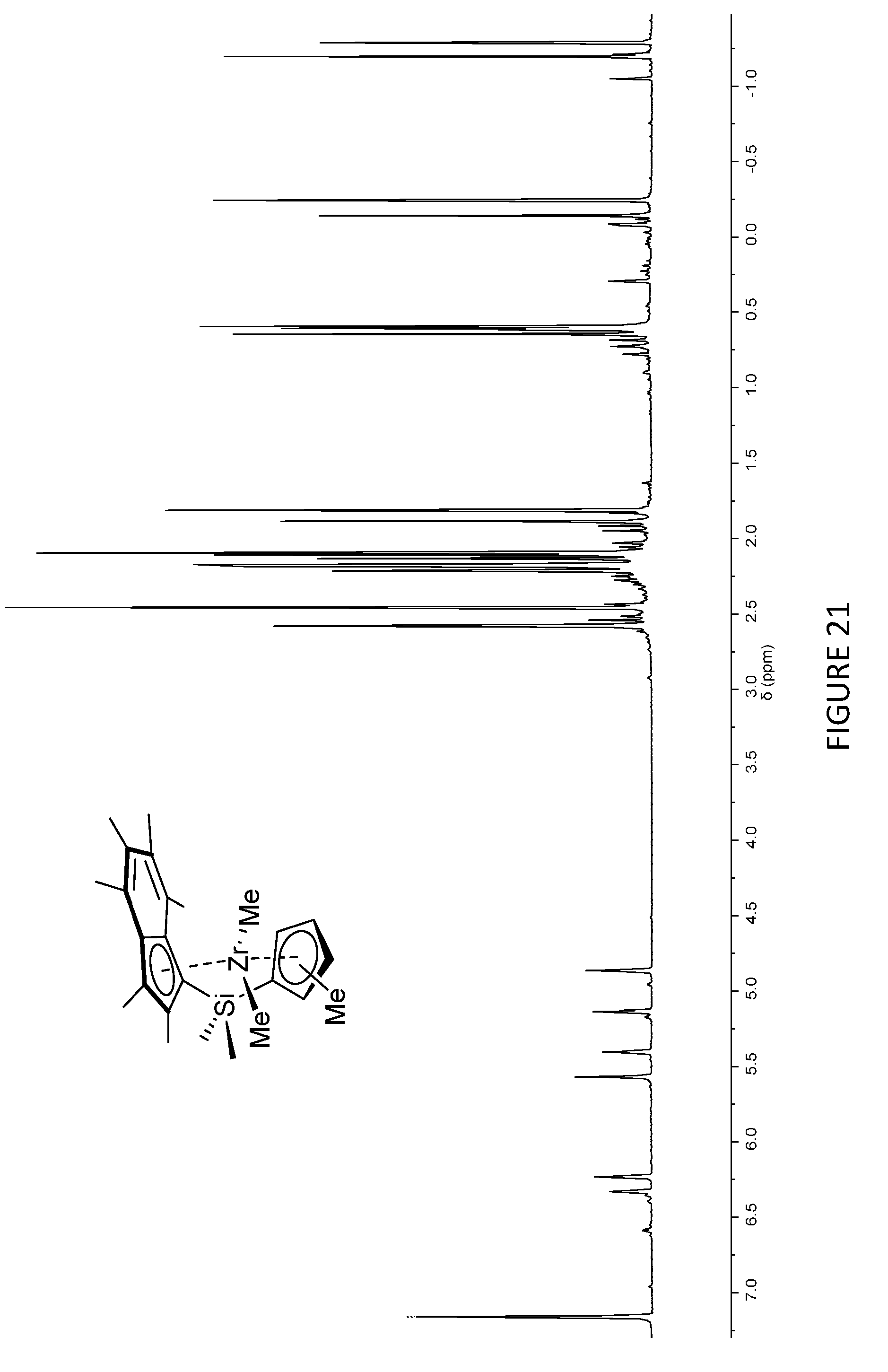
D00022
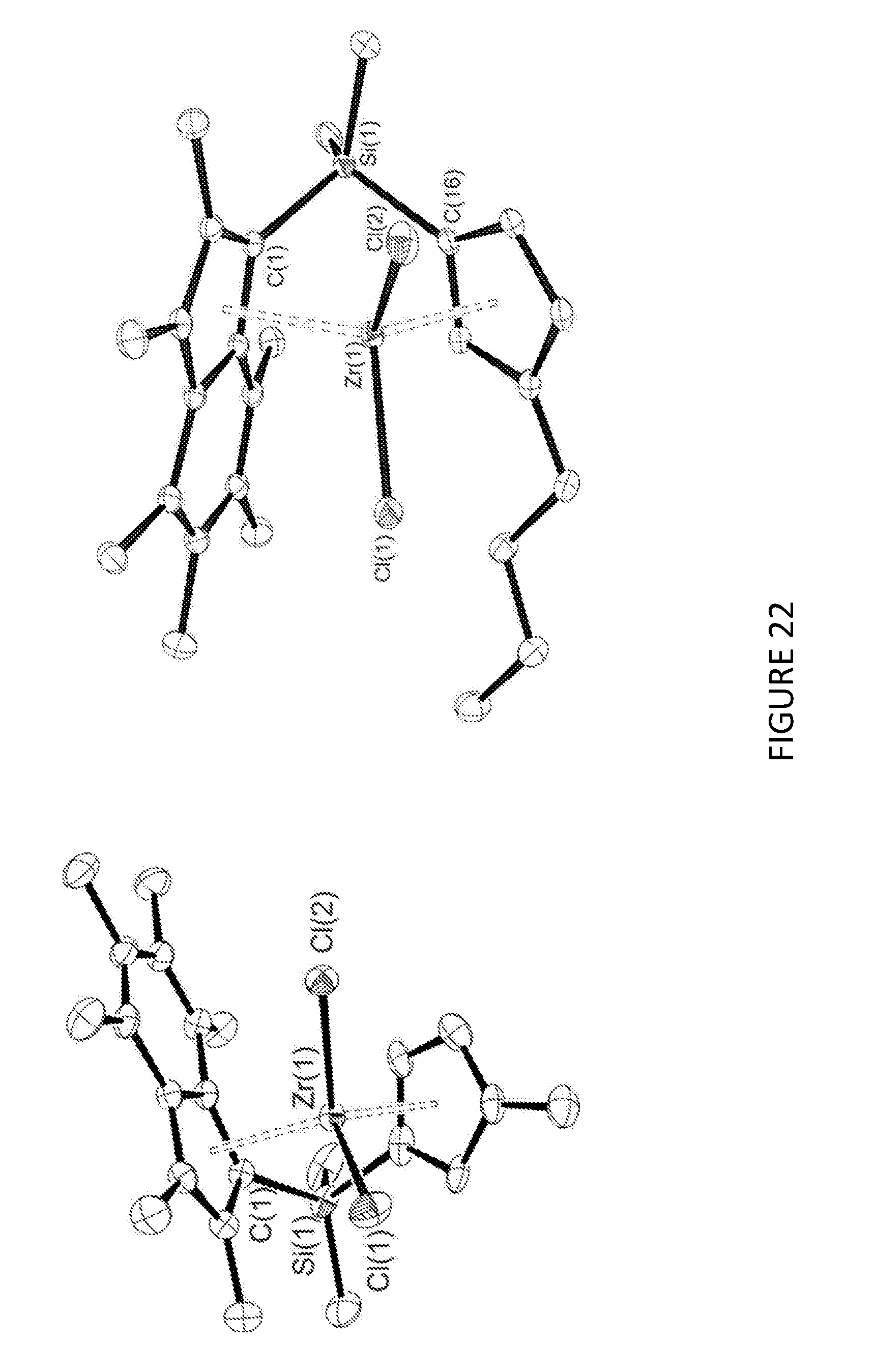
D00023
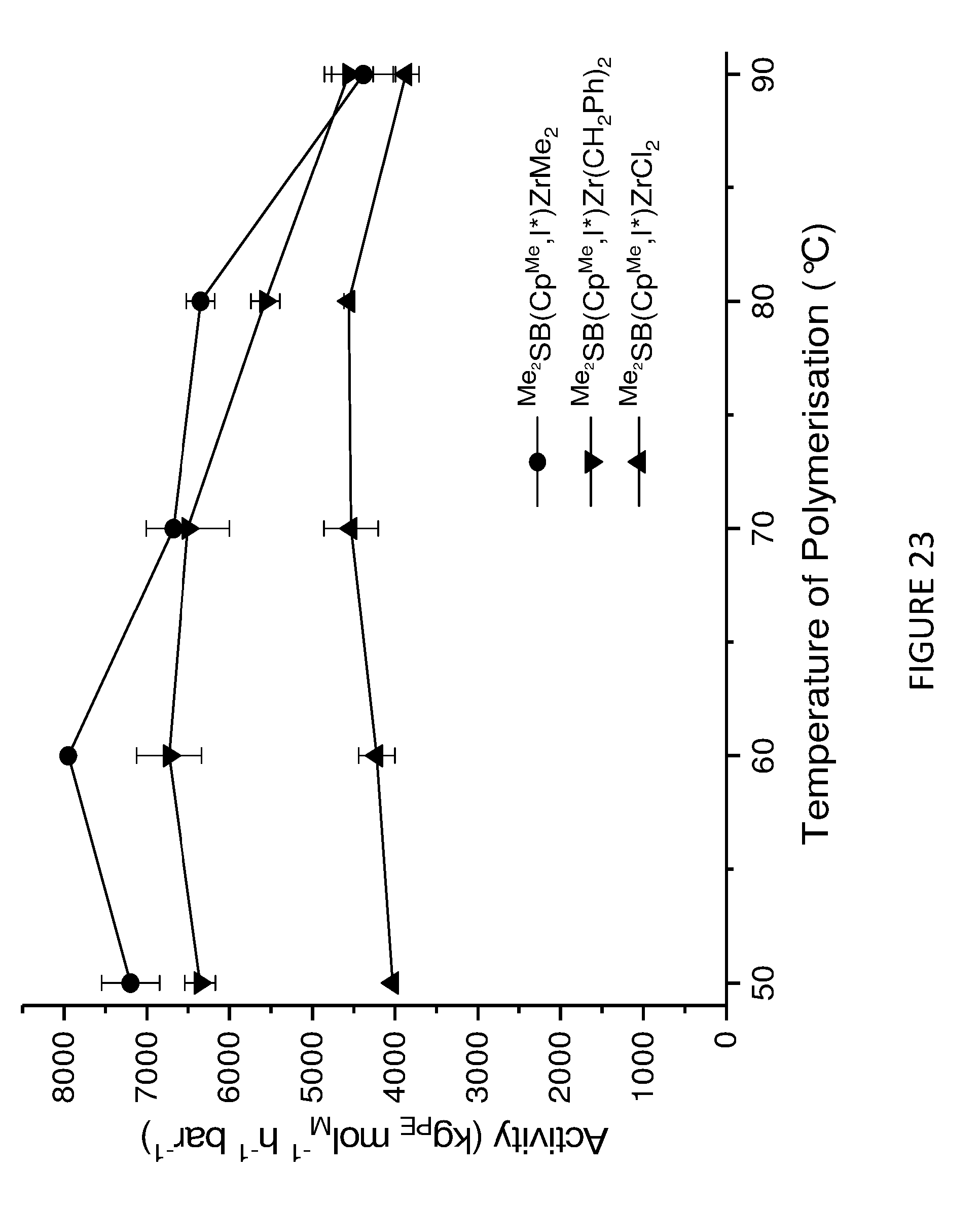
D00024
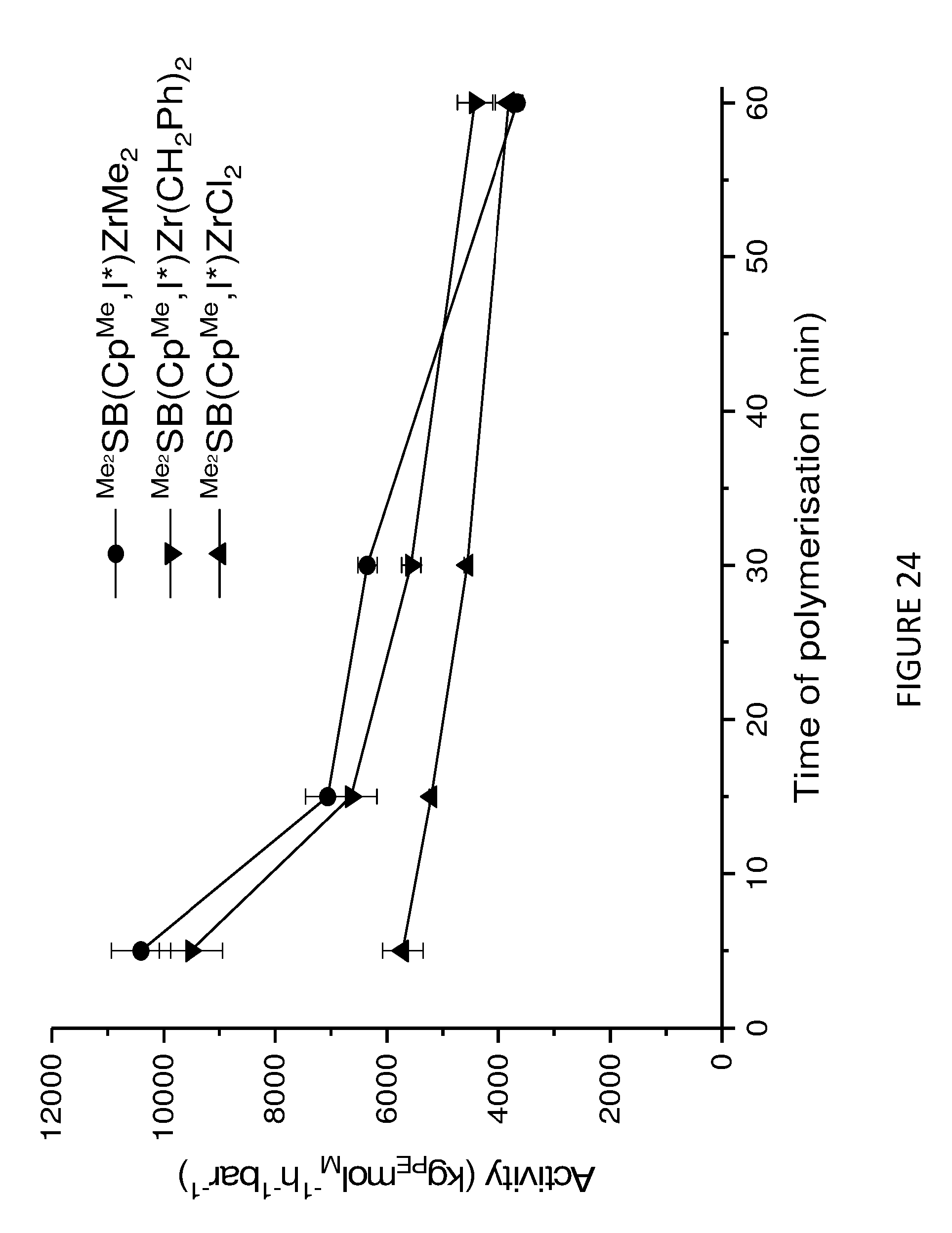
D00025
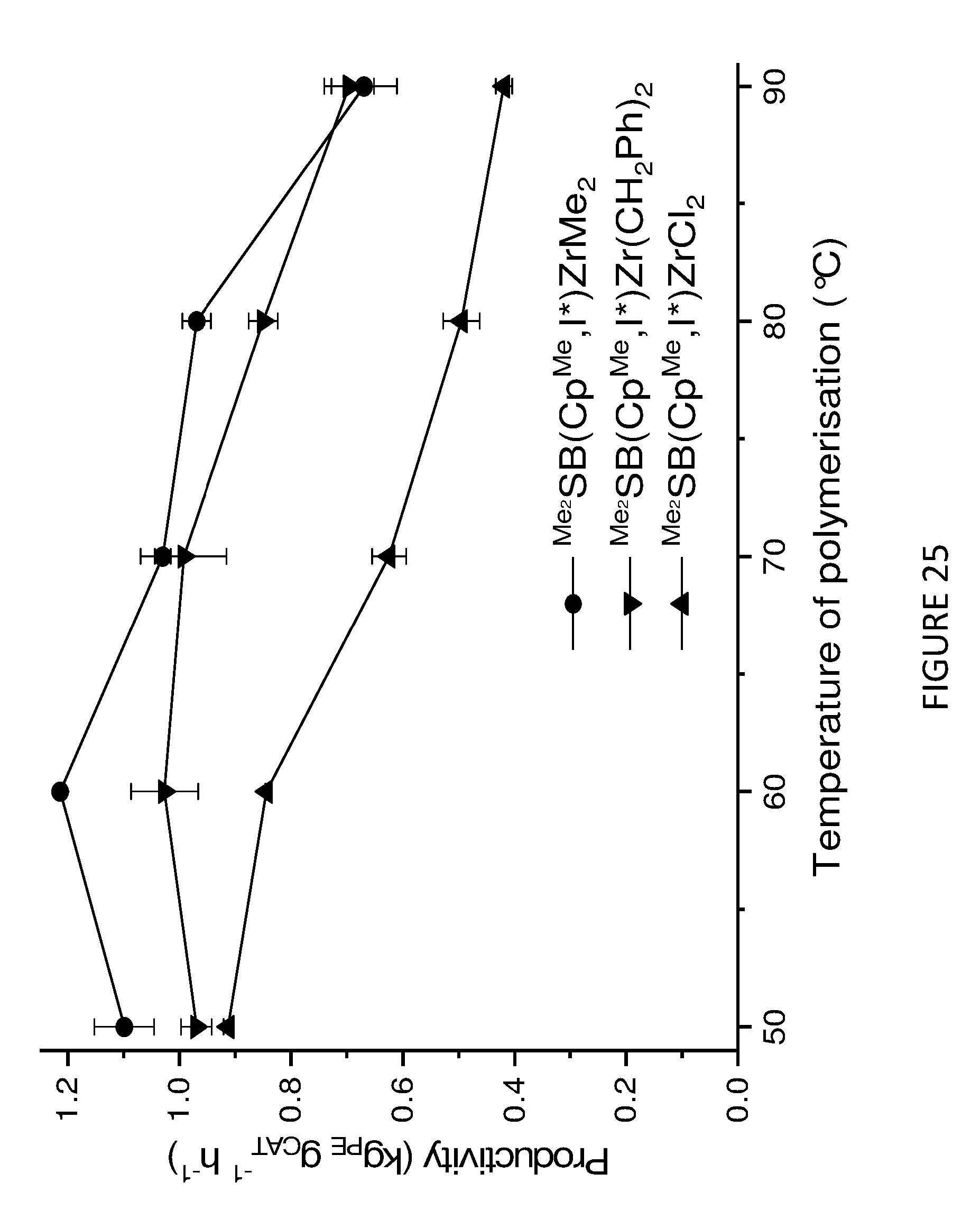
D00026

D00027
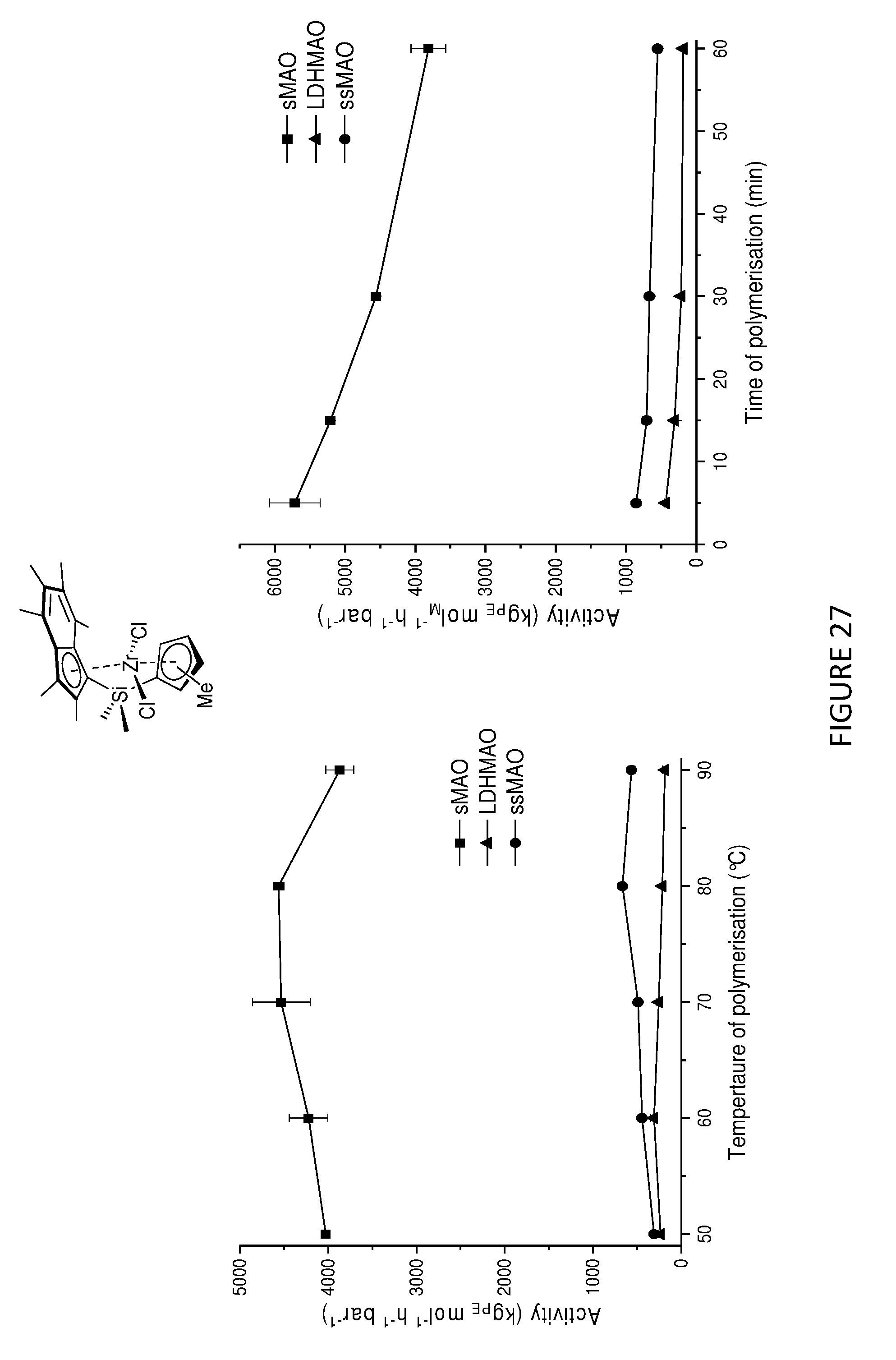
D00028
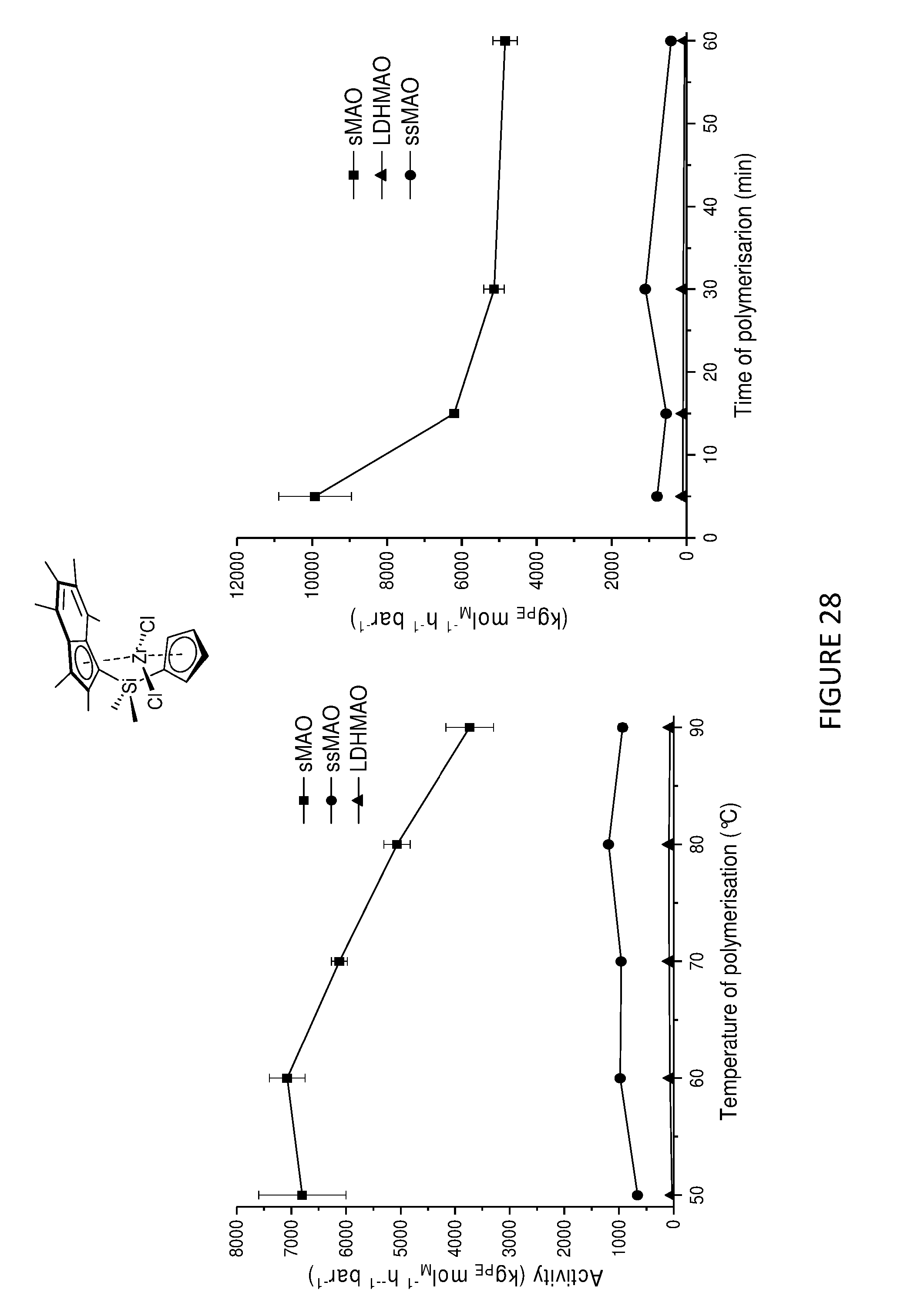
D00029

D00030
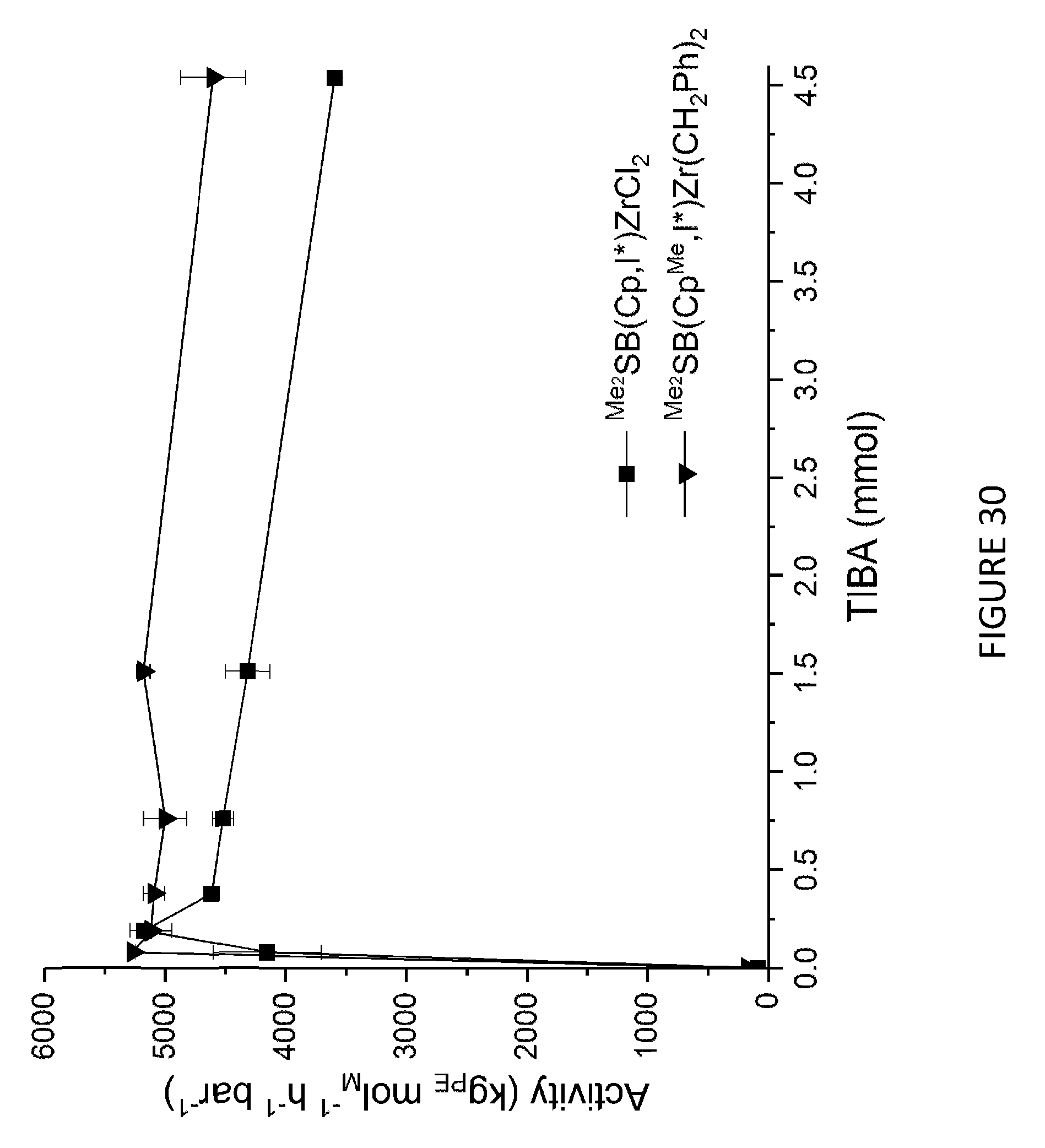
D00031

D00032
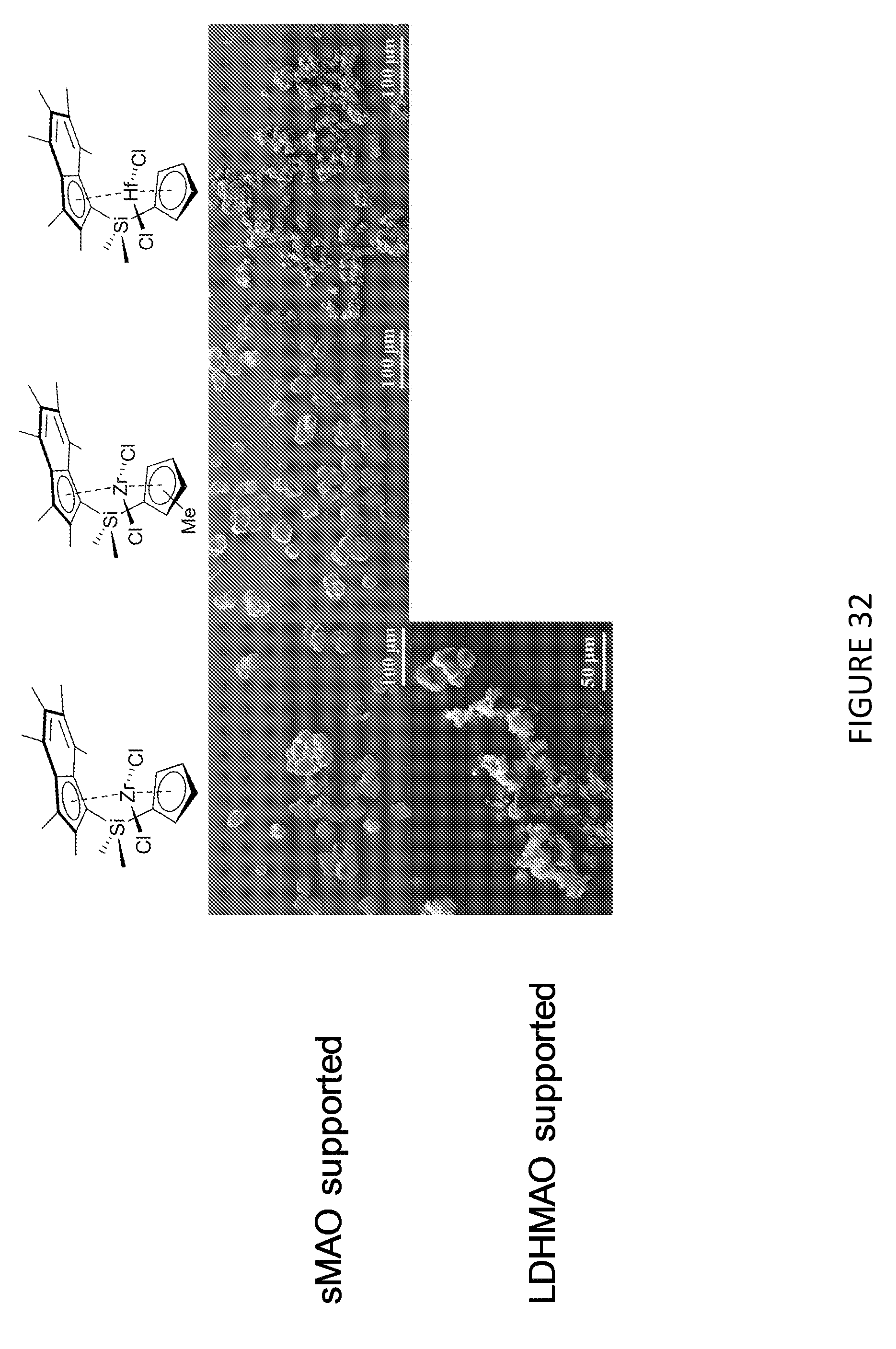
D00033
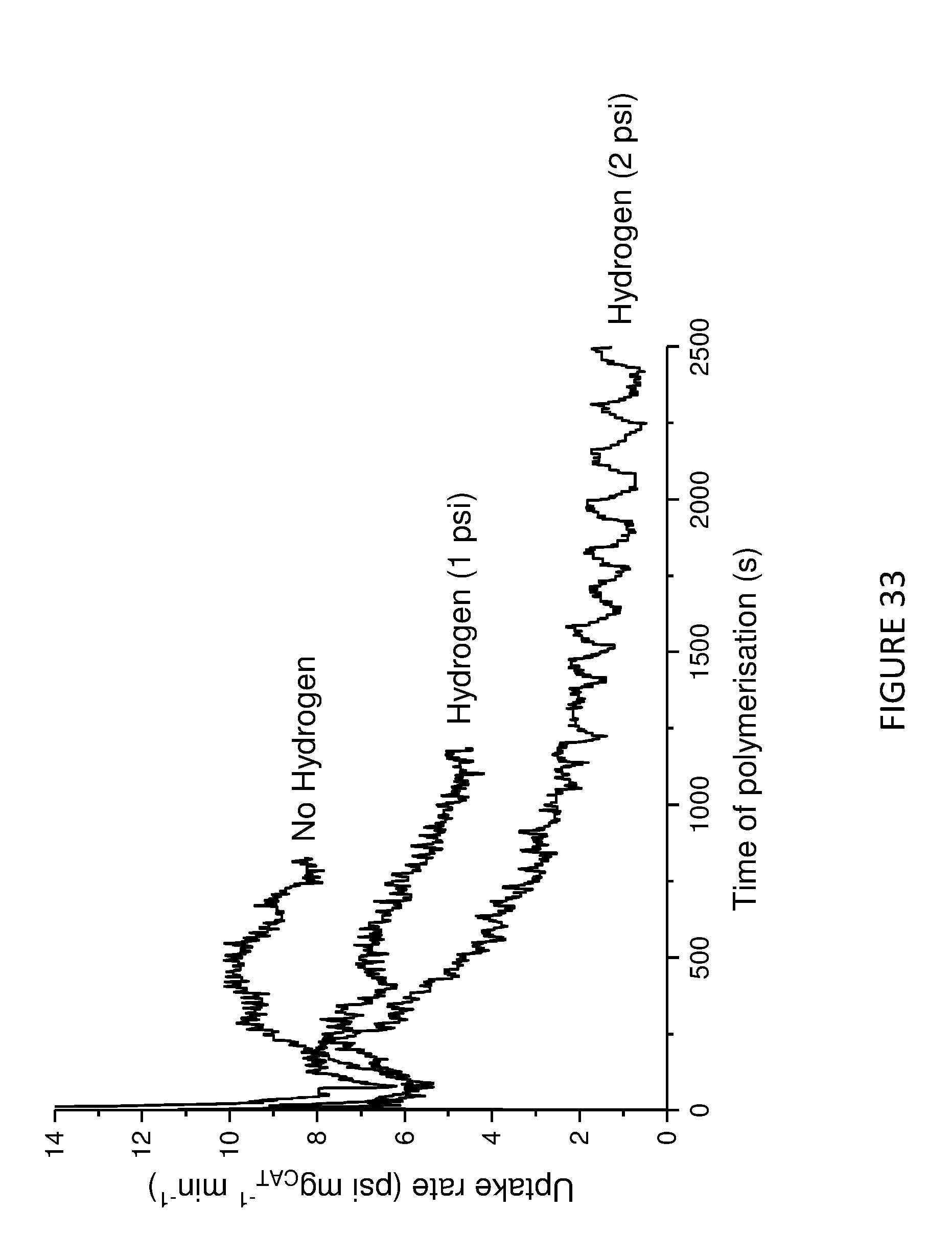
D00034
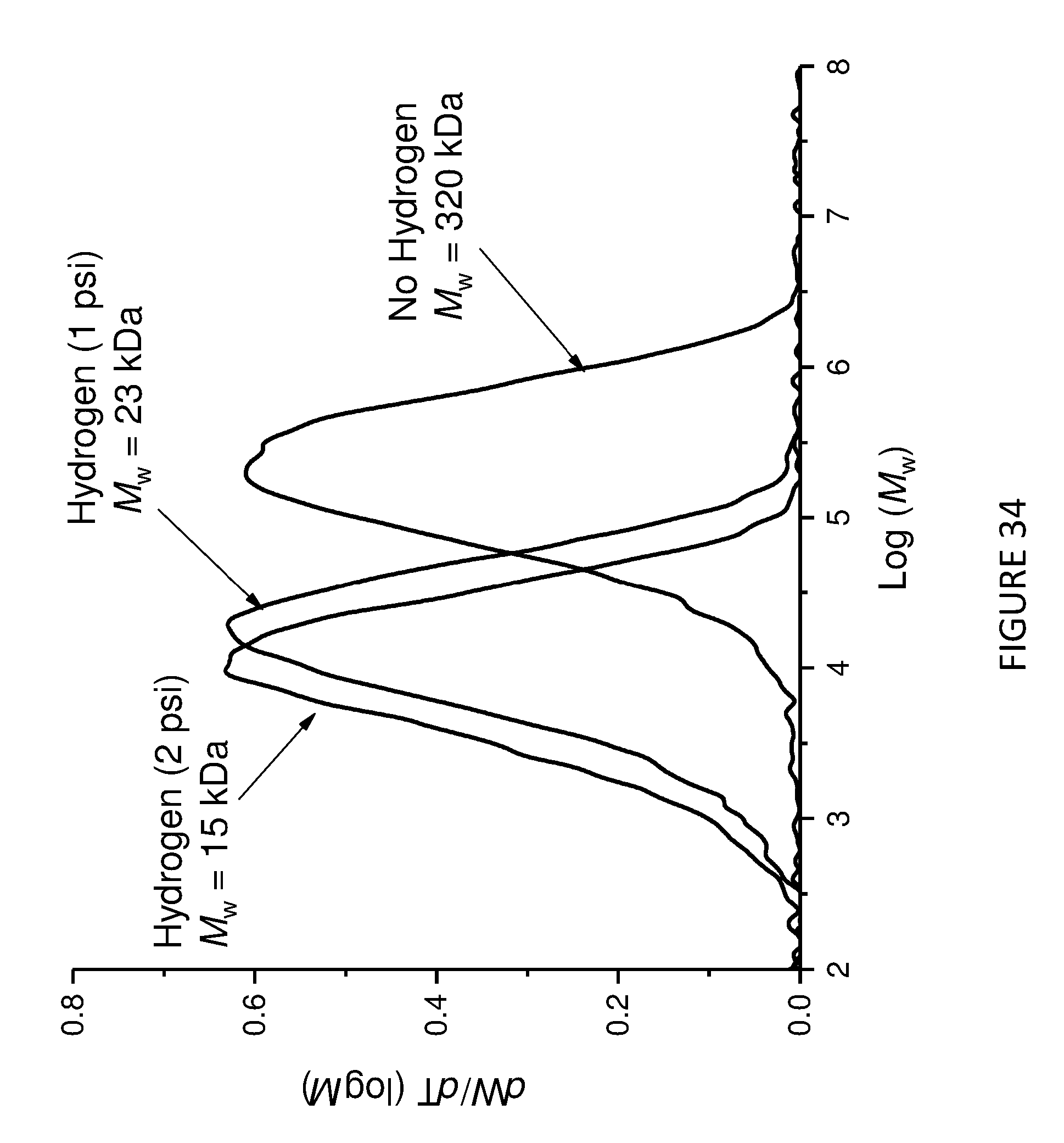
D00035
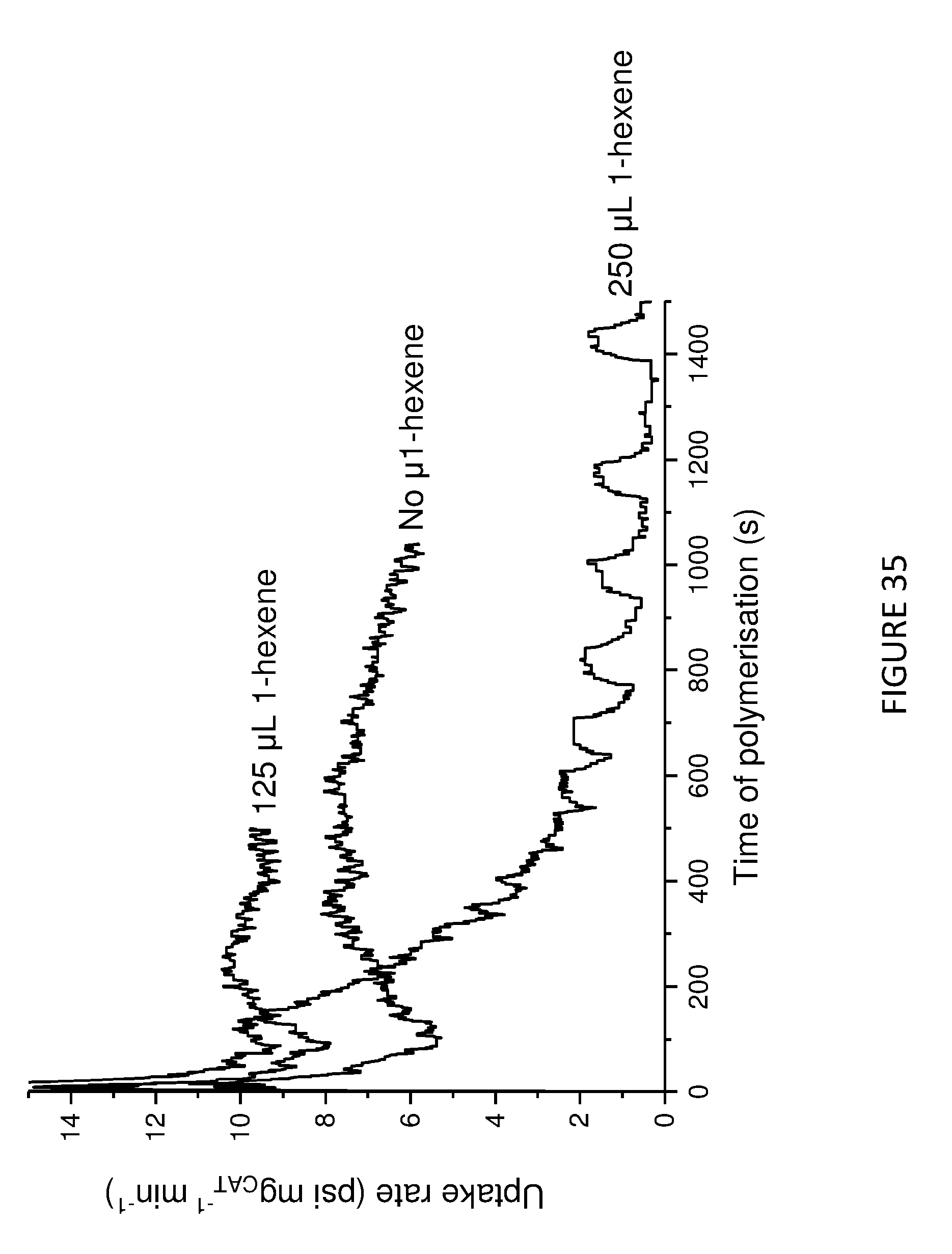
D00036
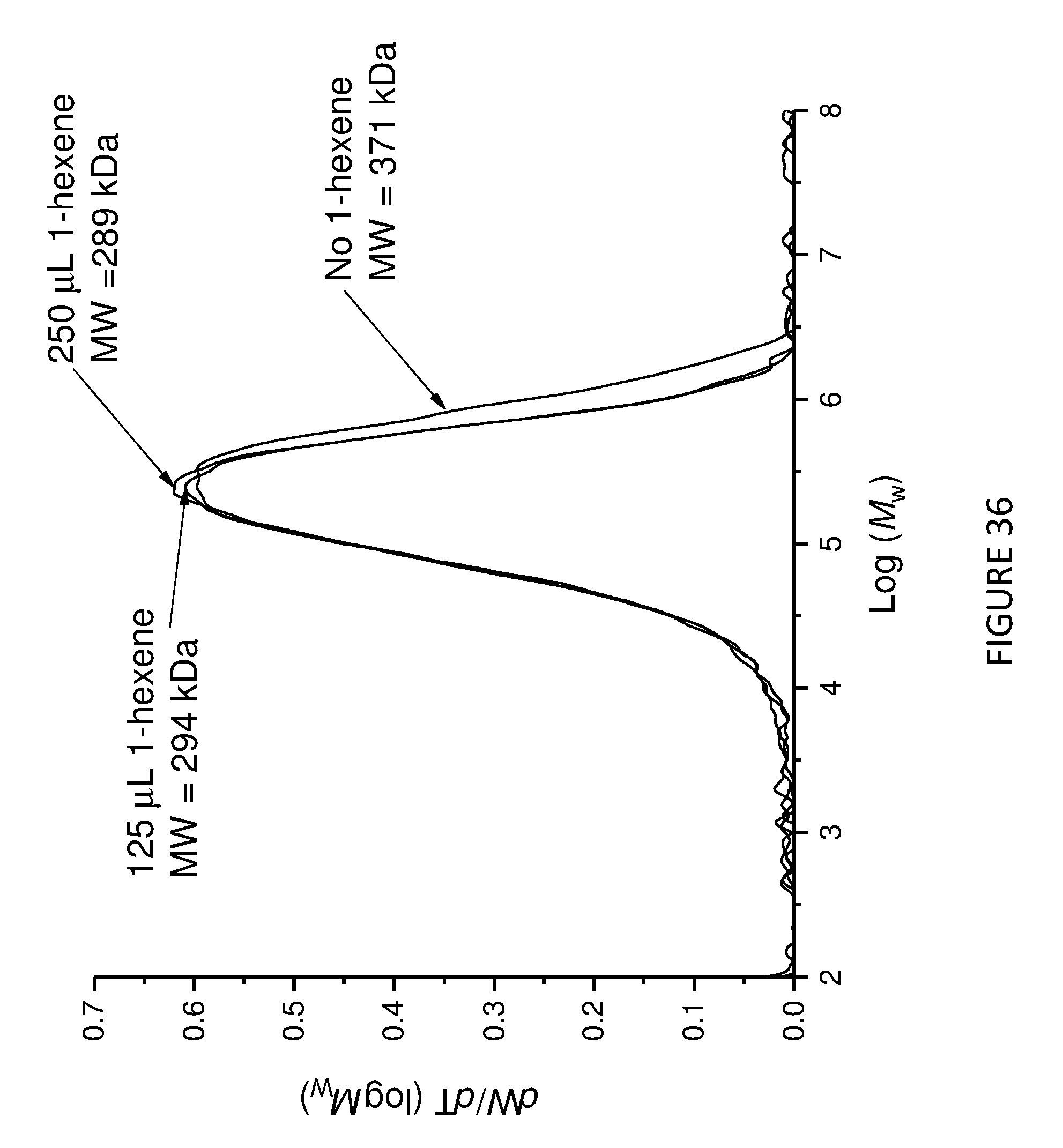
D00037
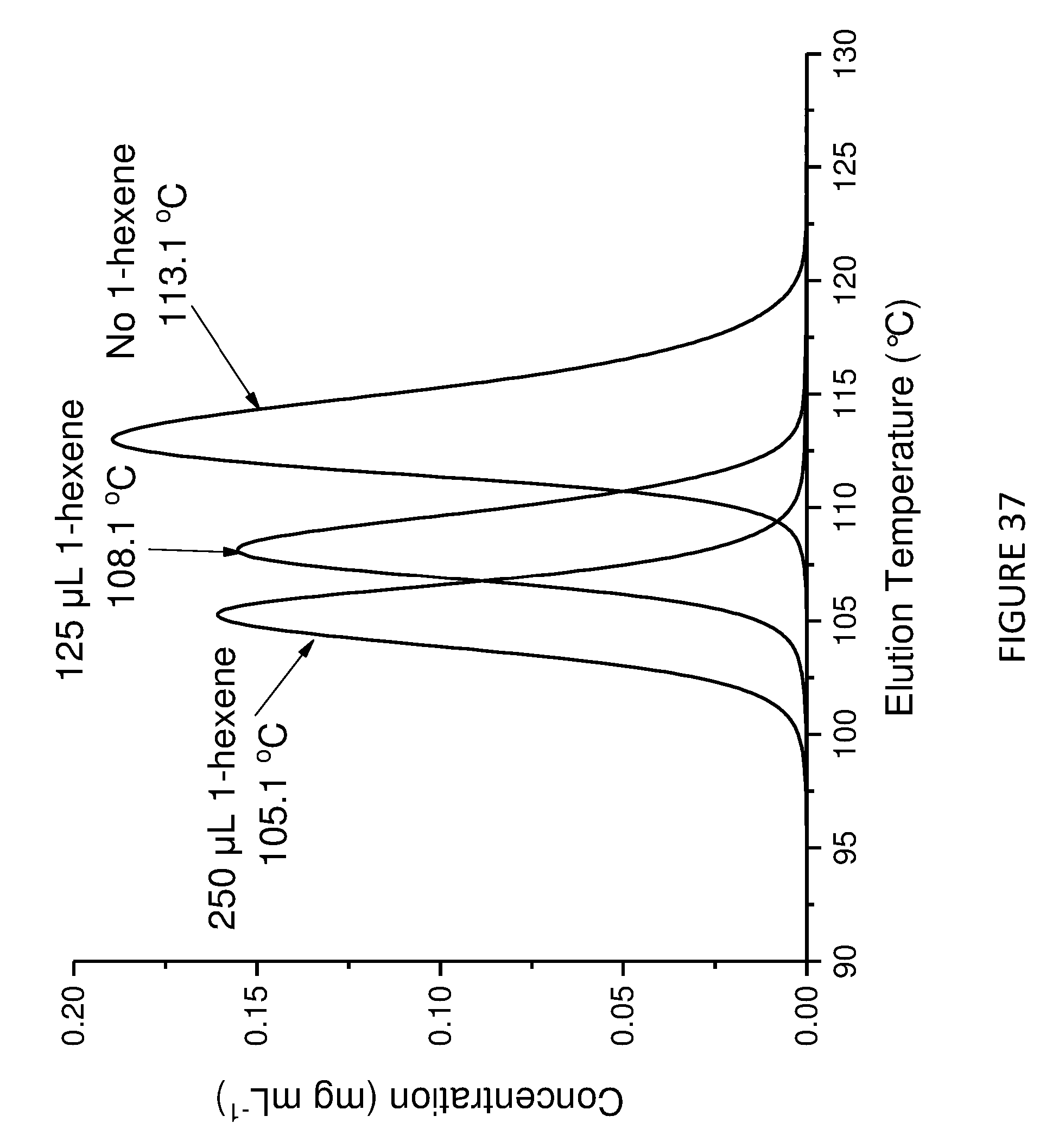
D00038
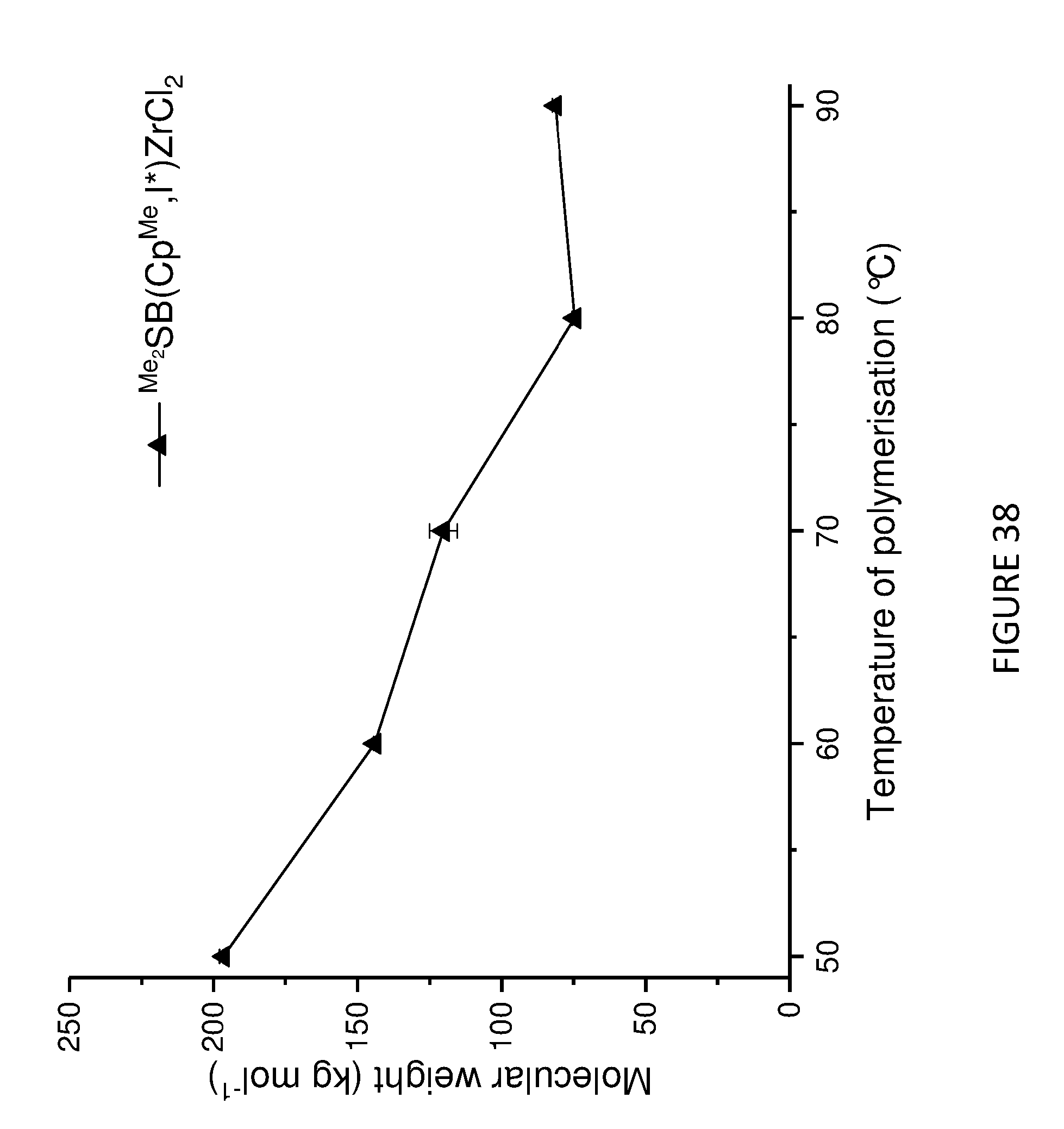
XML
uspto.report is an independent third-party trademark research tool that is not affiliated, endorsed, or sponsored by the United States Patent and Trademark Office (USPTO) or any other governmental organization. The information provided by uspto.report is based on publicly available data at the time of writing and is intended for informational purposes only.
While we strive to provide accurate and up-to-date information, we do not guarantee the accuracy, completeness, reliability, or suitability of the information displayed on this site. The use of this site is at your own risk. Any reliance you place on such information is therefore strictly at your own risk.
All official trademark data, including owner information, should be verified by visiting the official USPTO website at www.uspto.gov. This site is not intended to replace professional legal advice and should not be used as a substitute for consulting with a legal professional who is knowledgeable about trademark law.